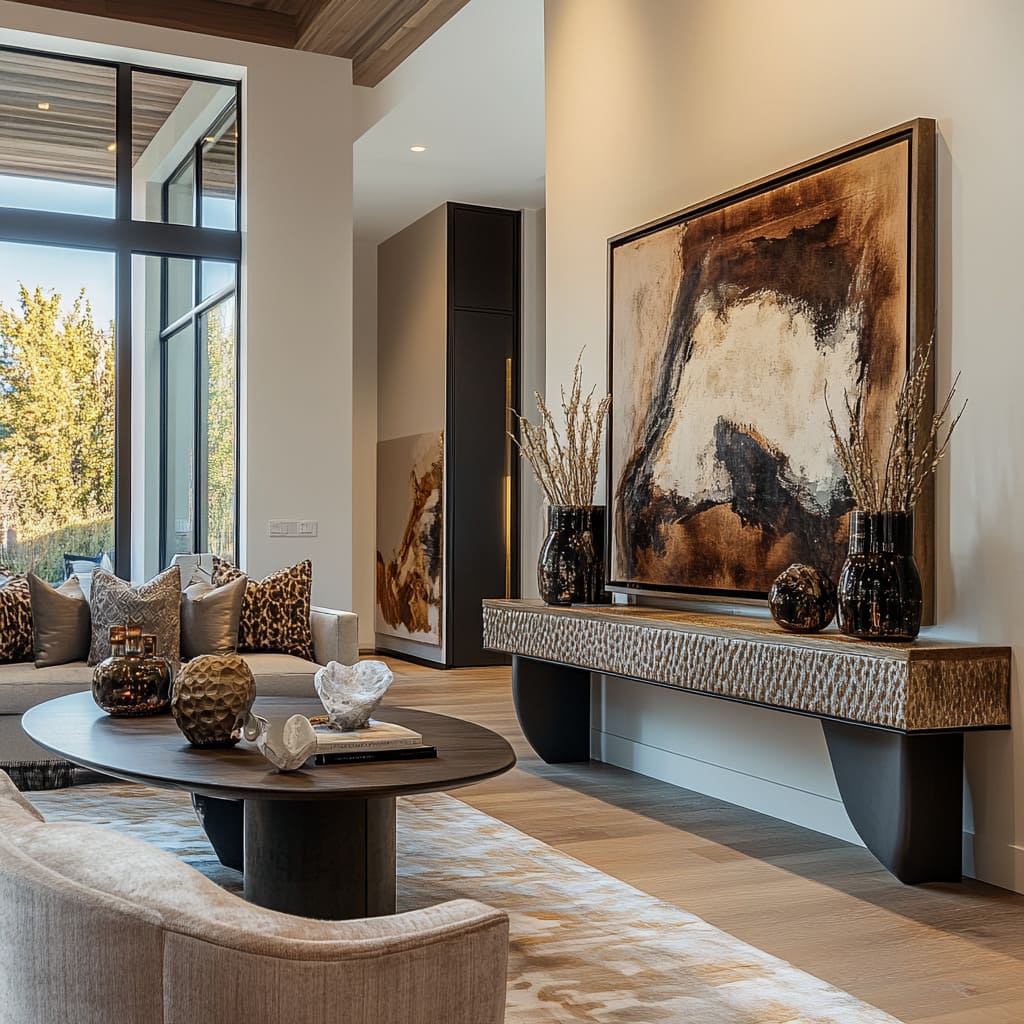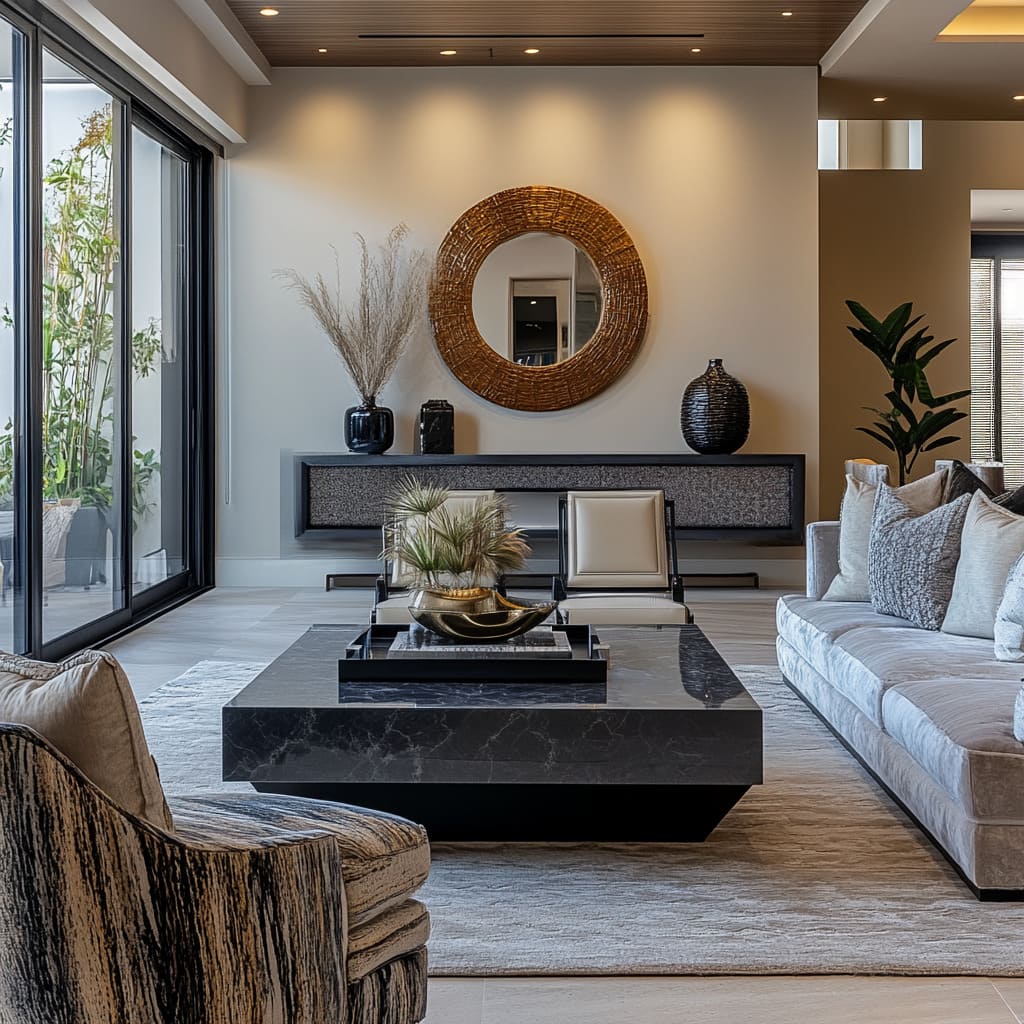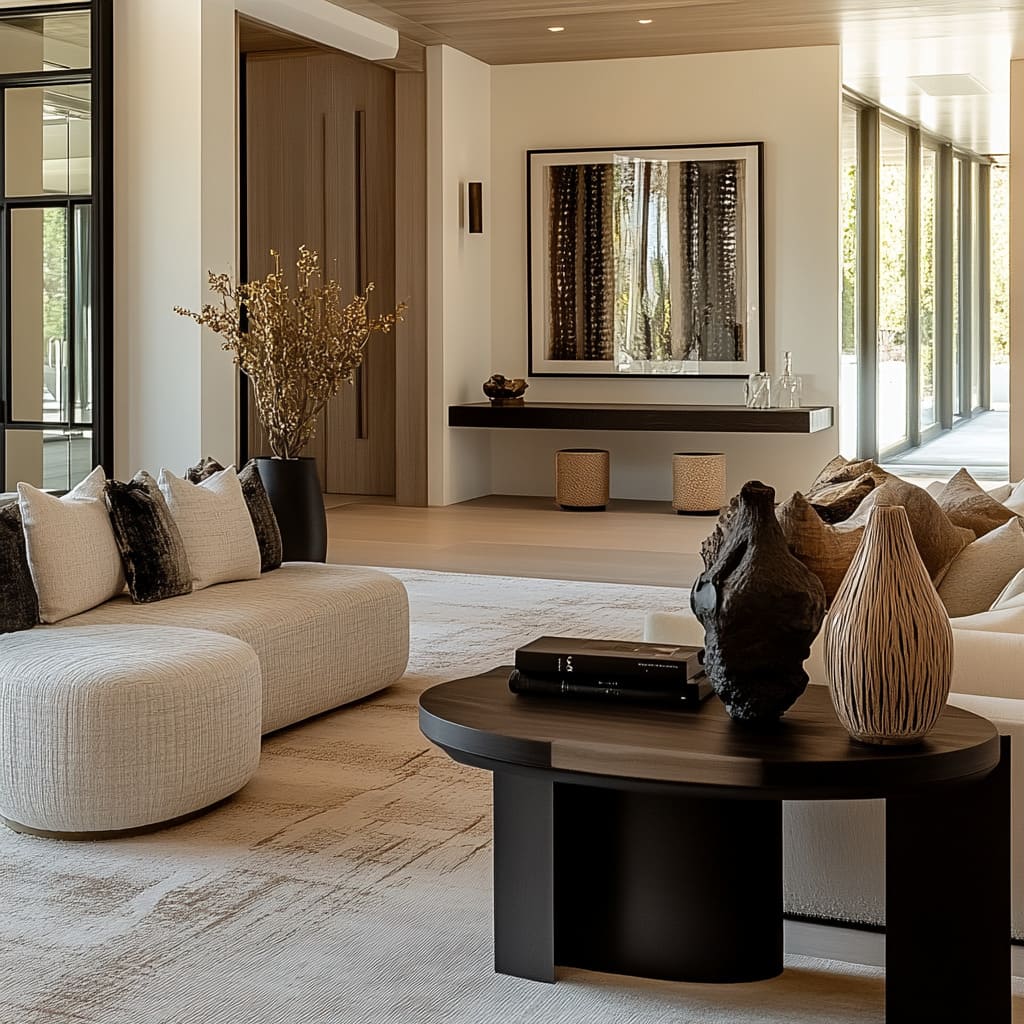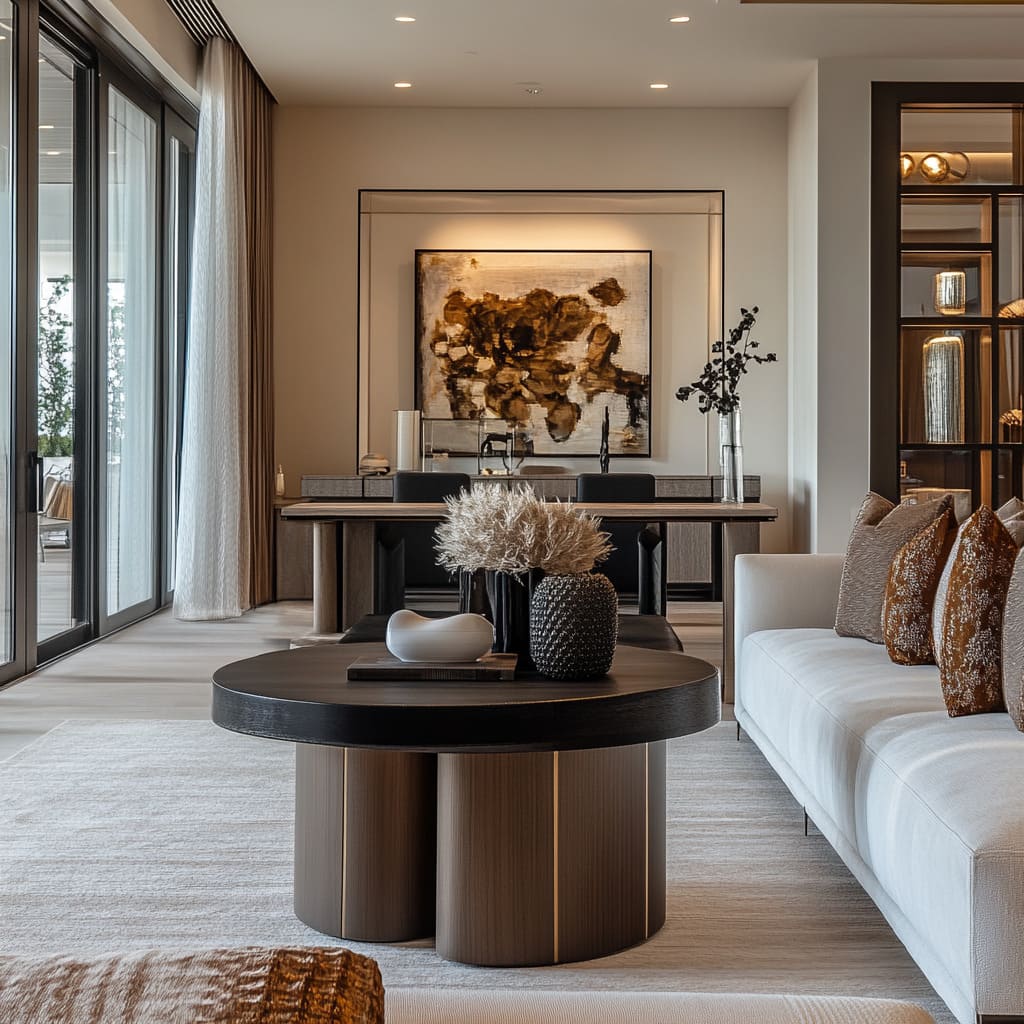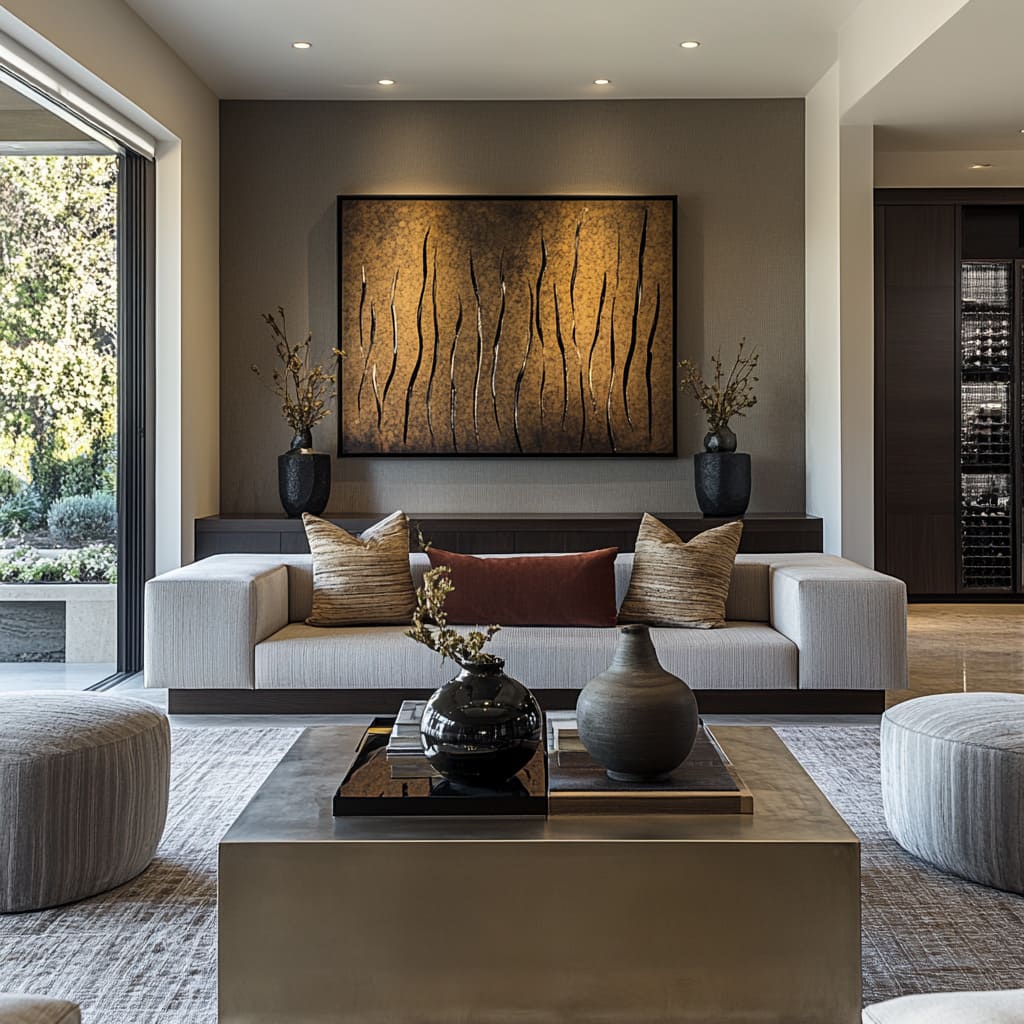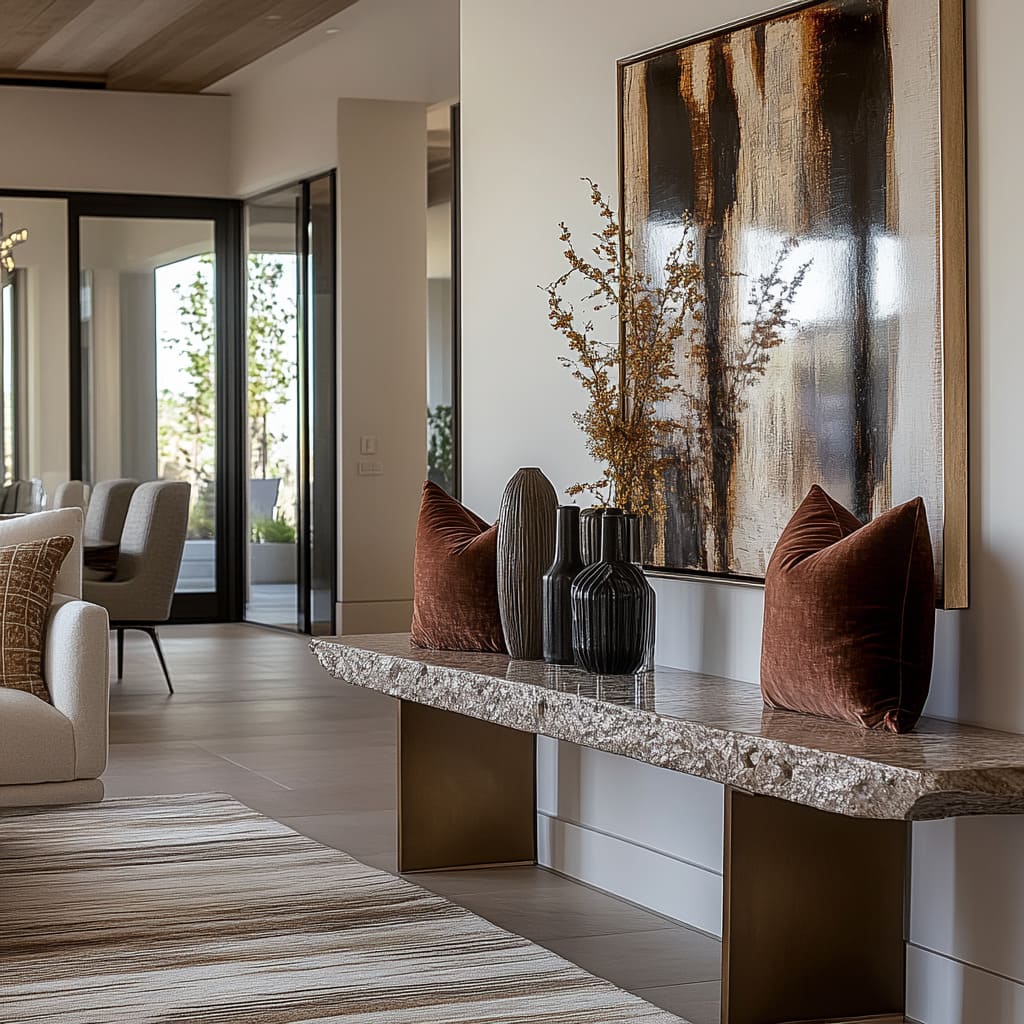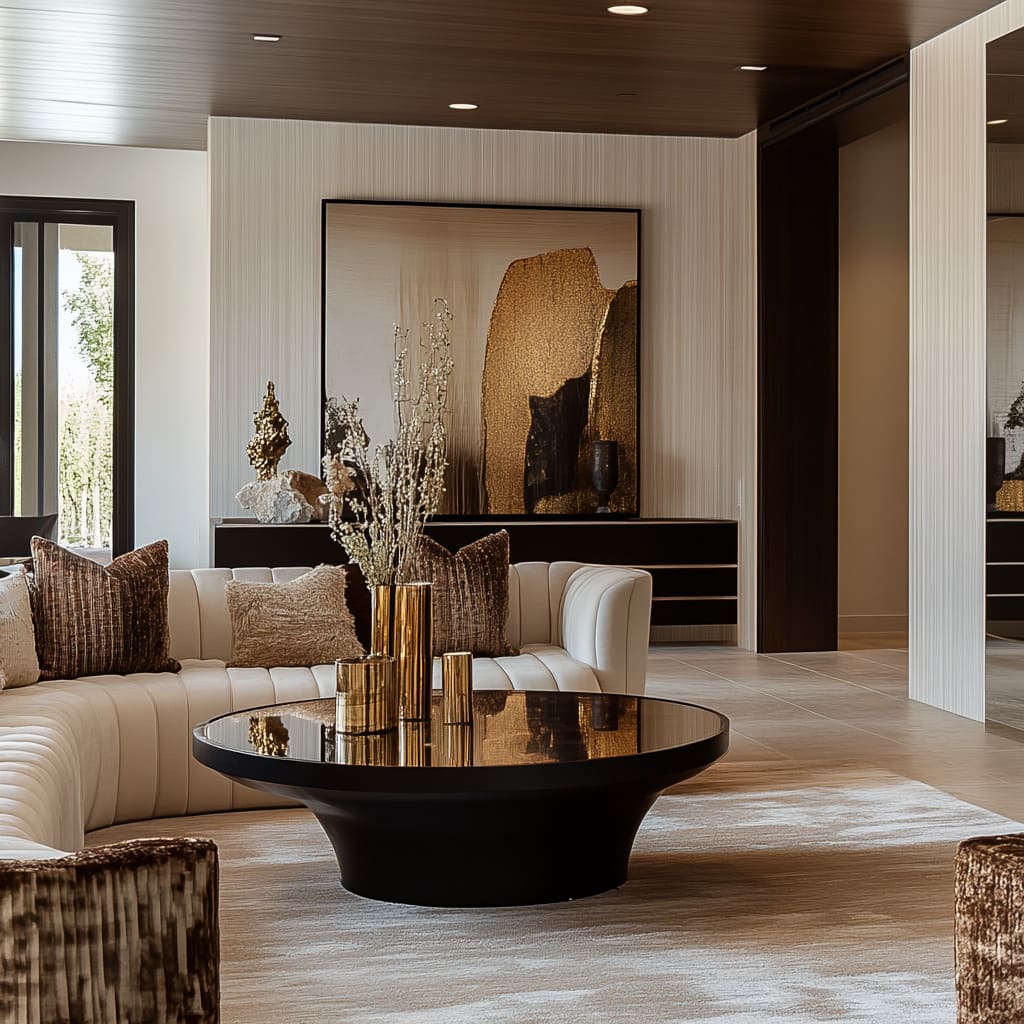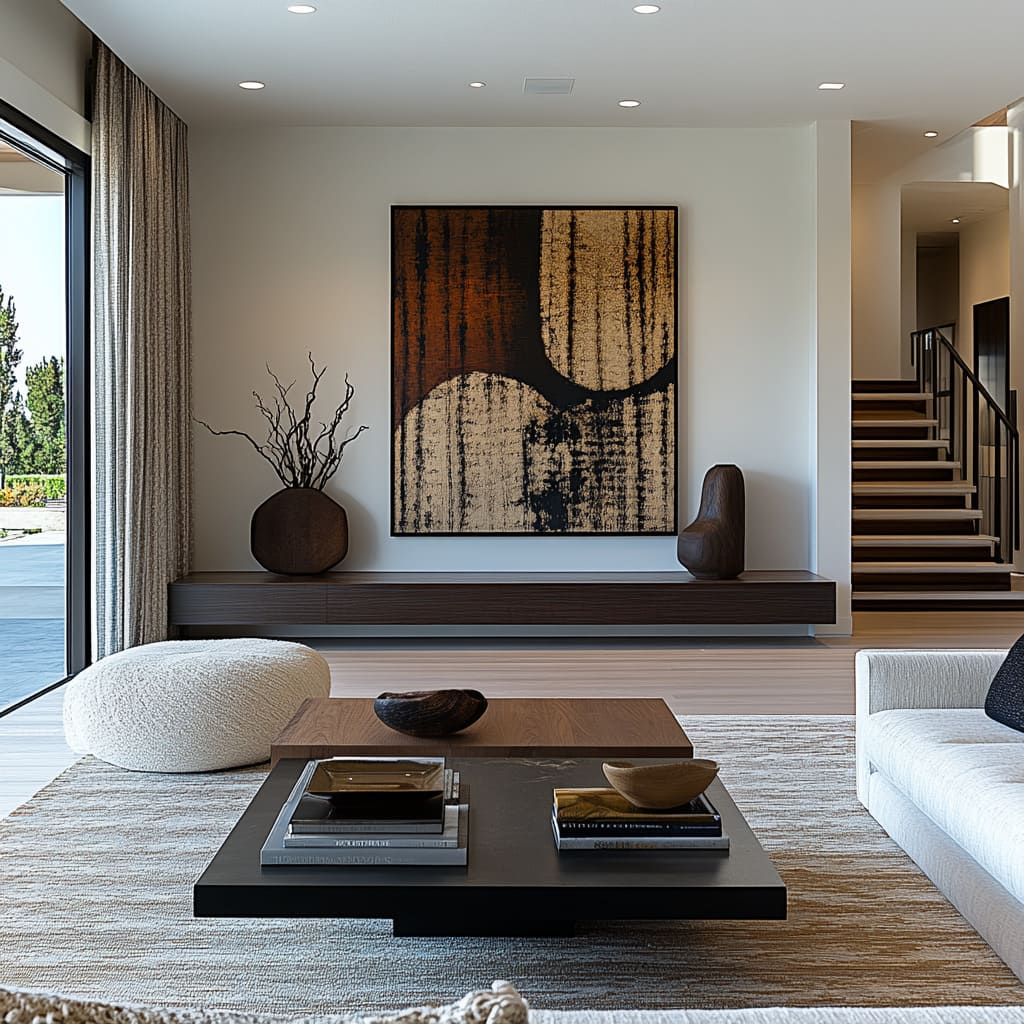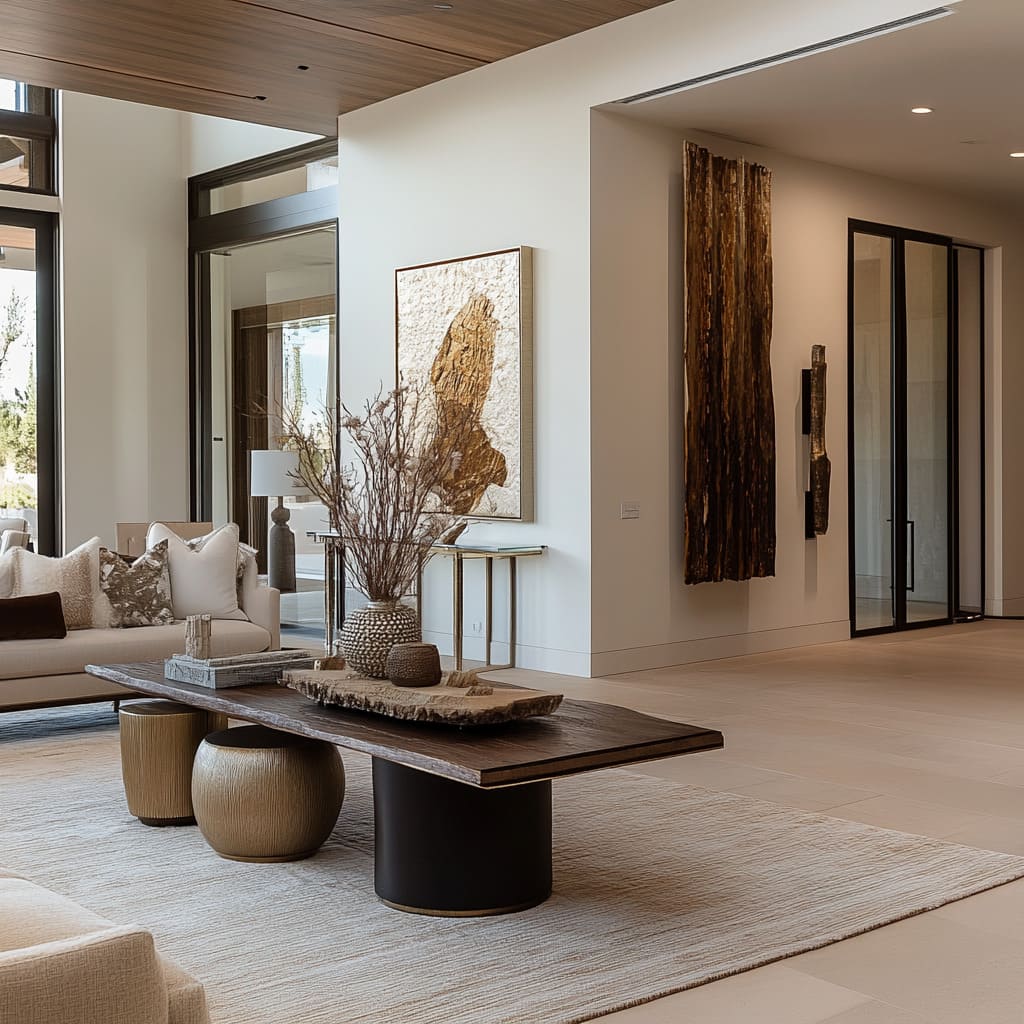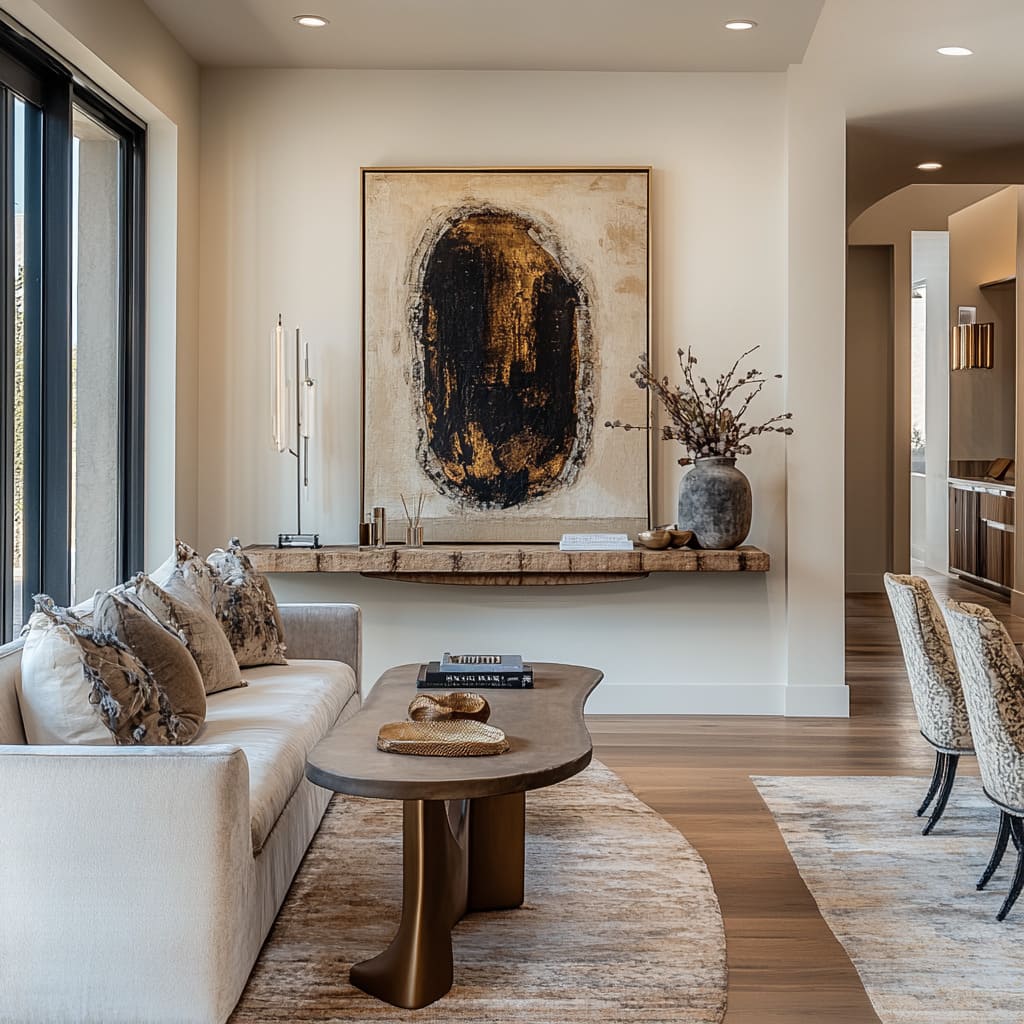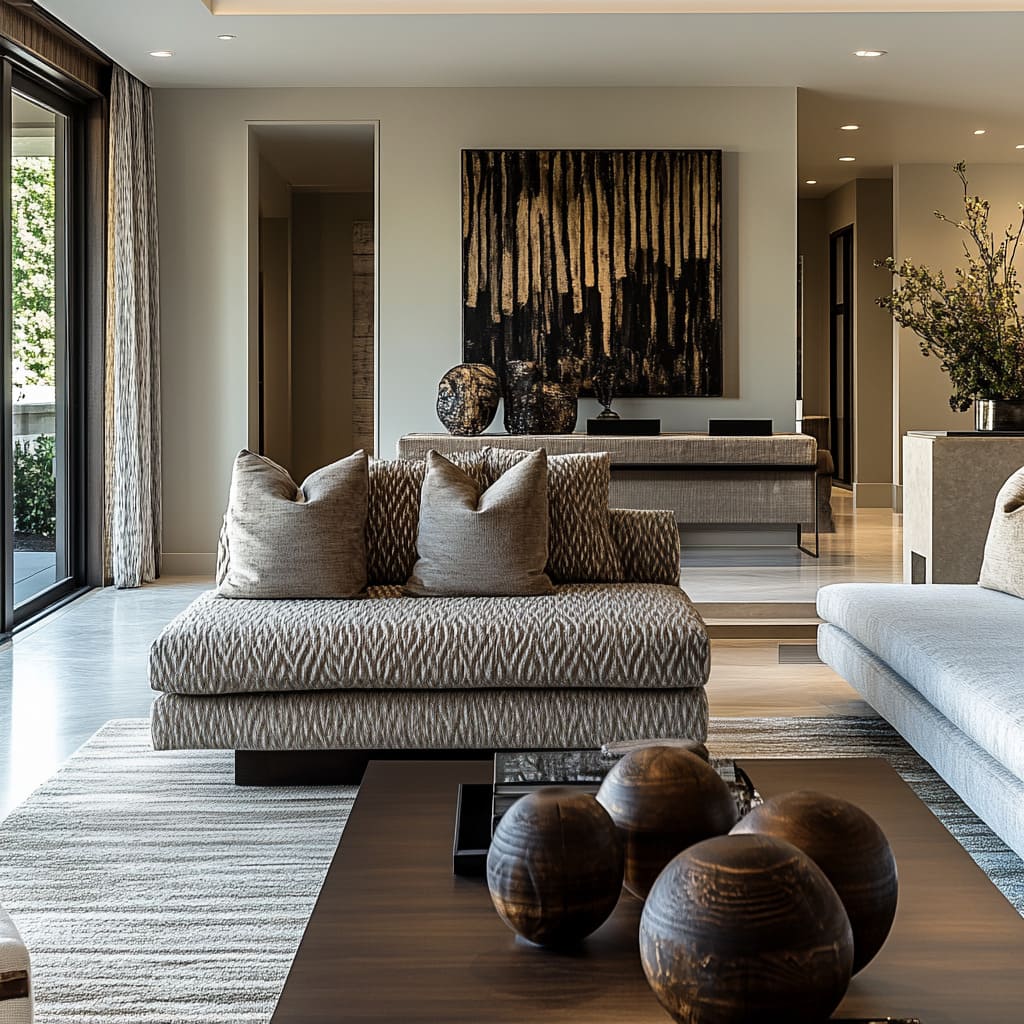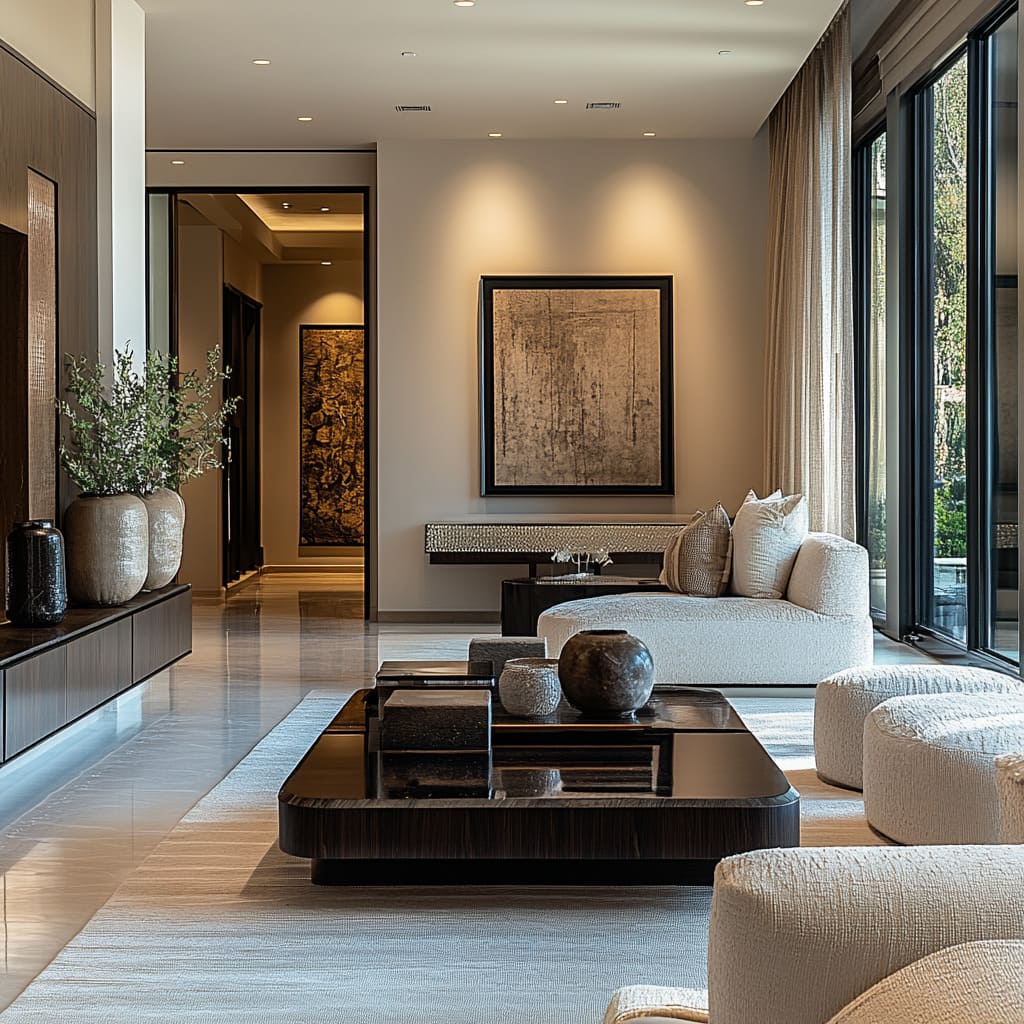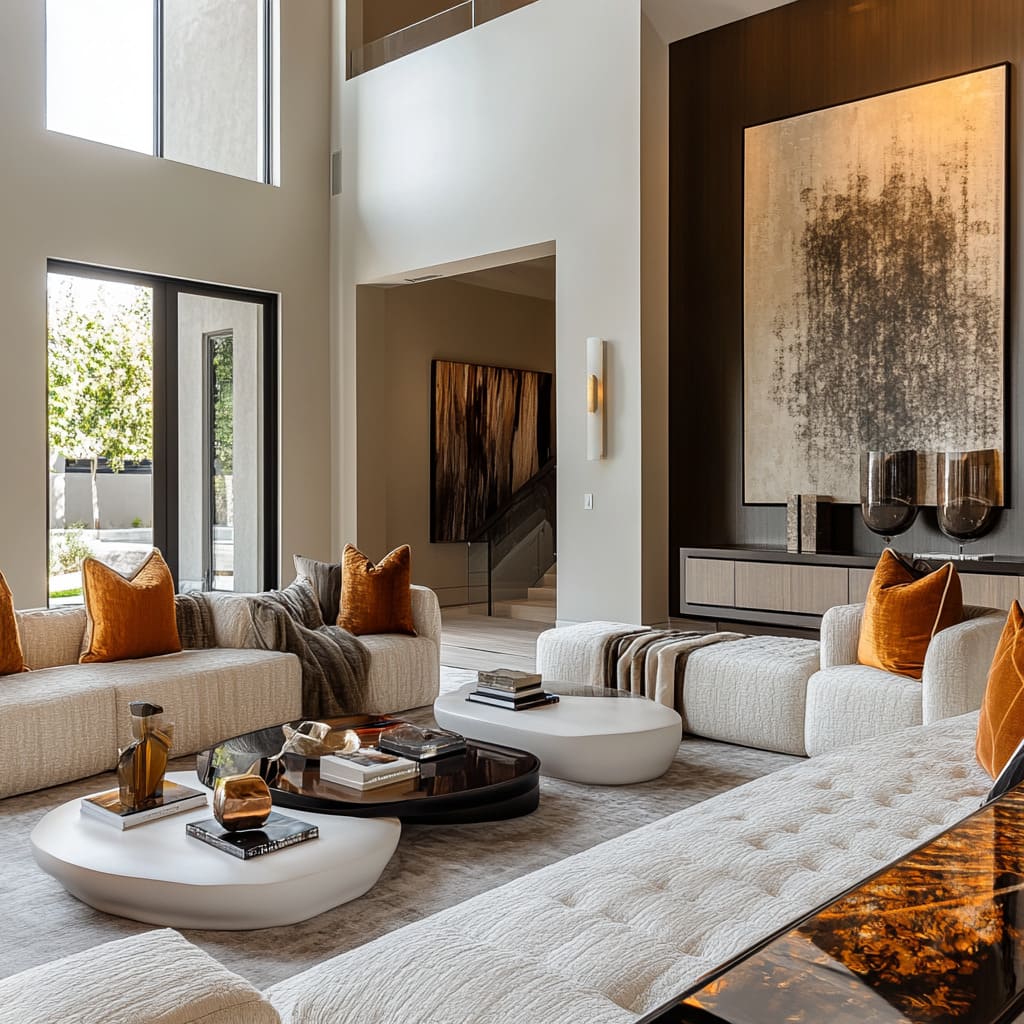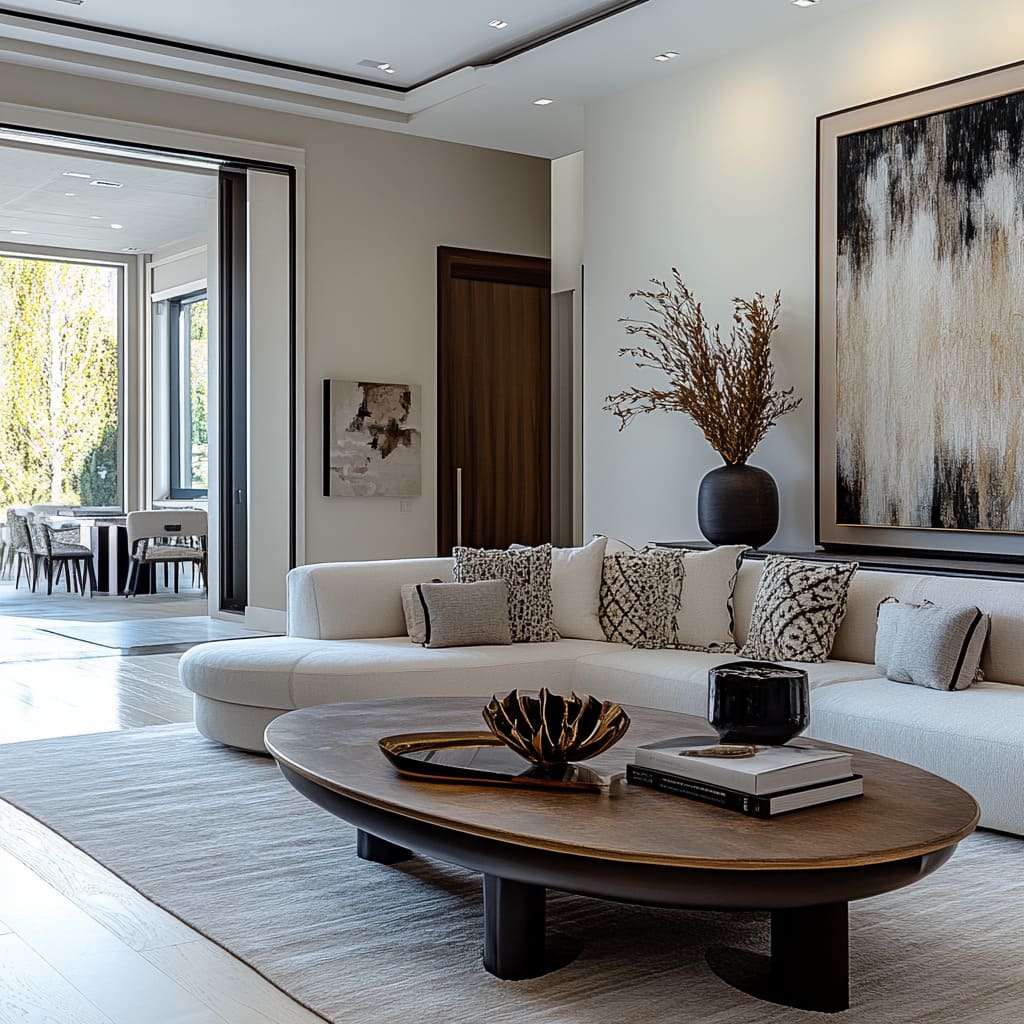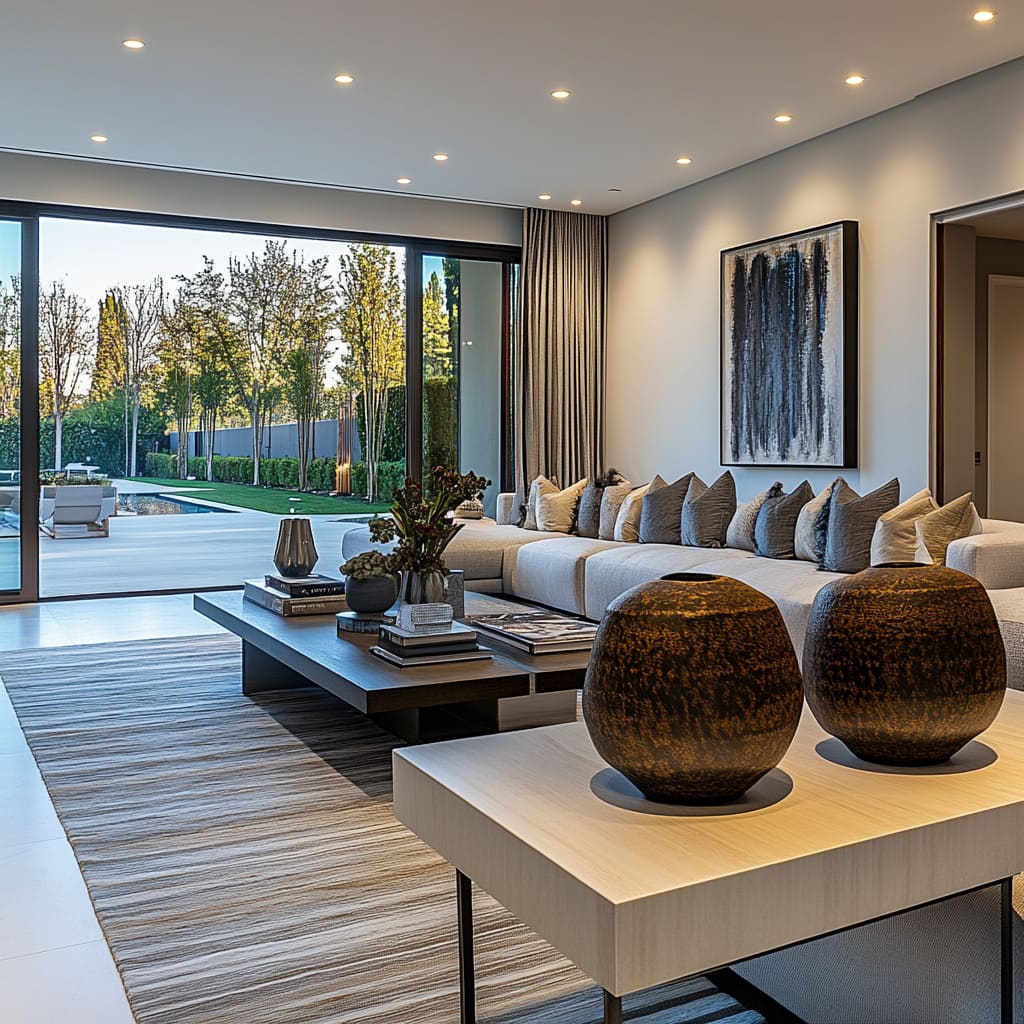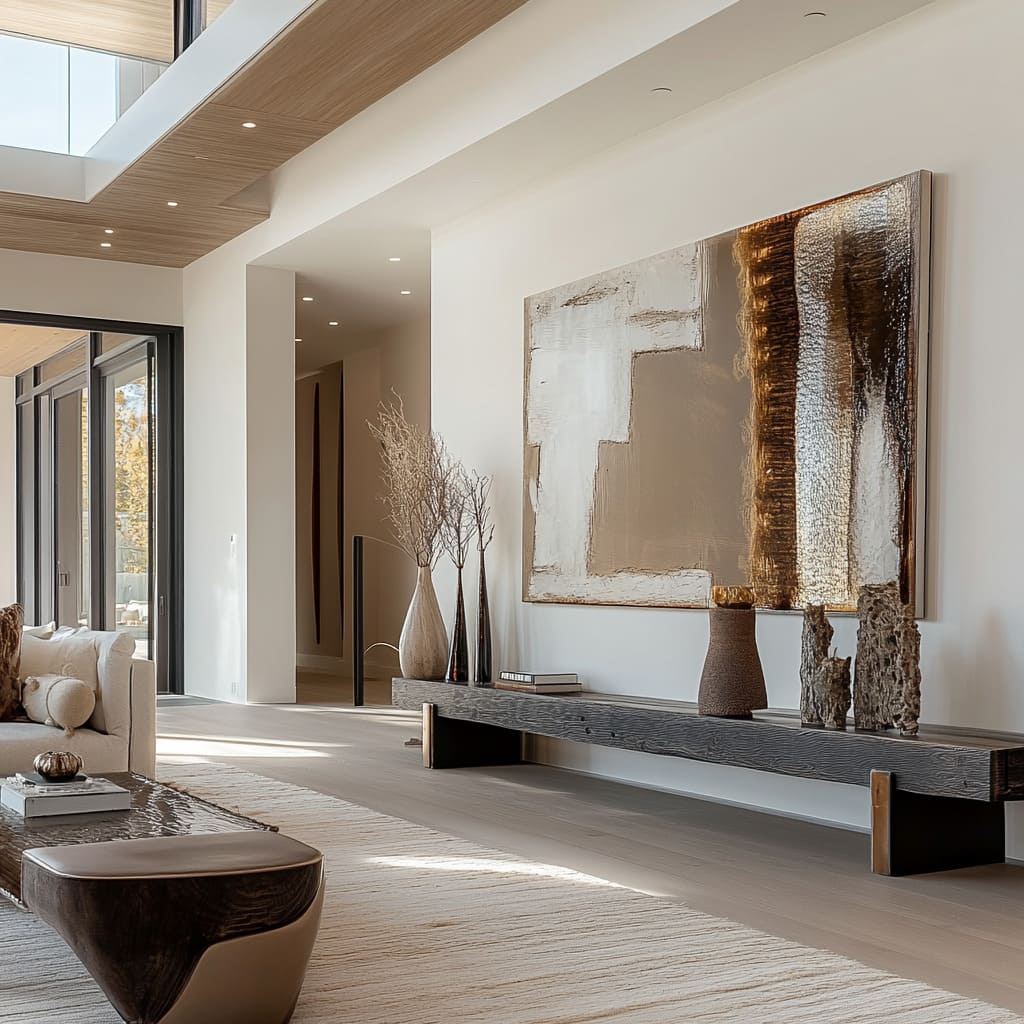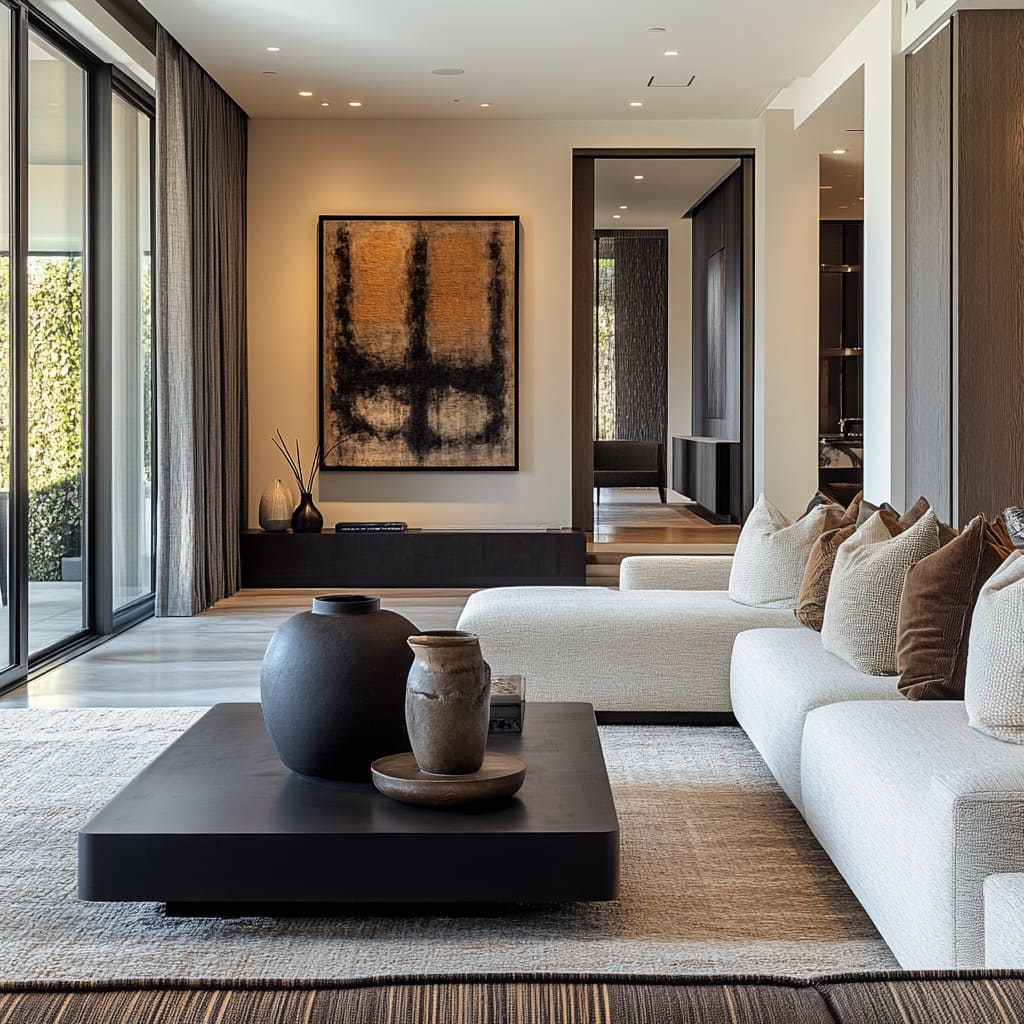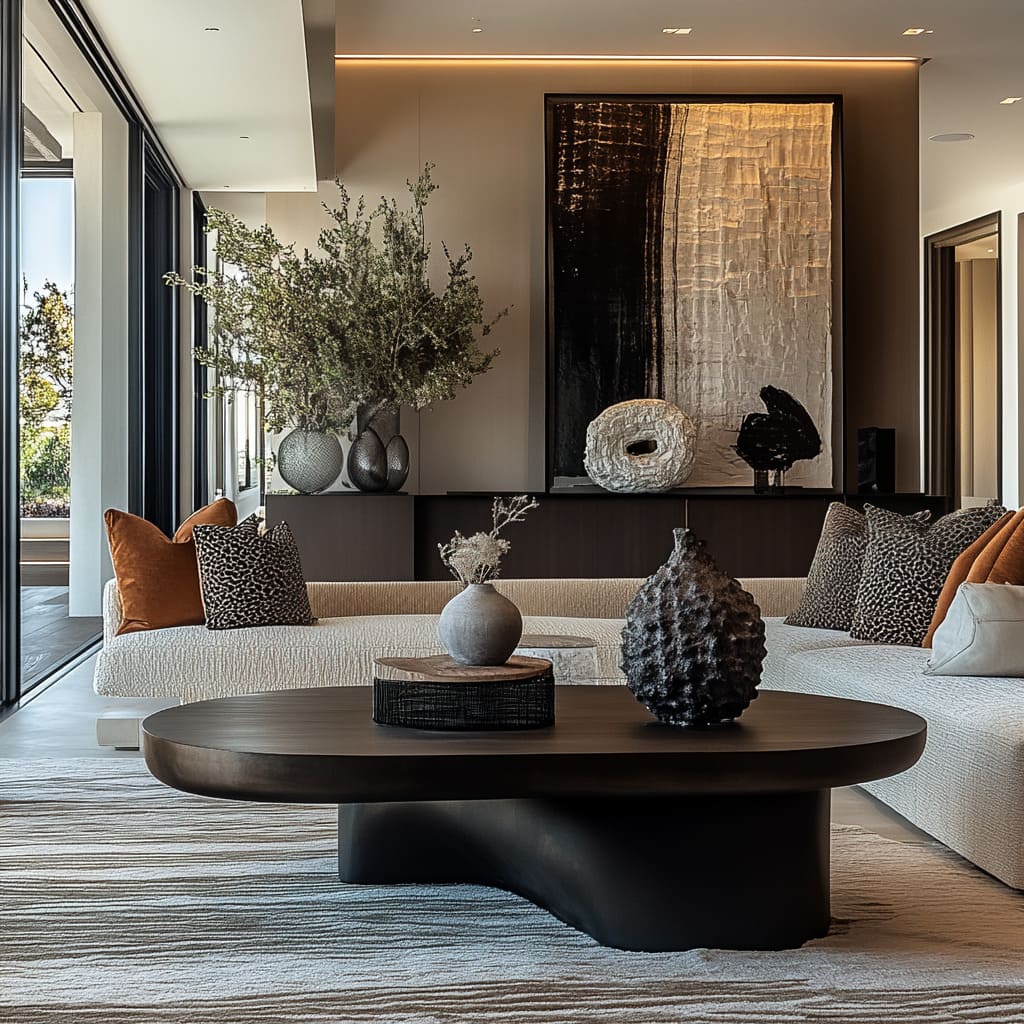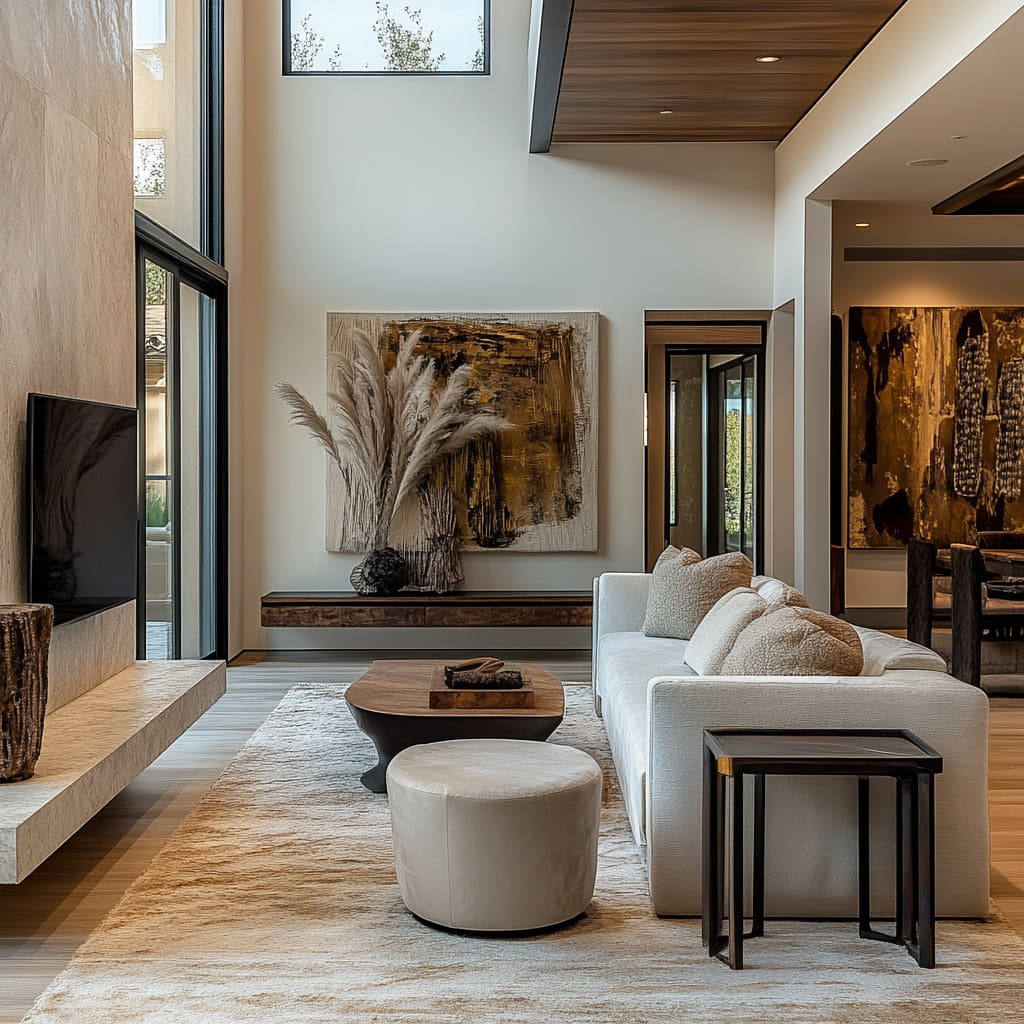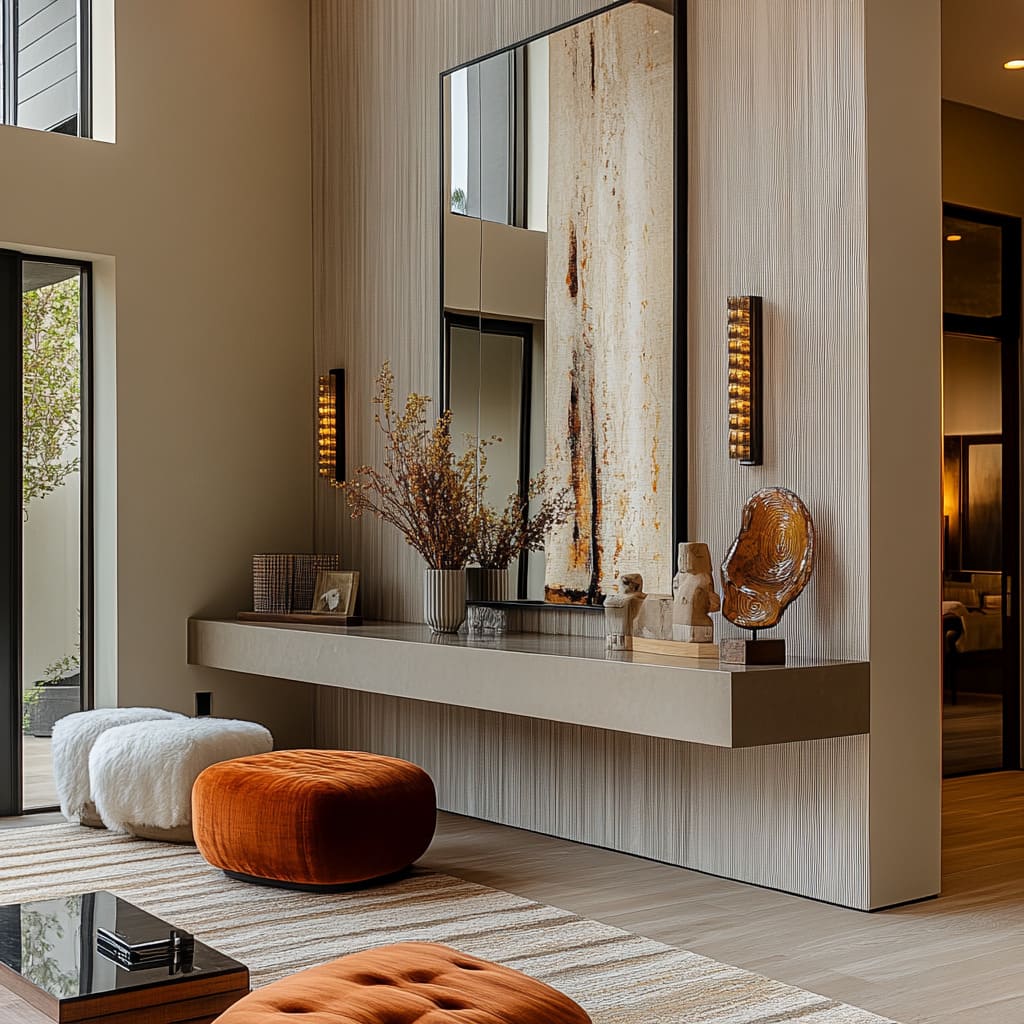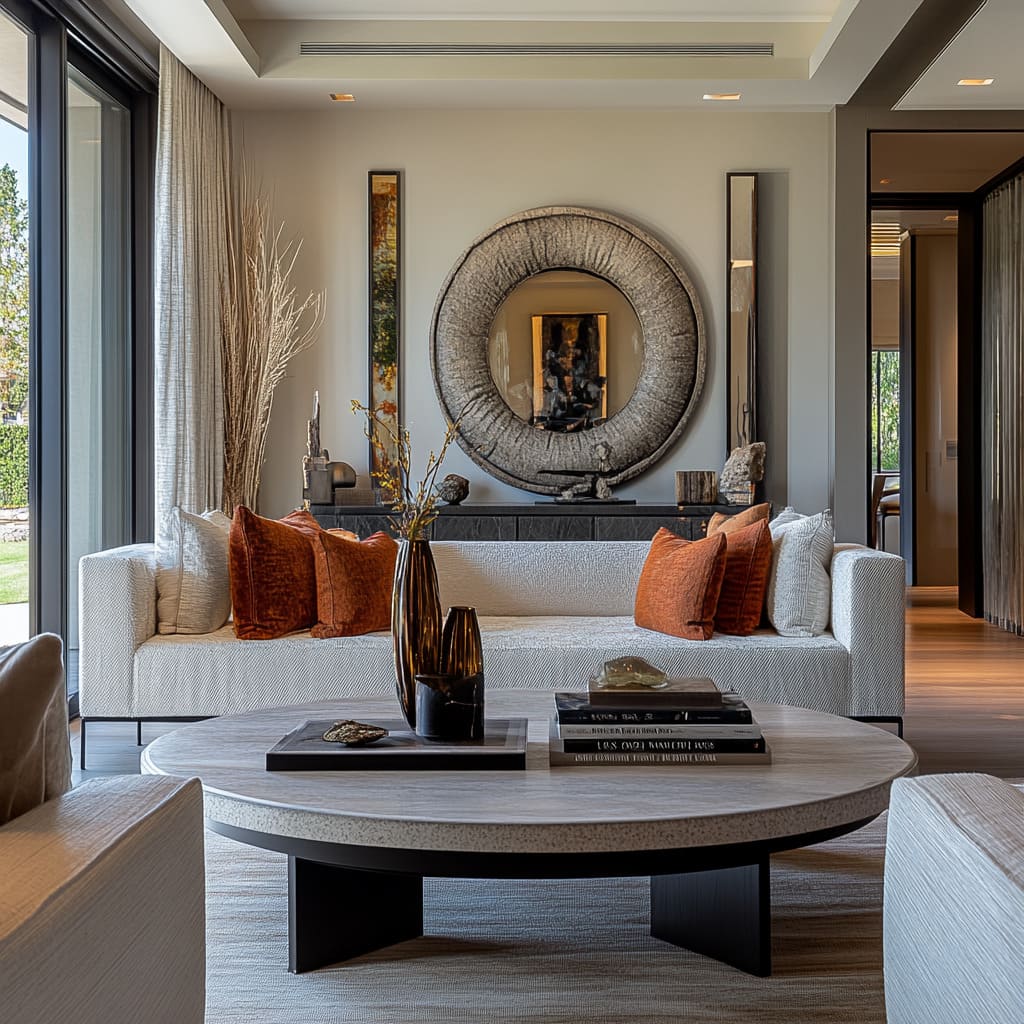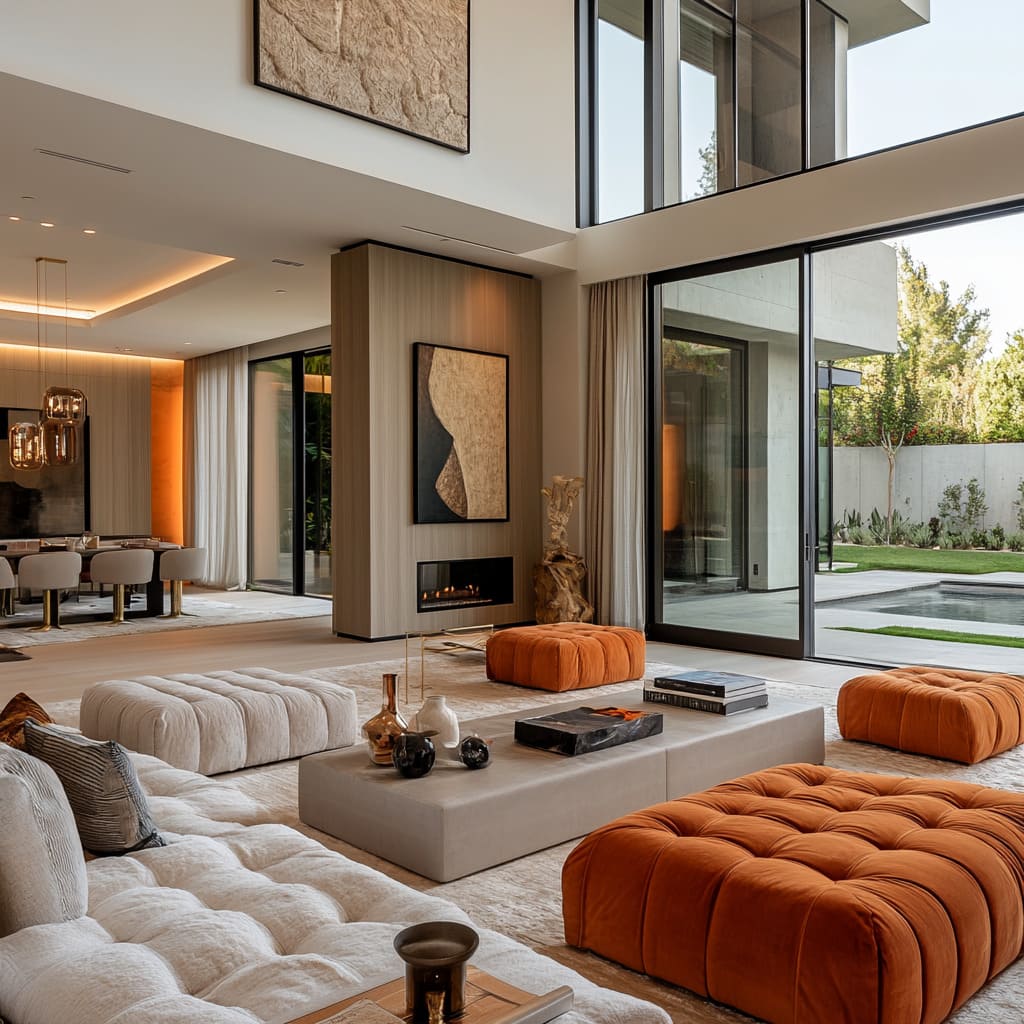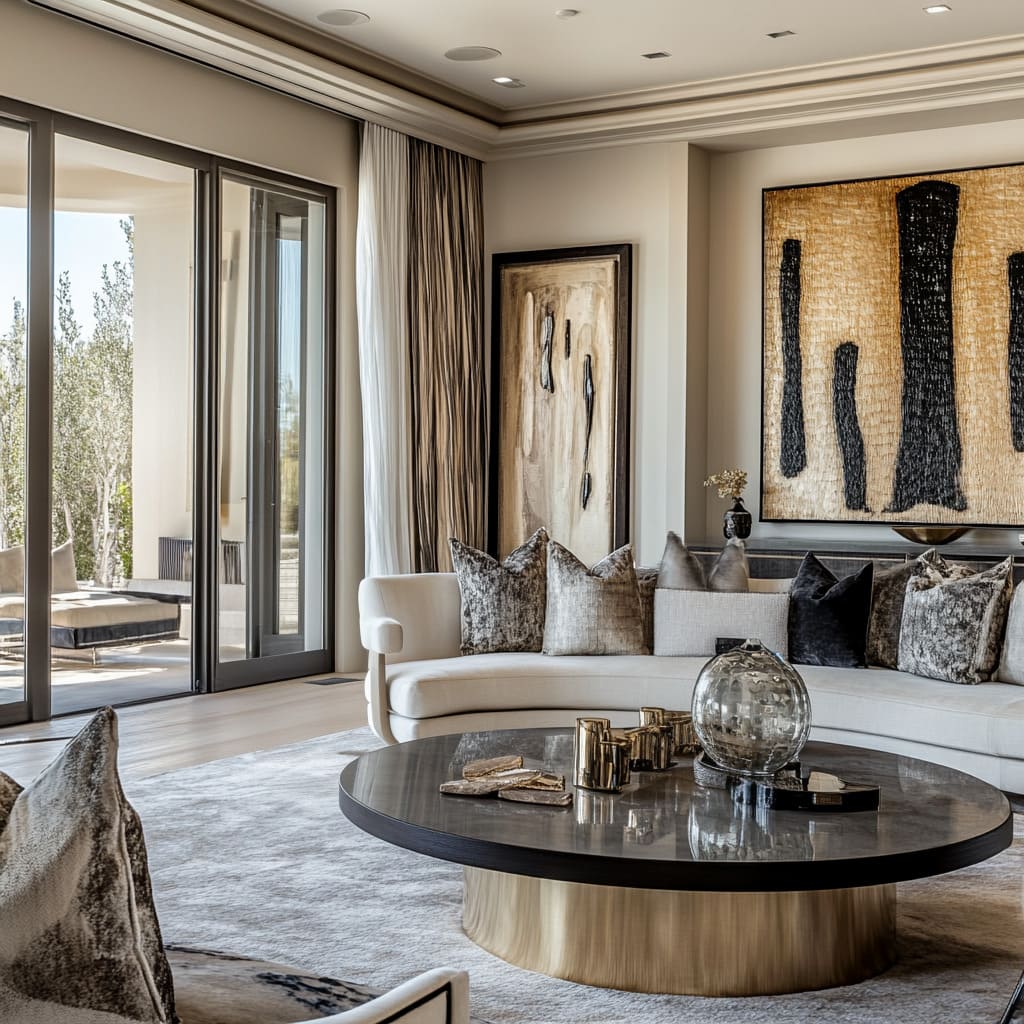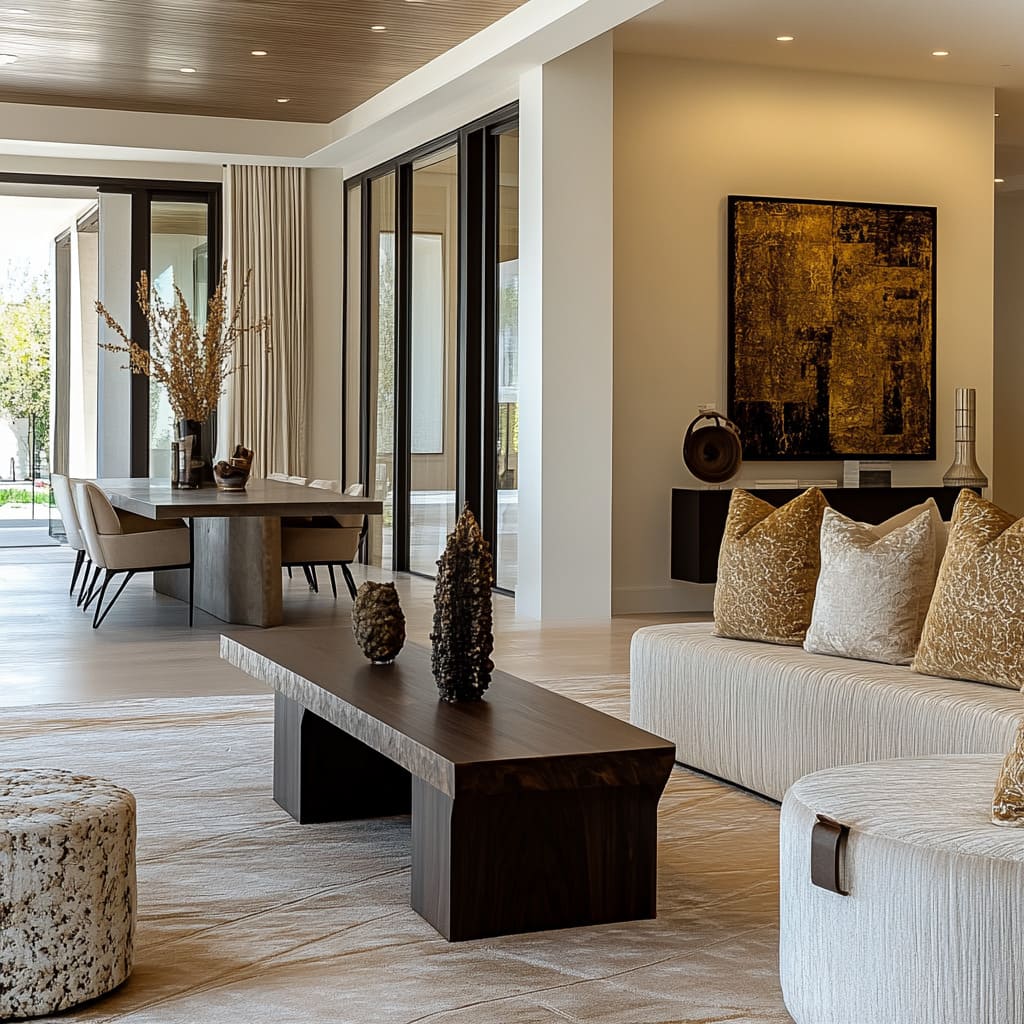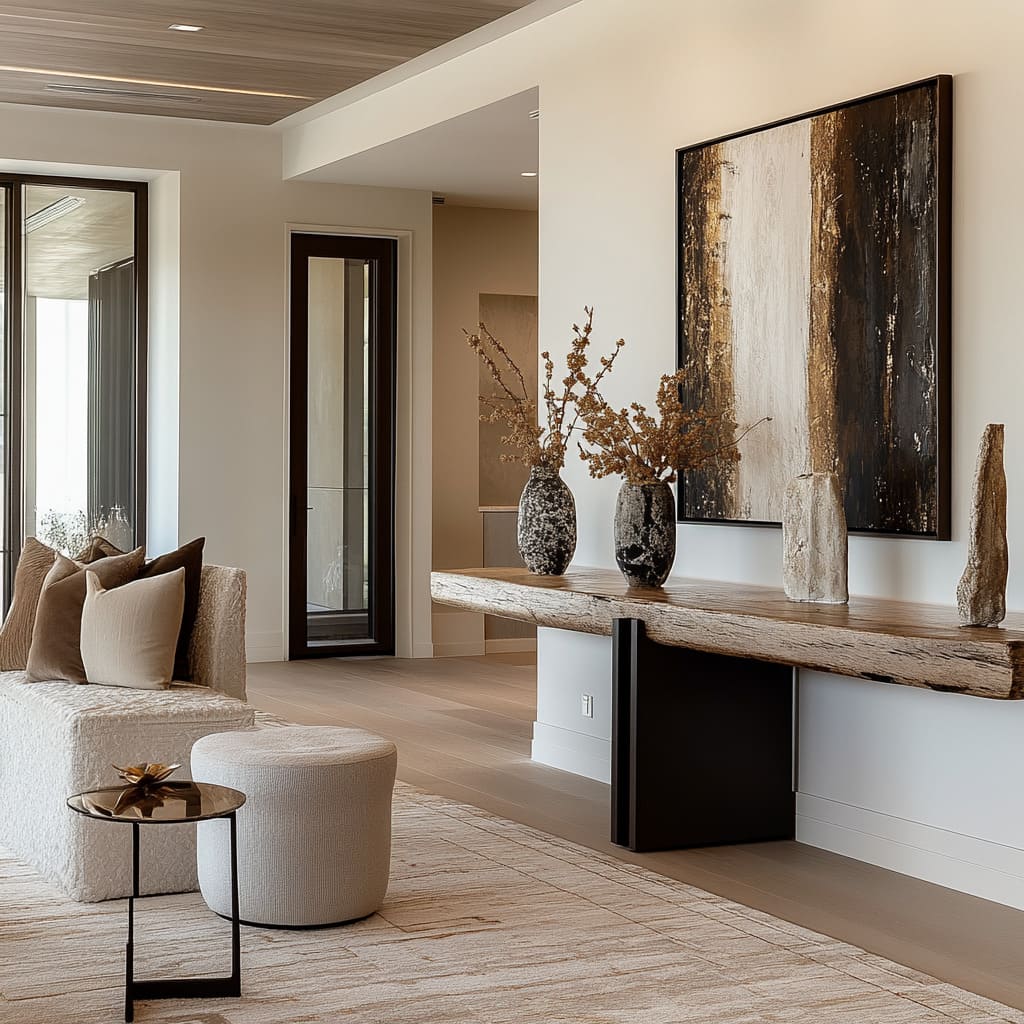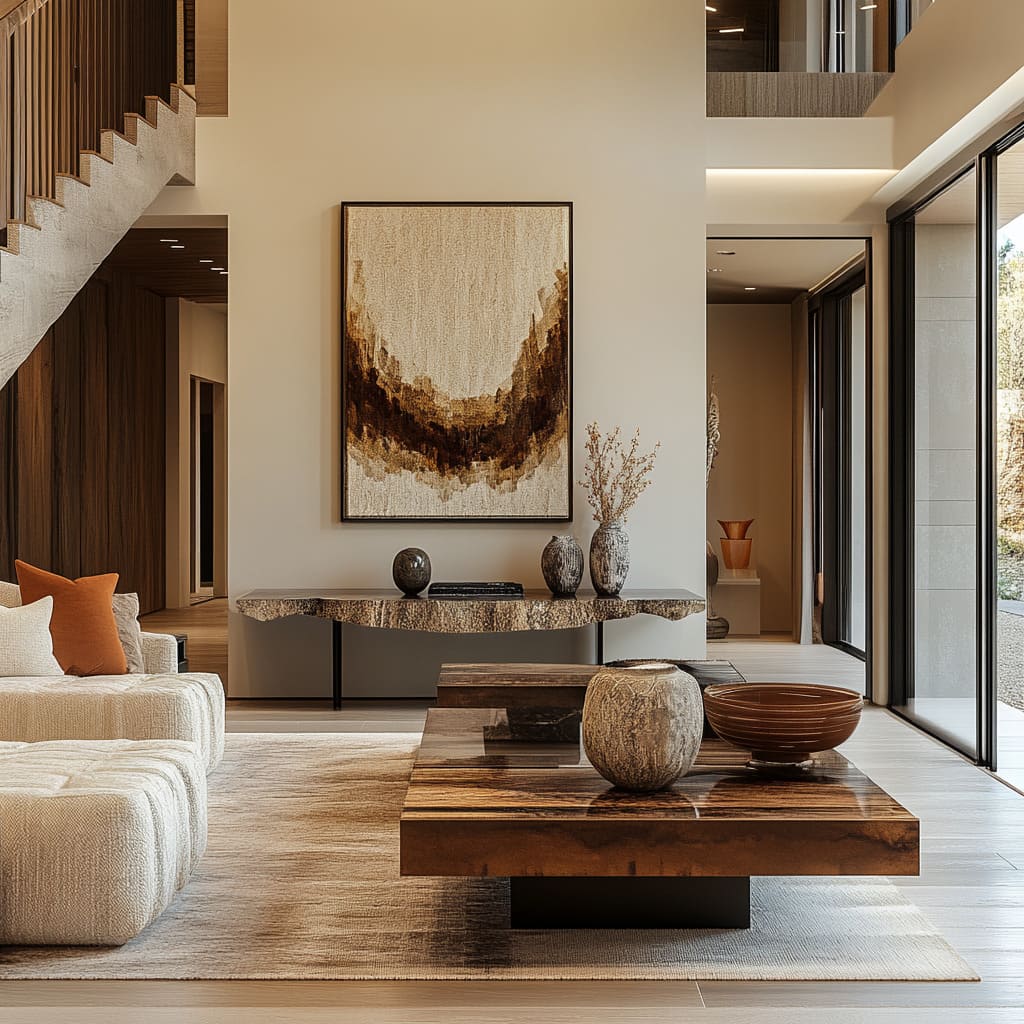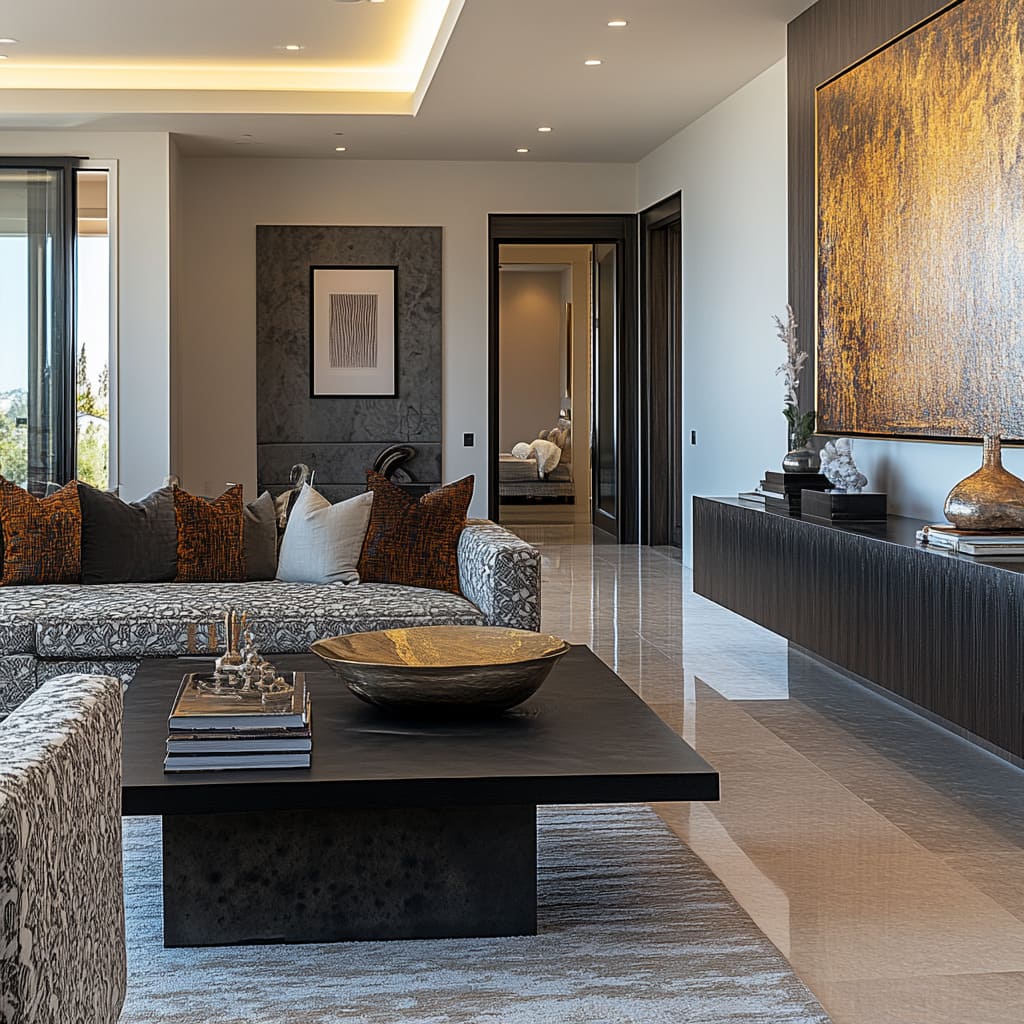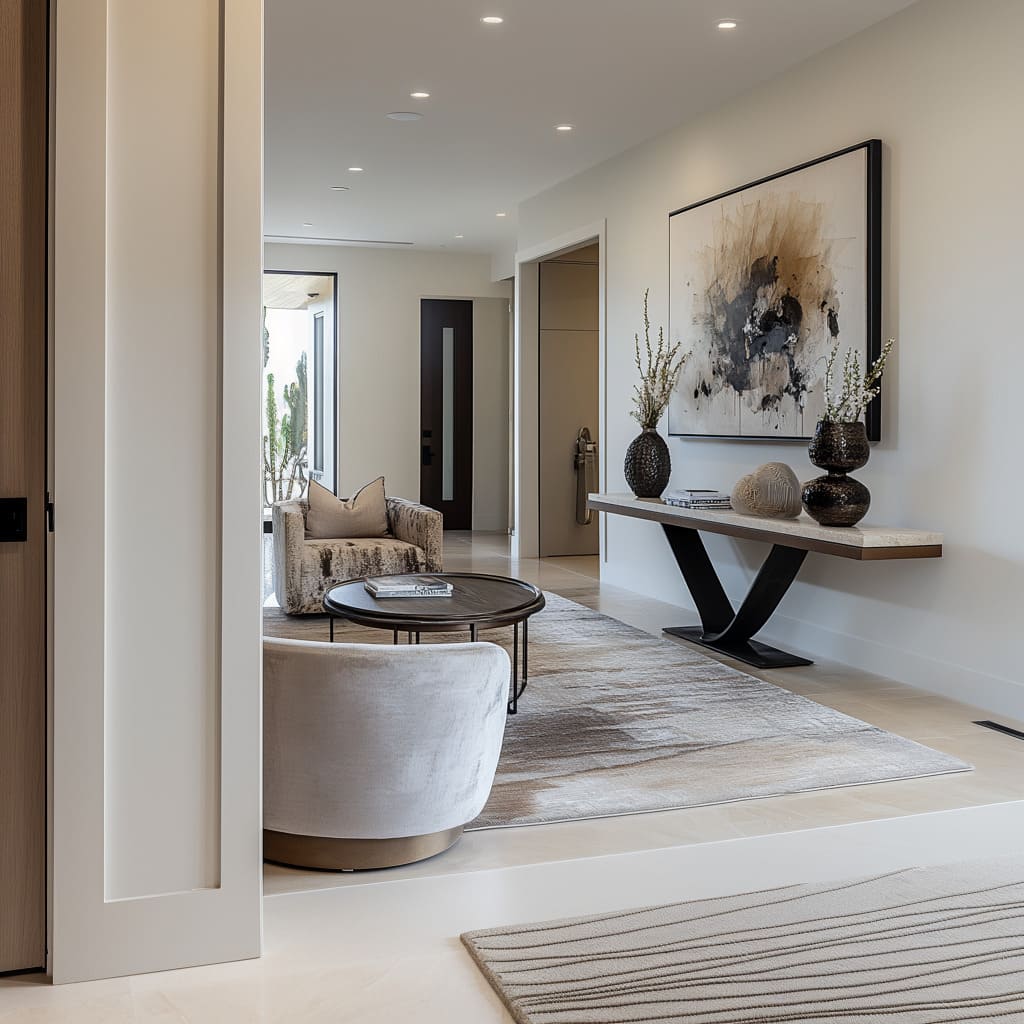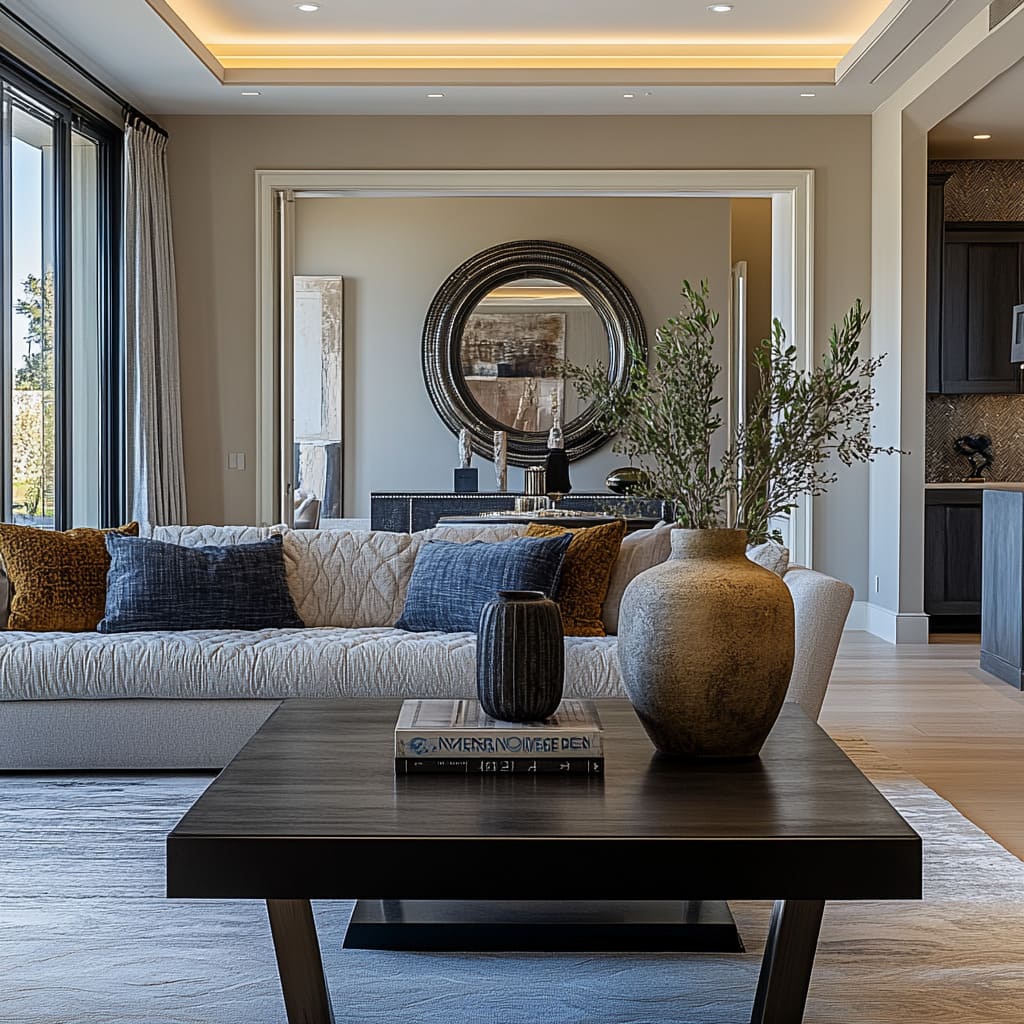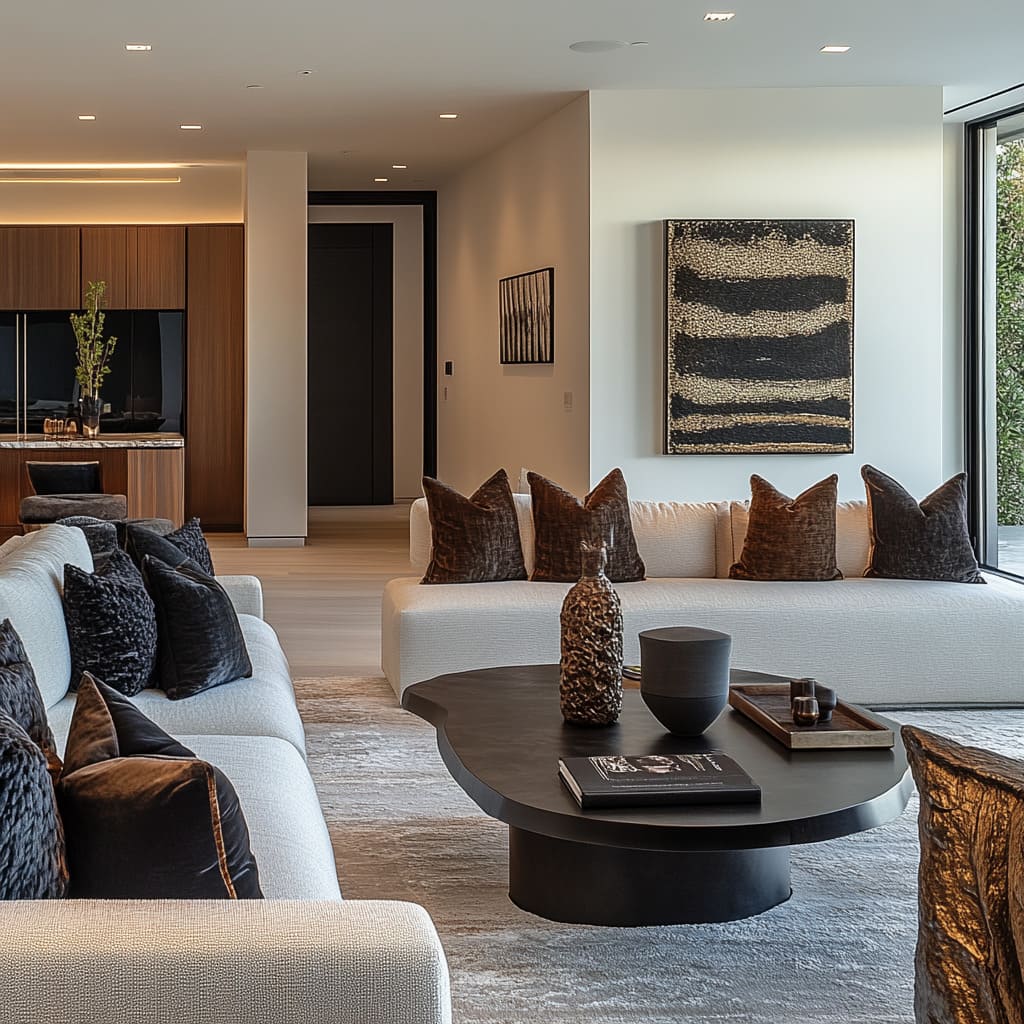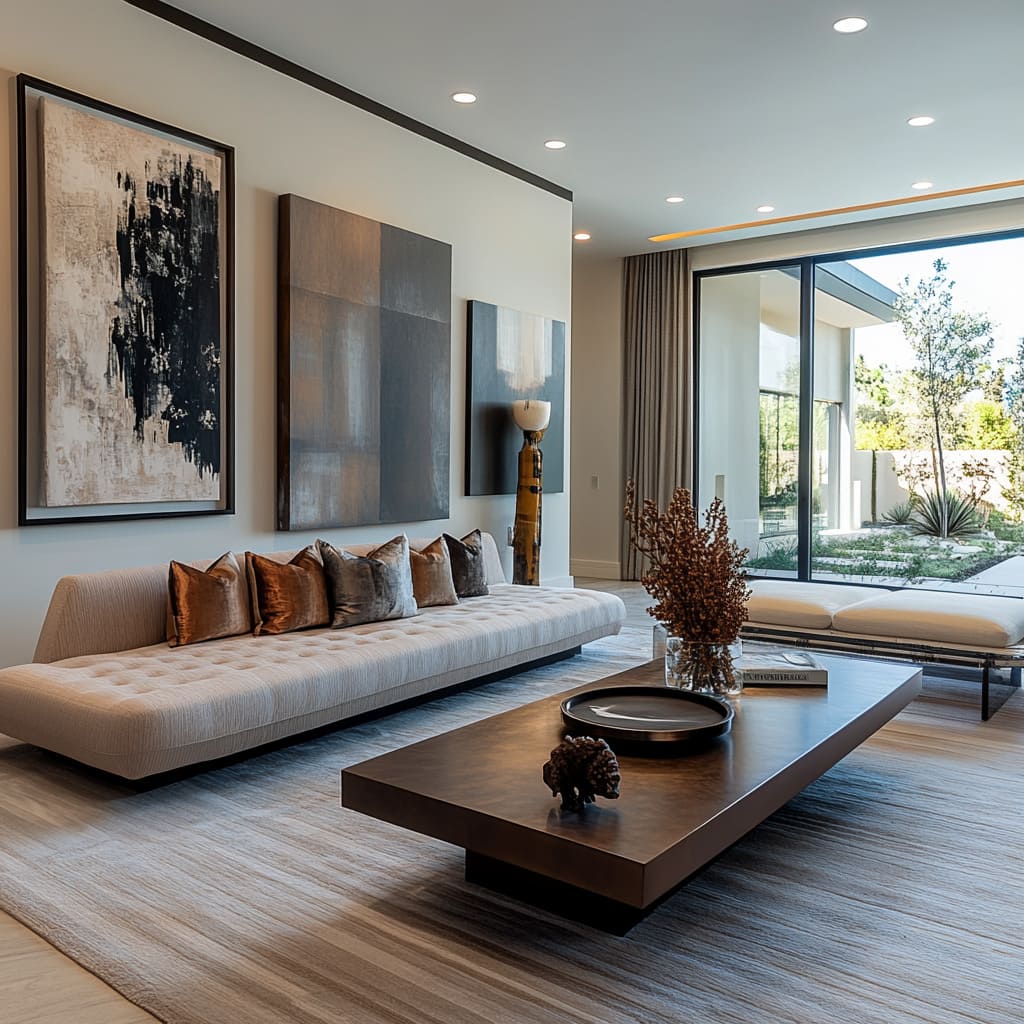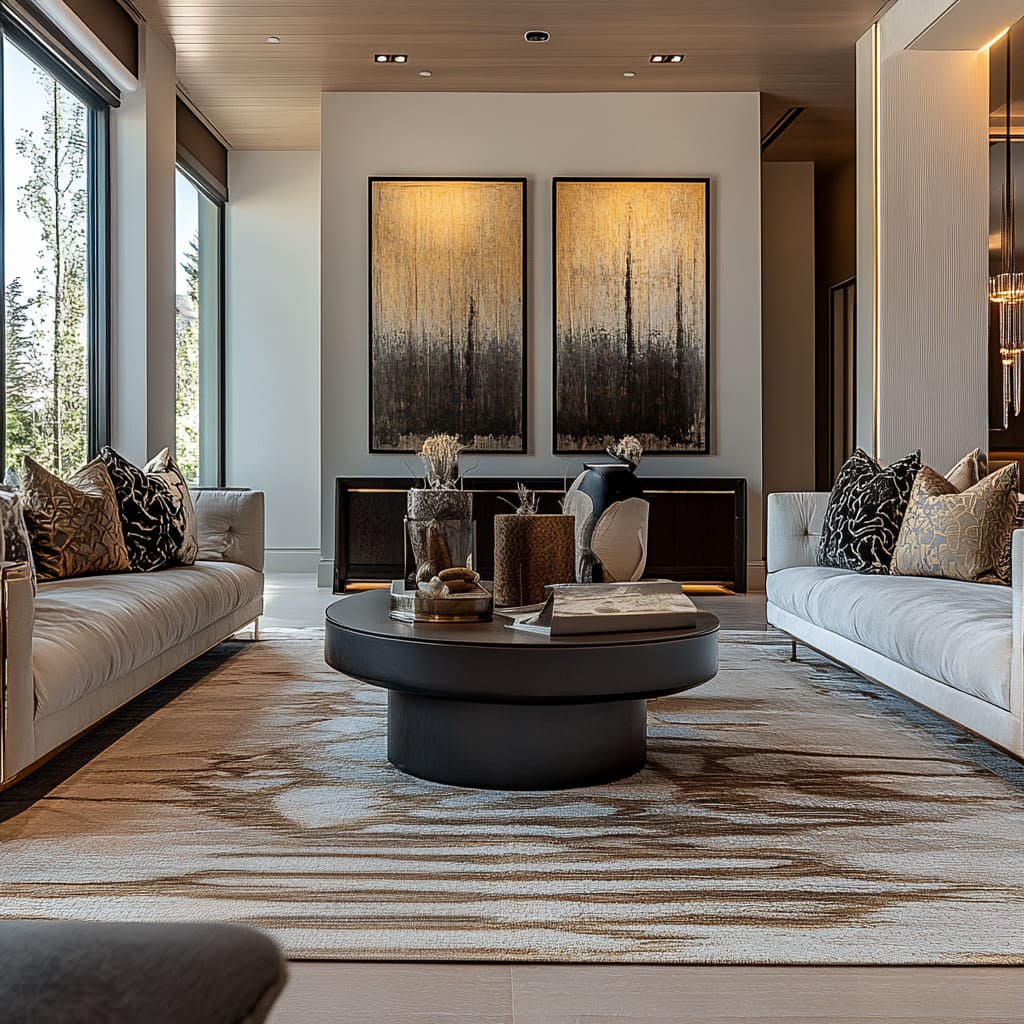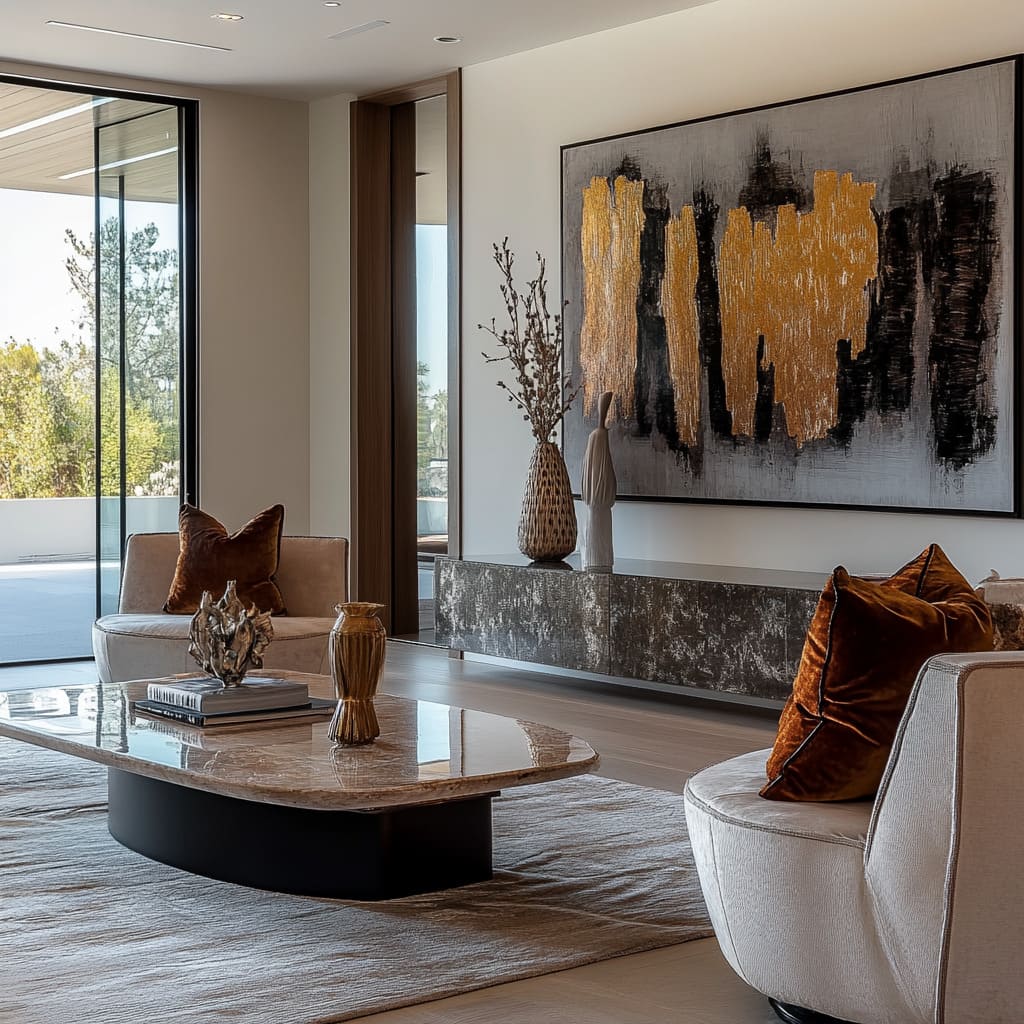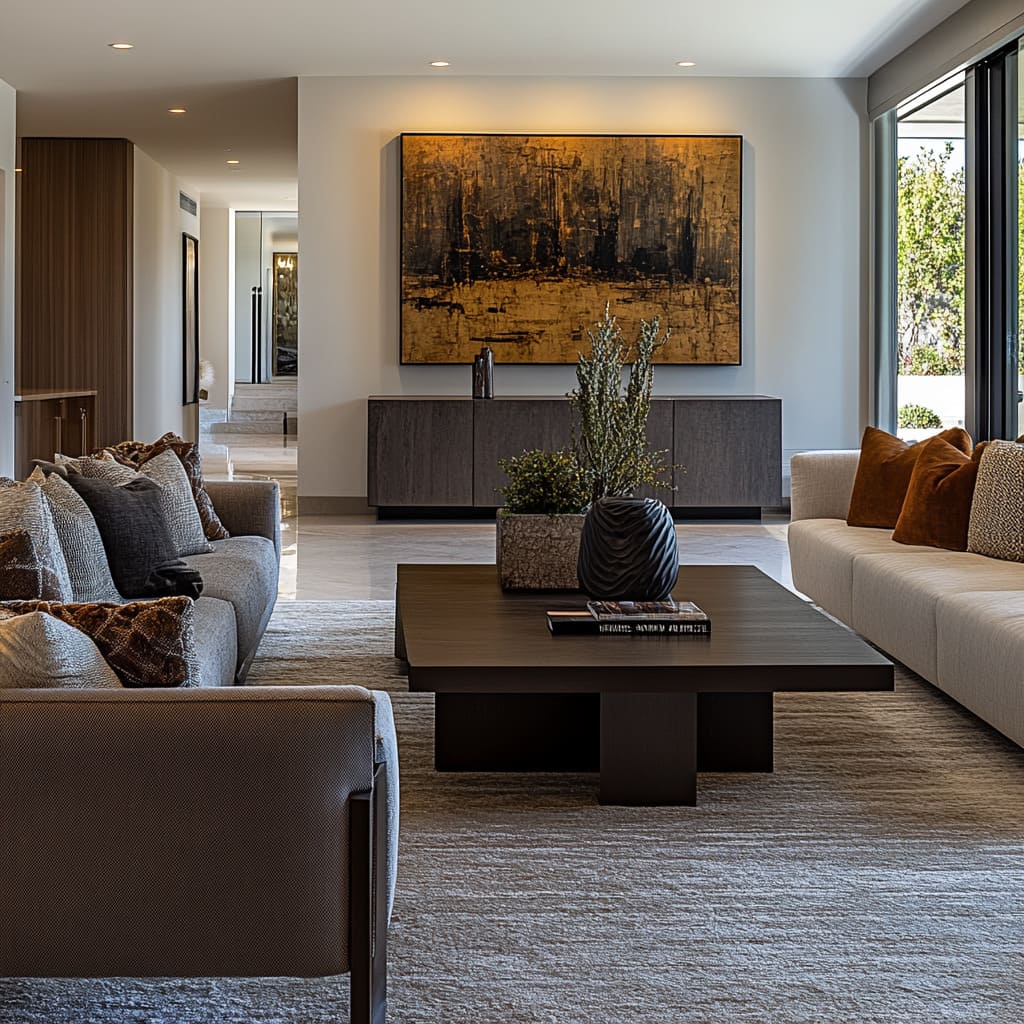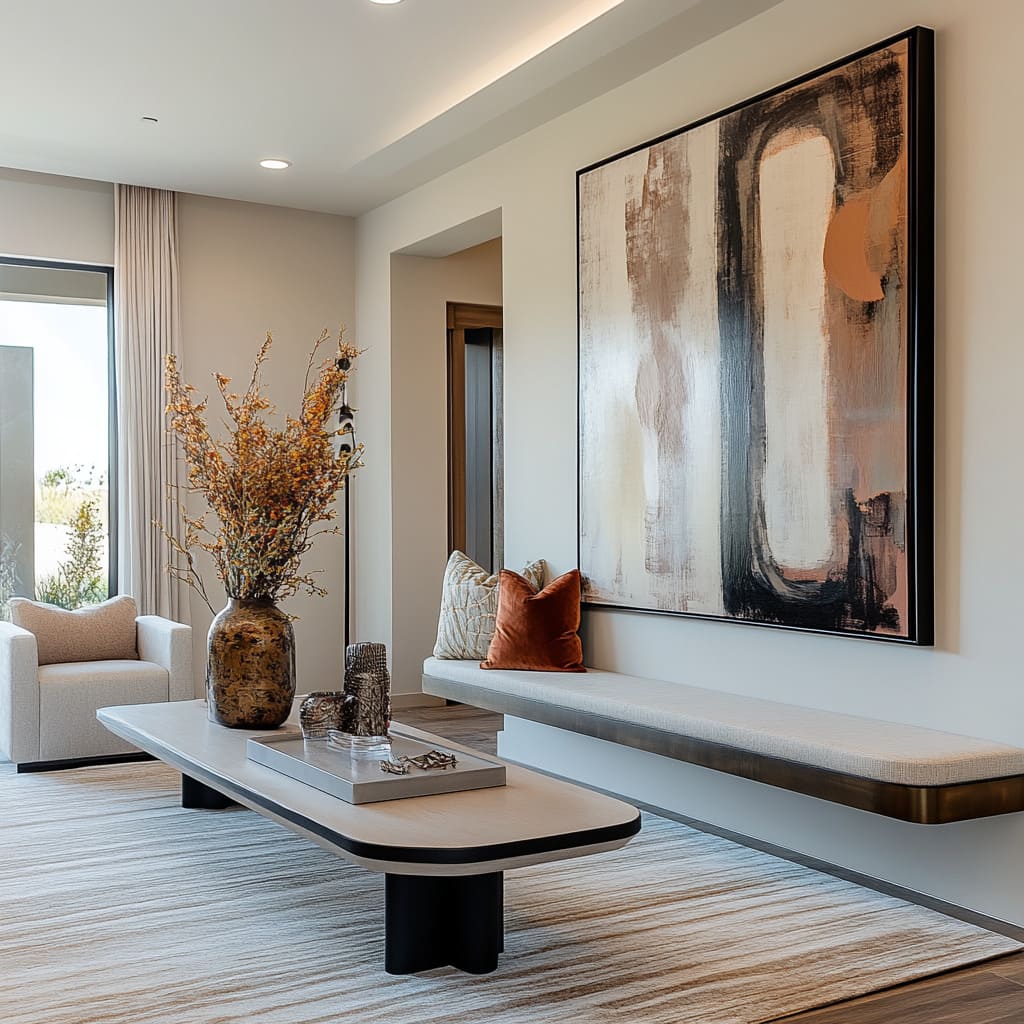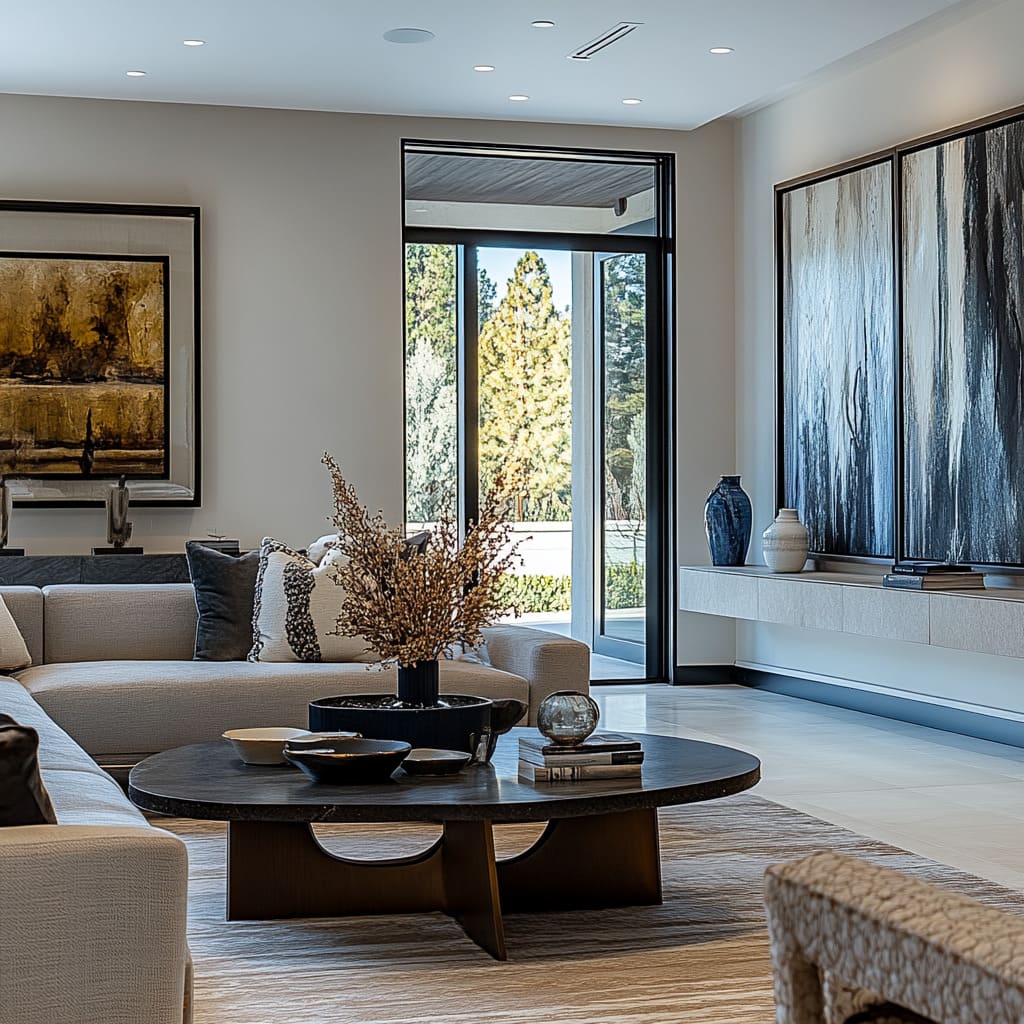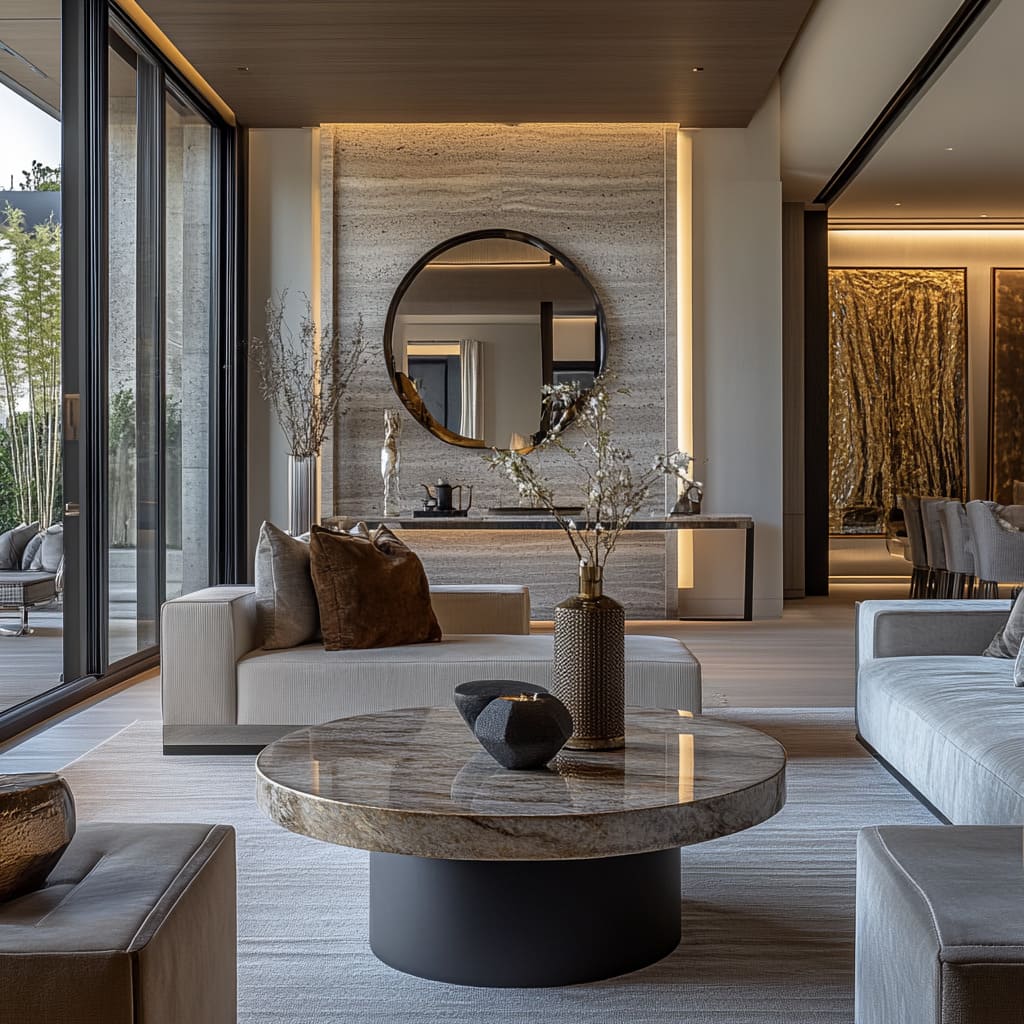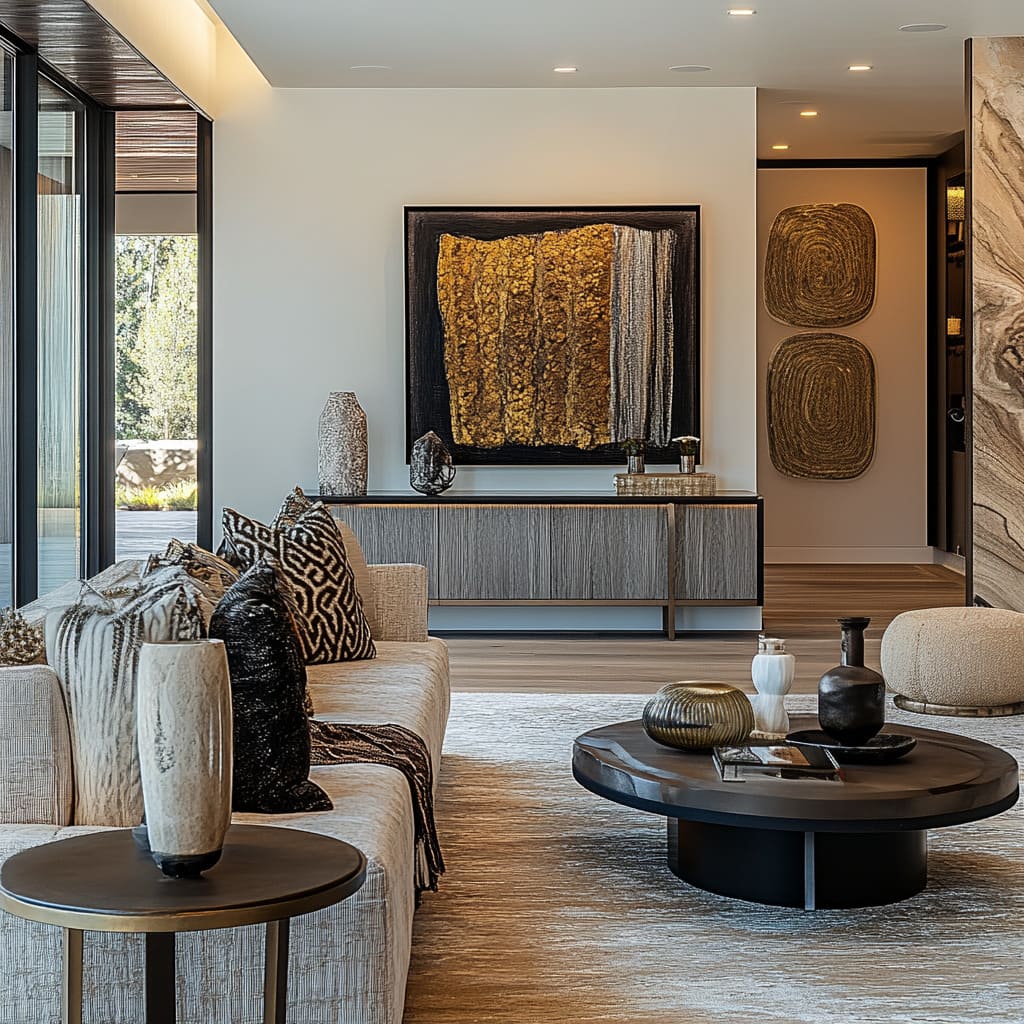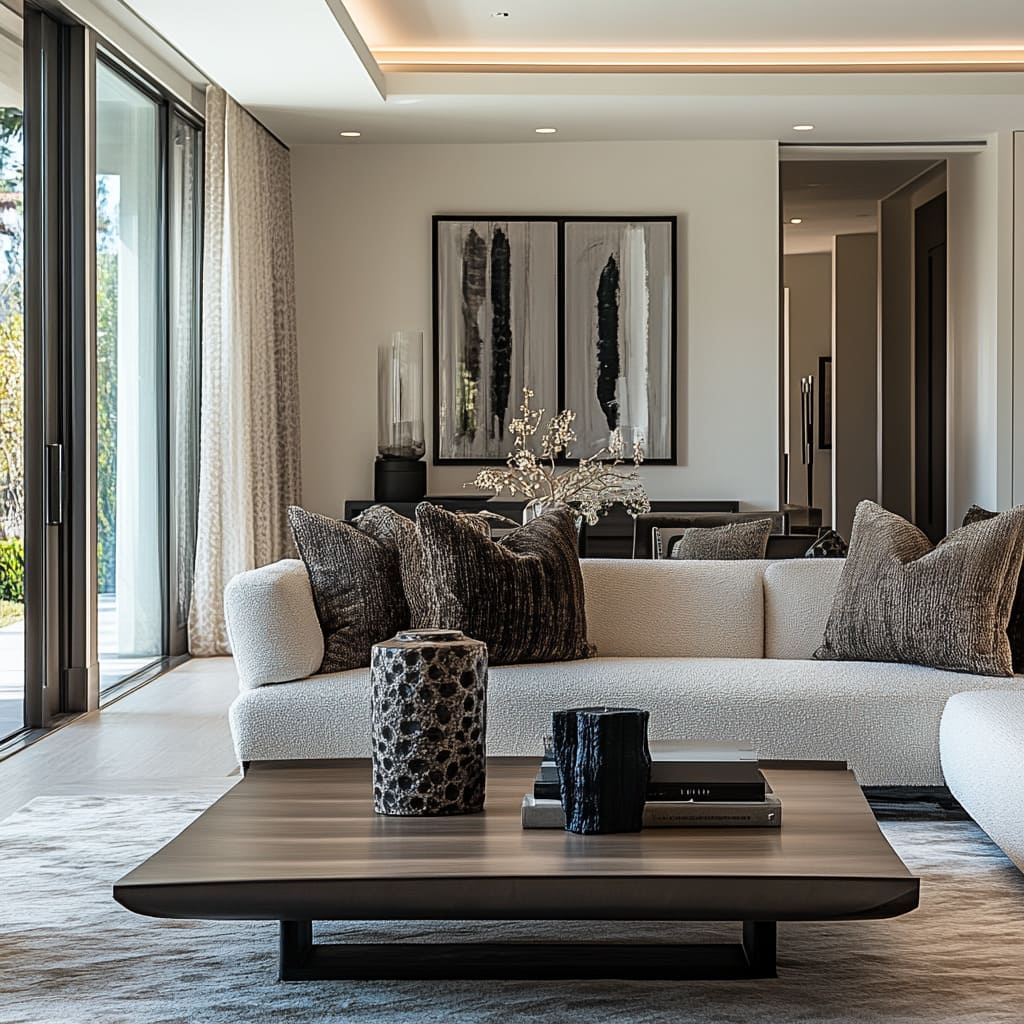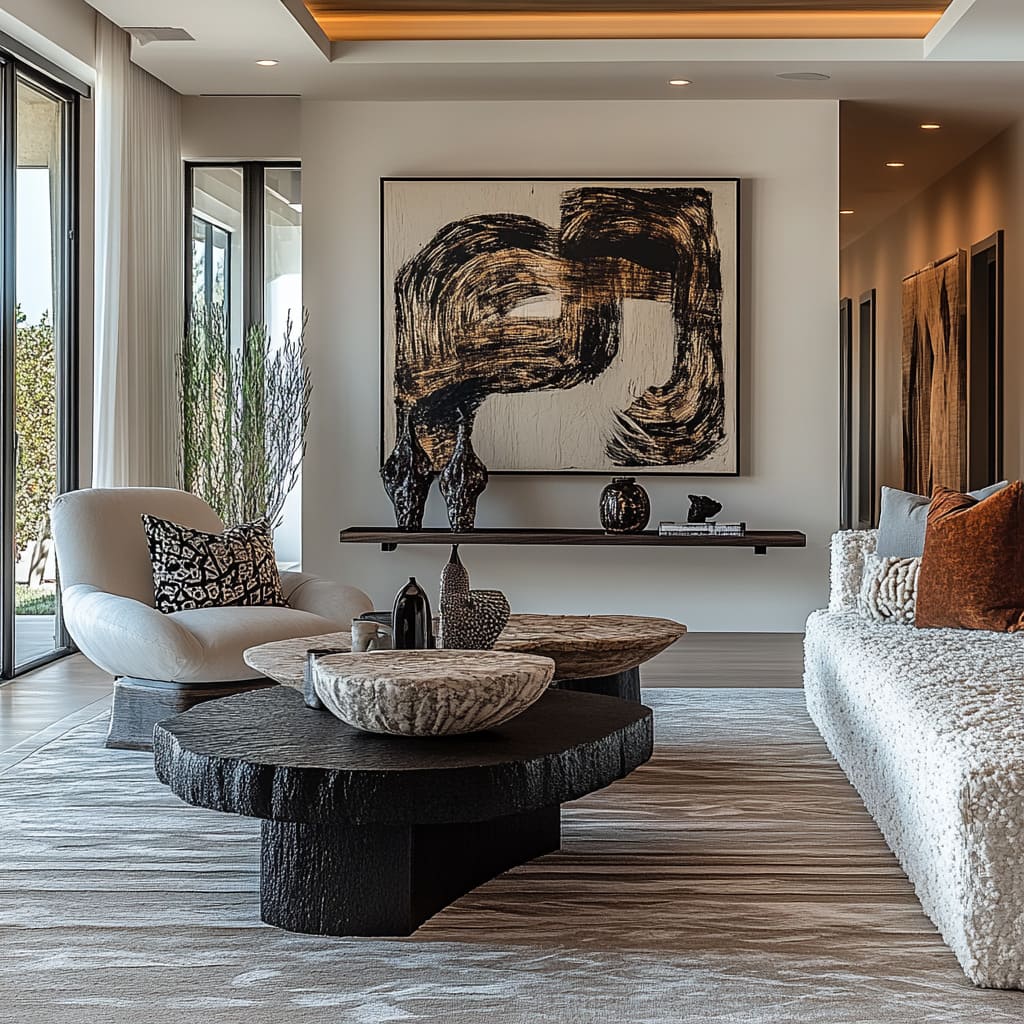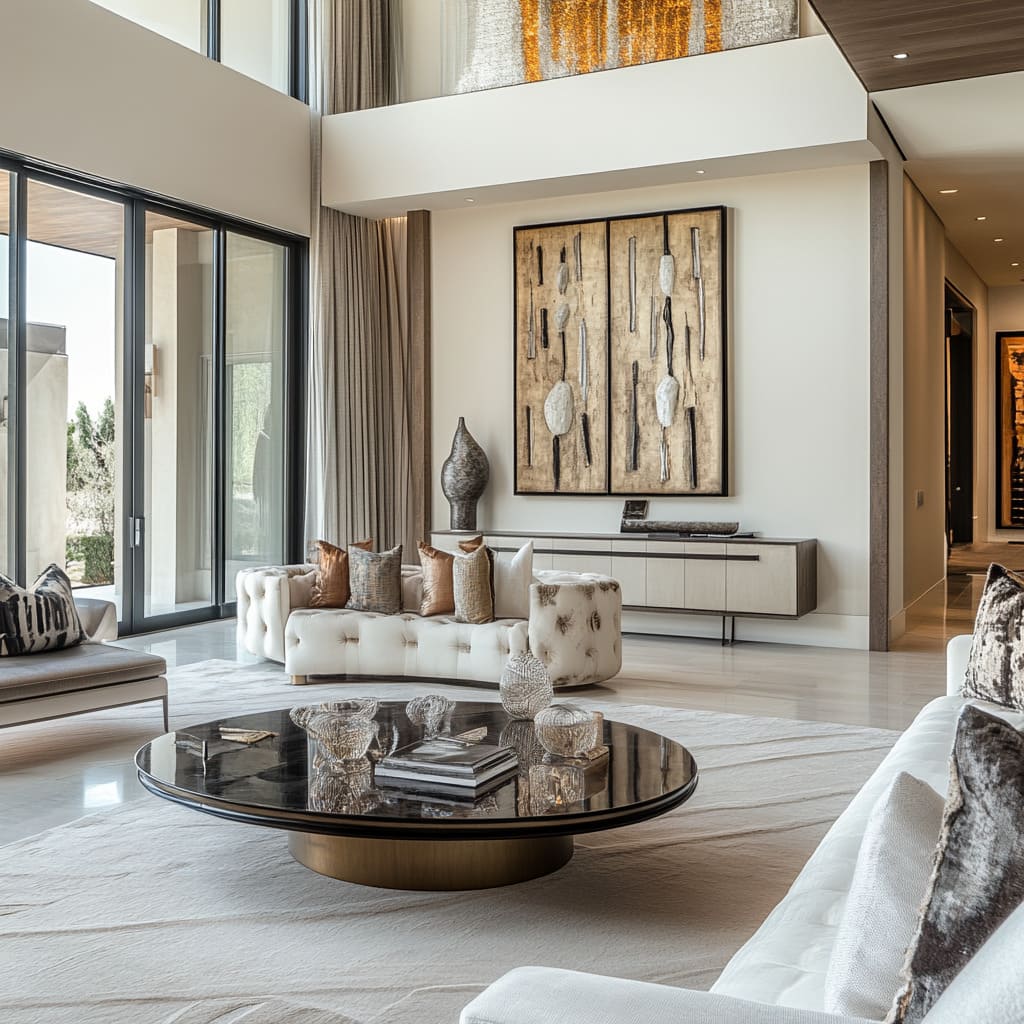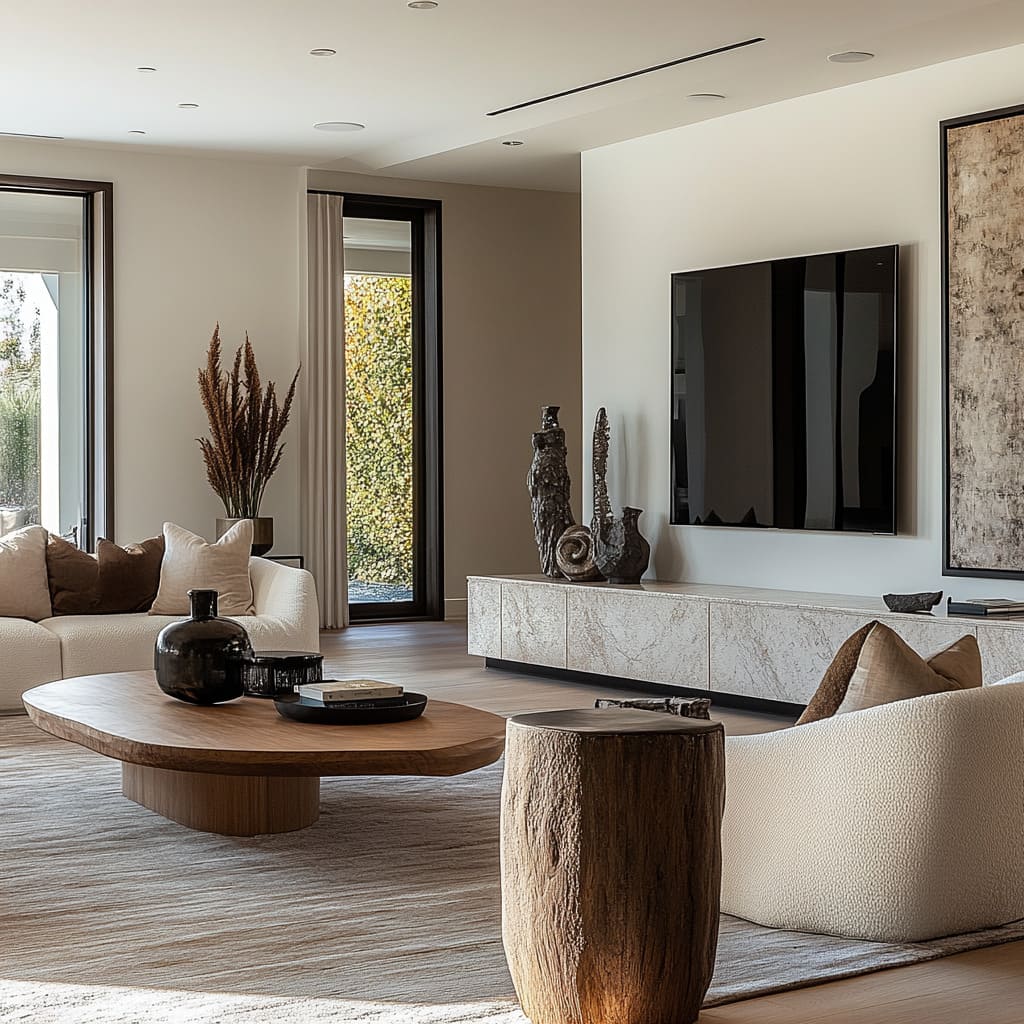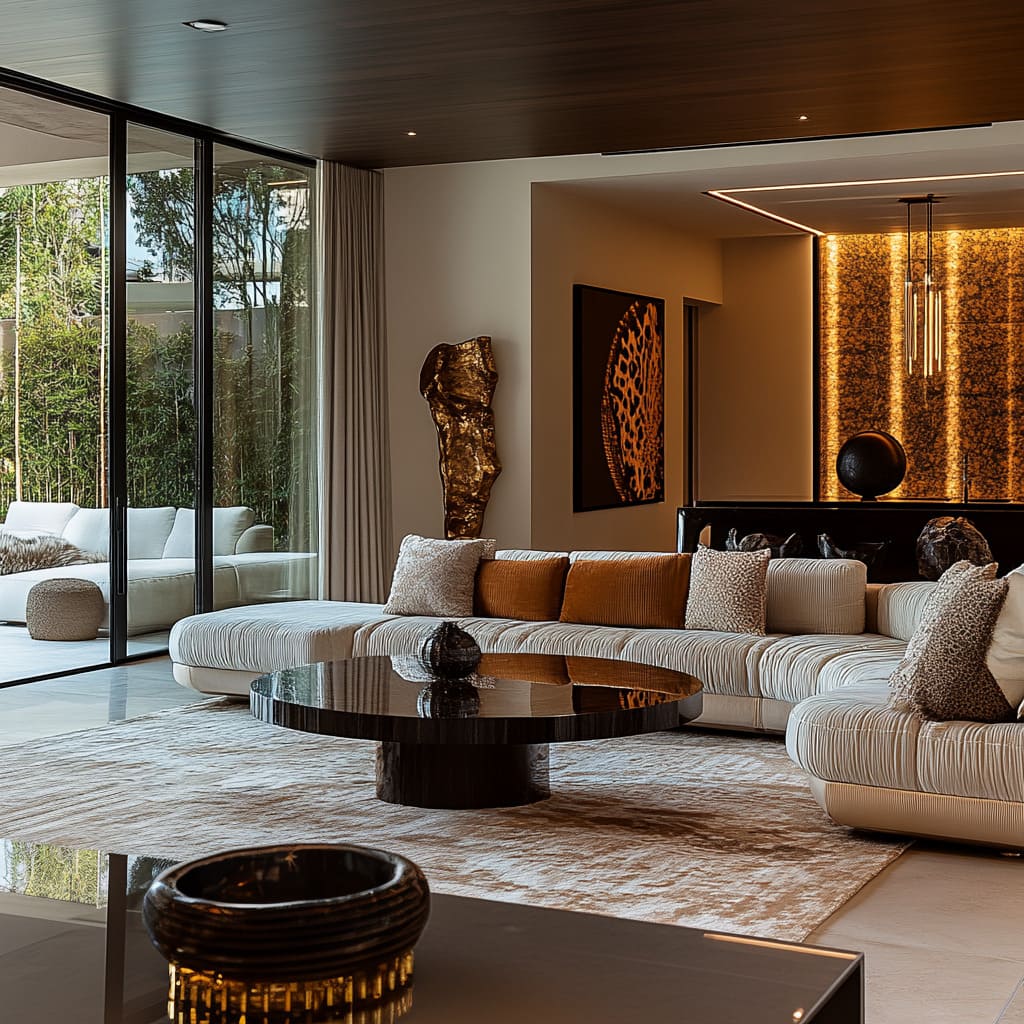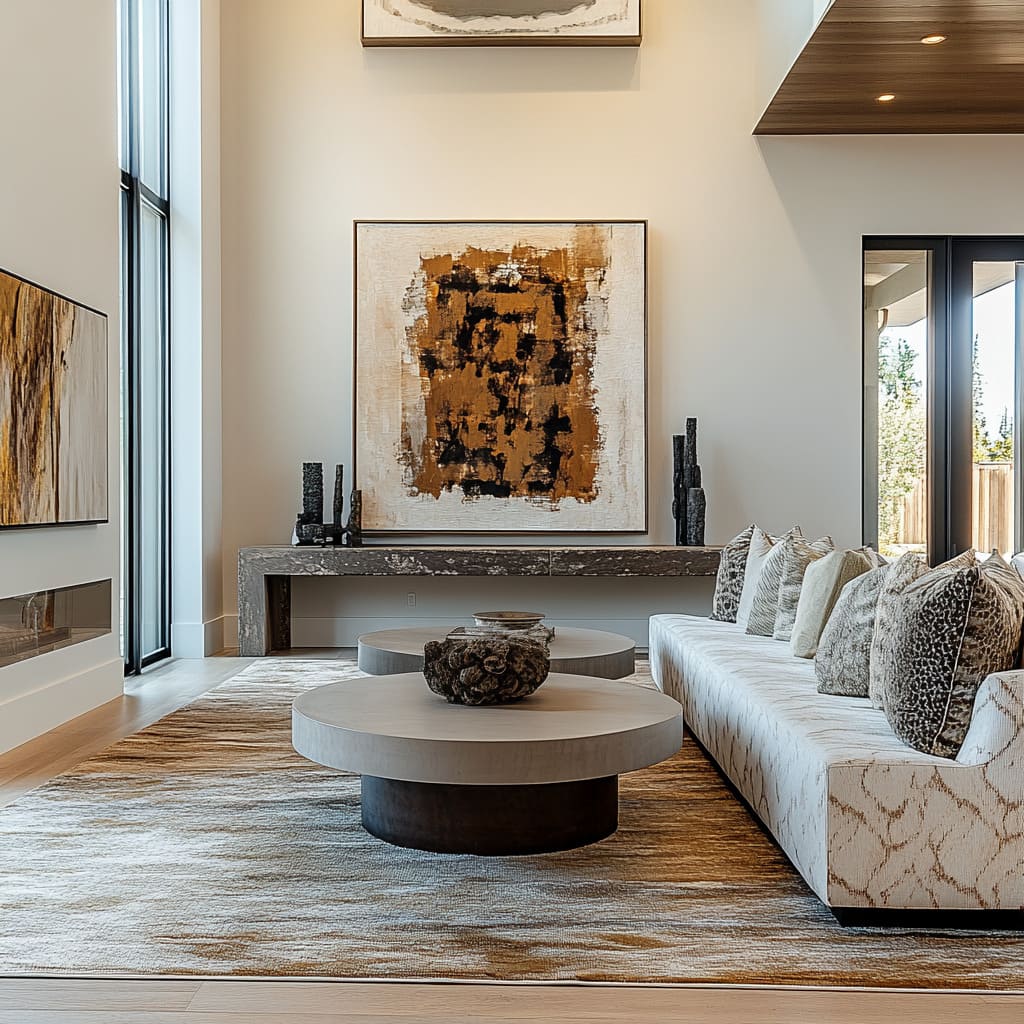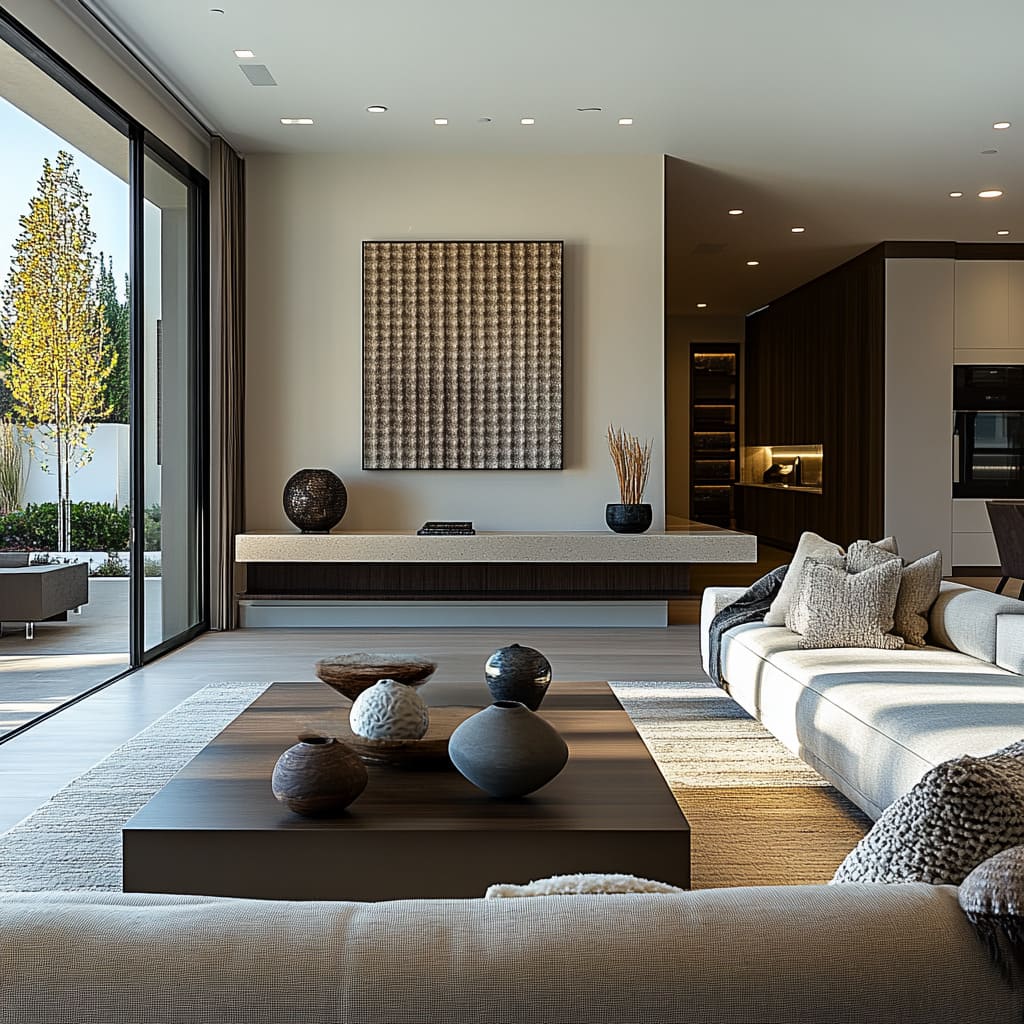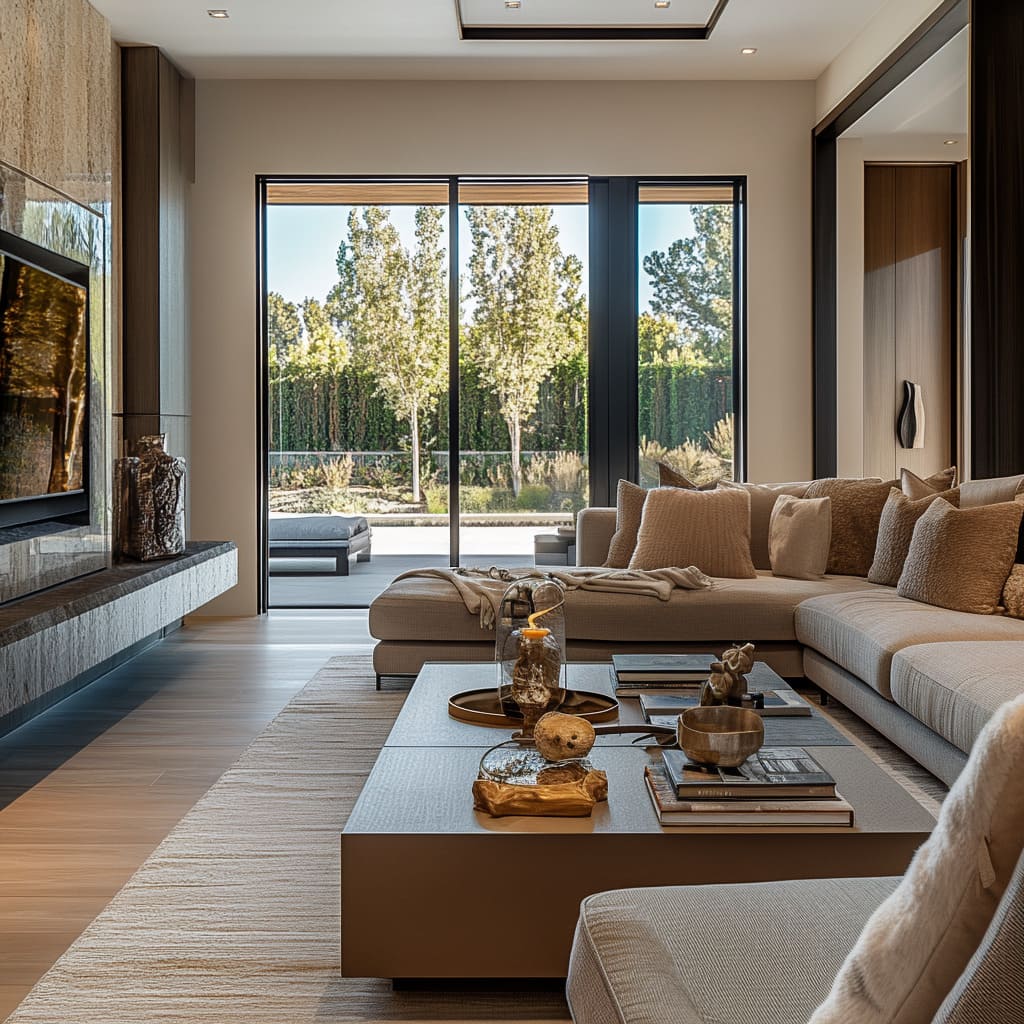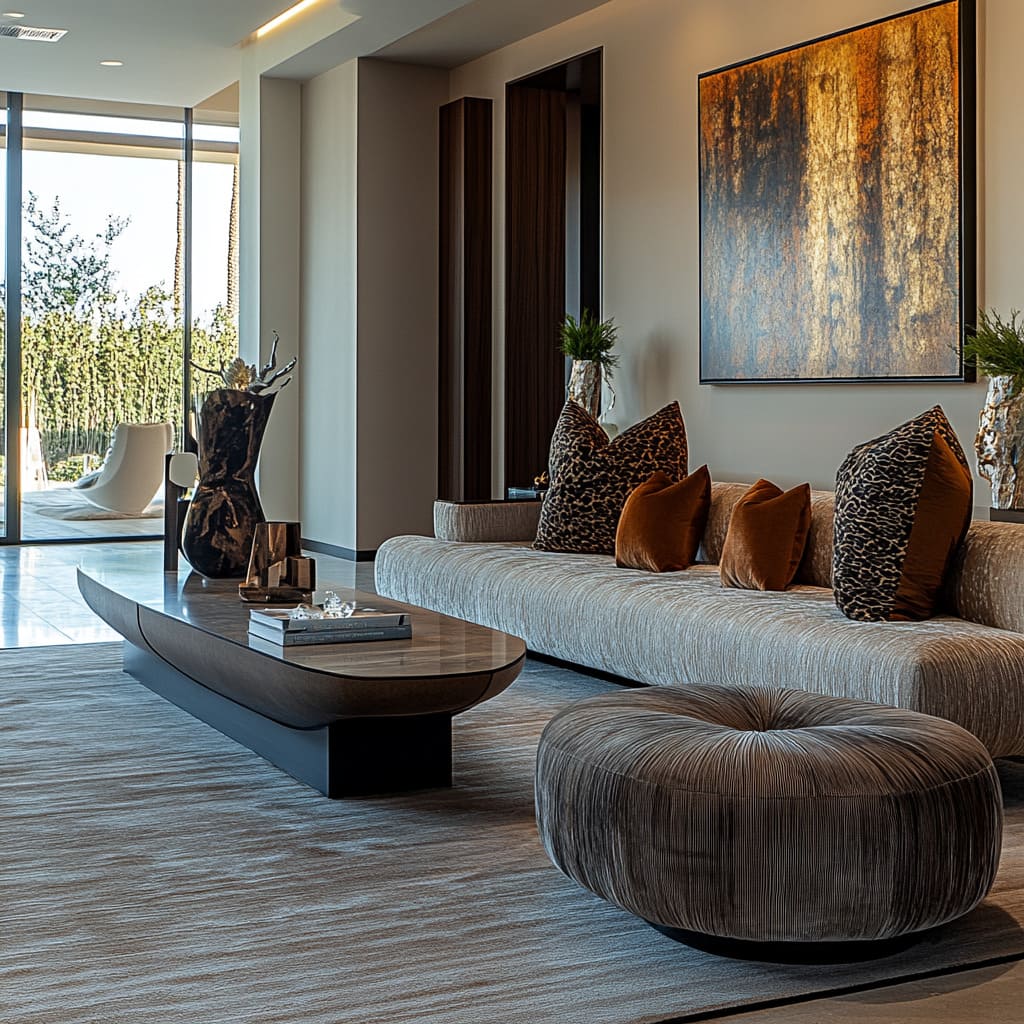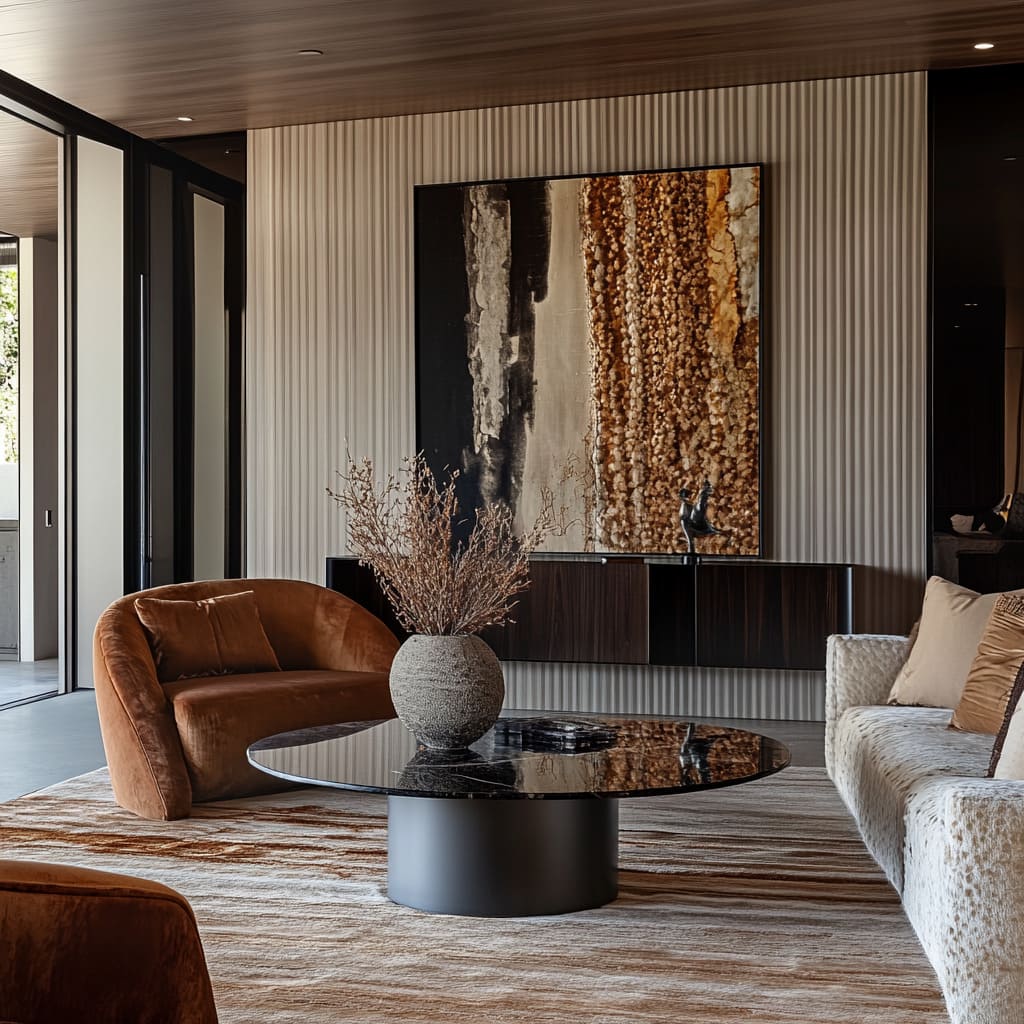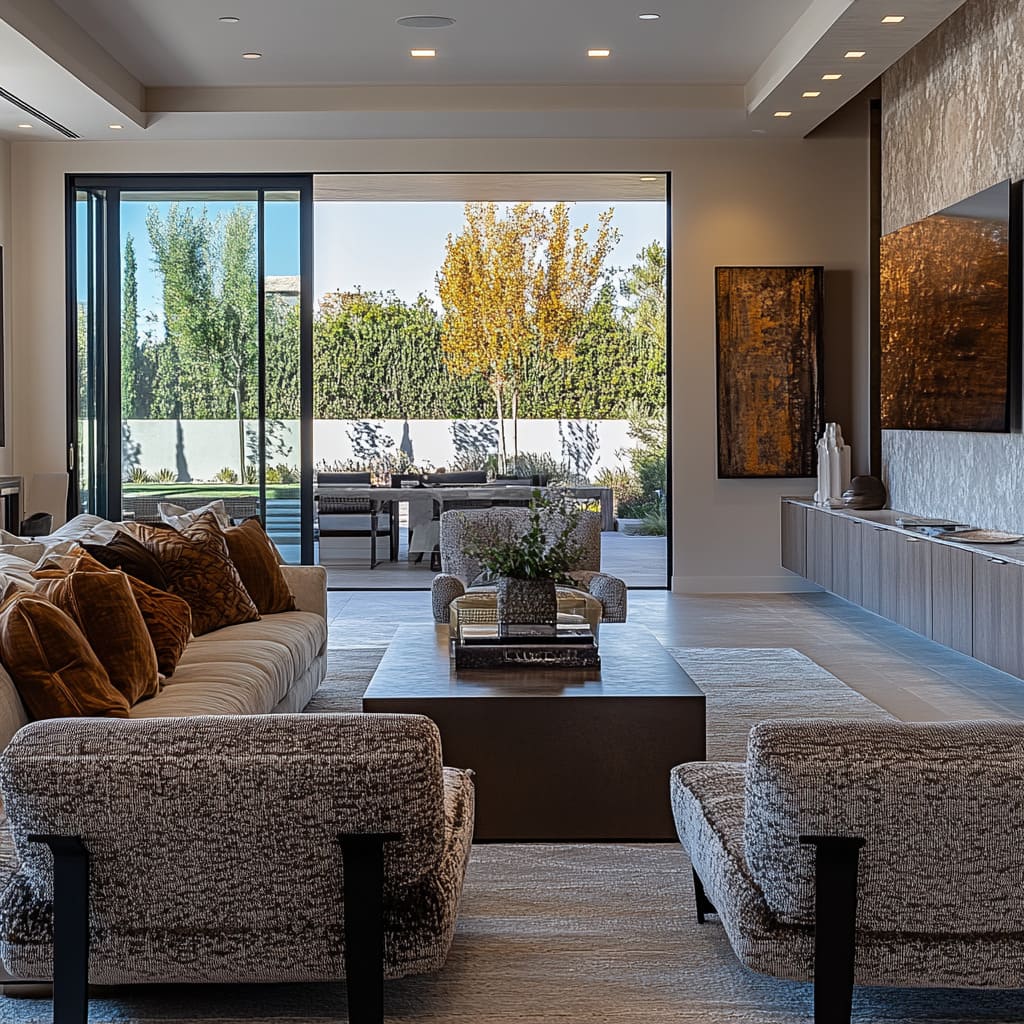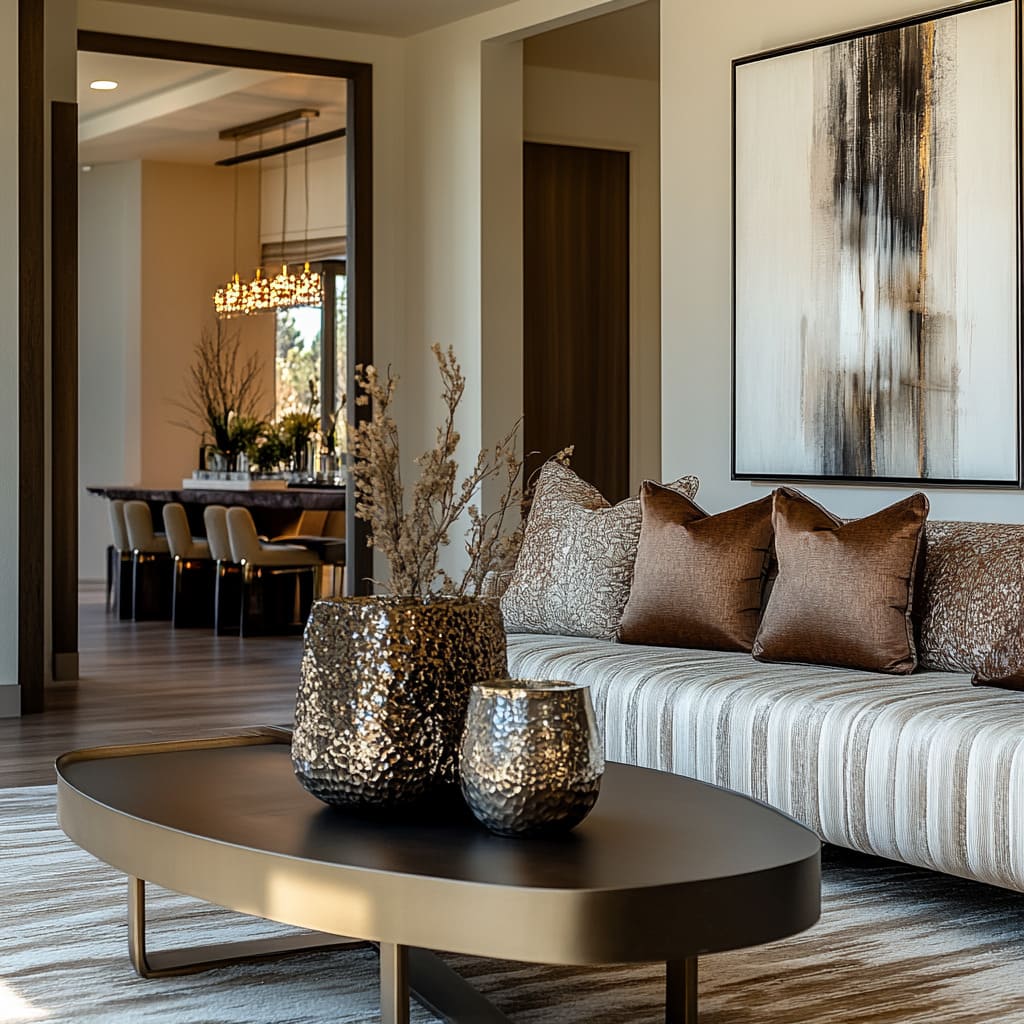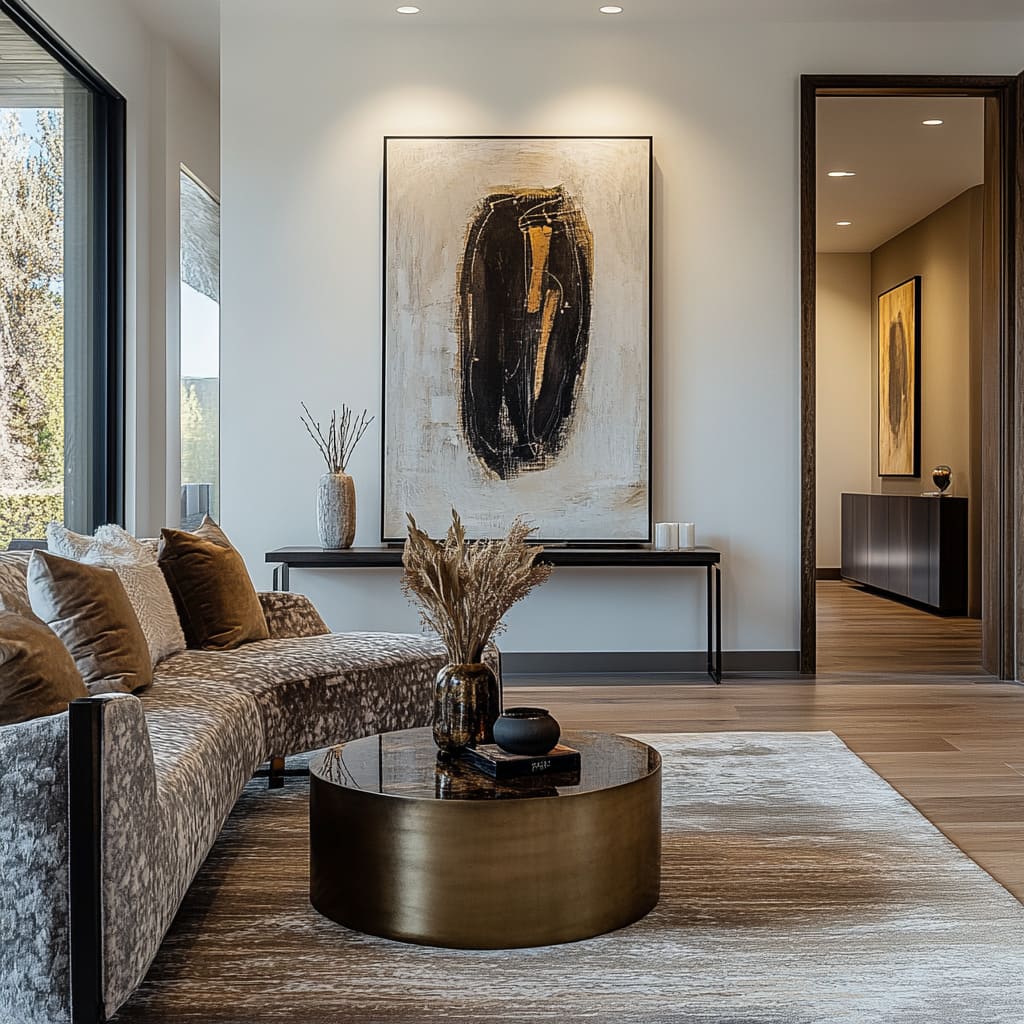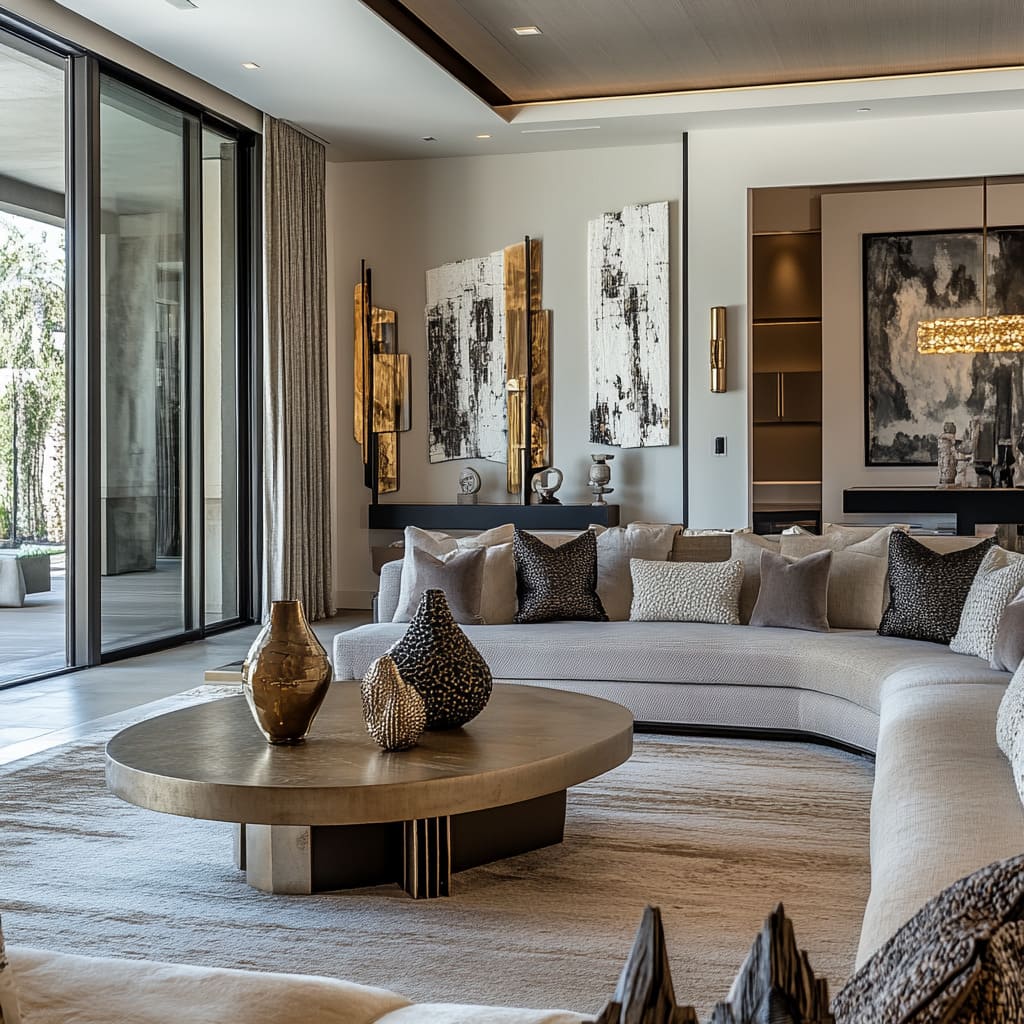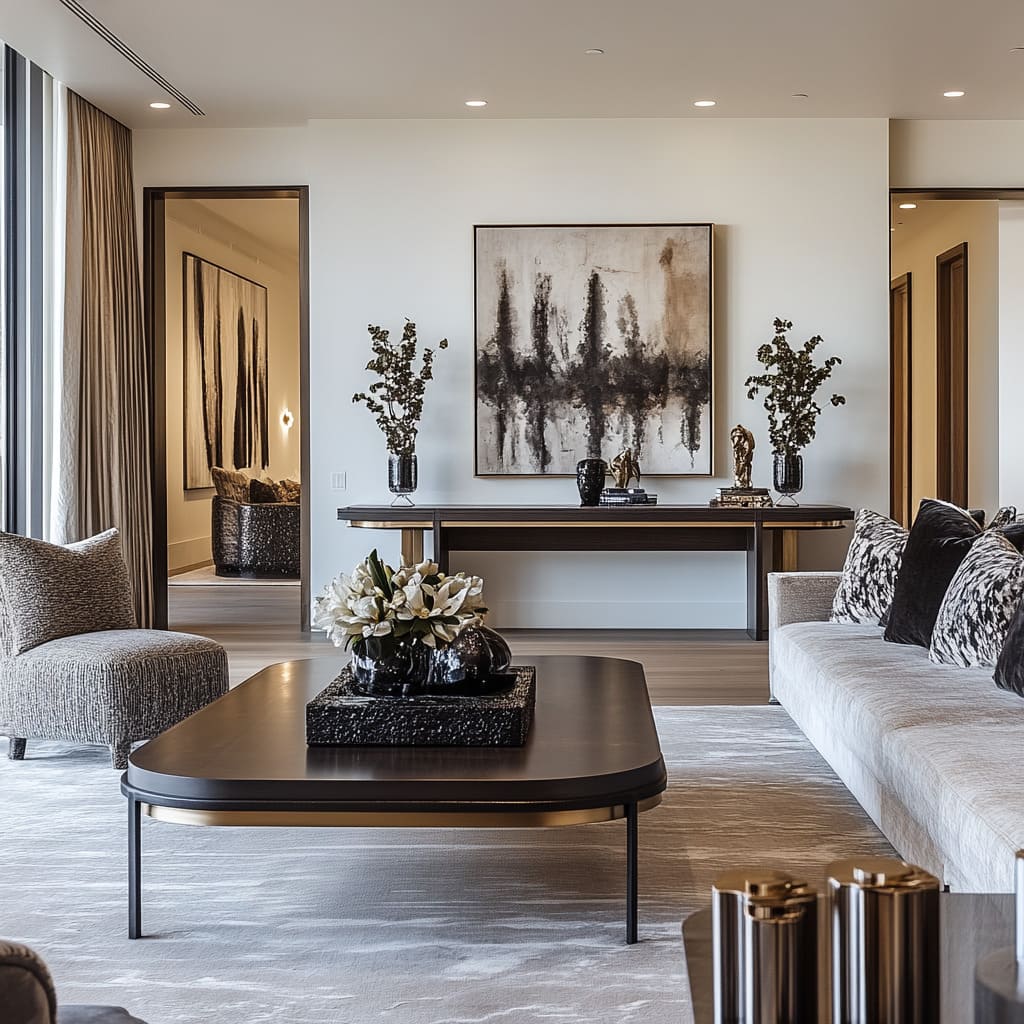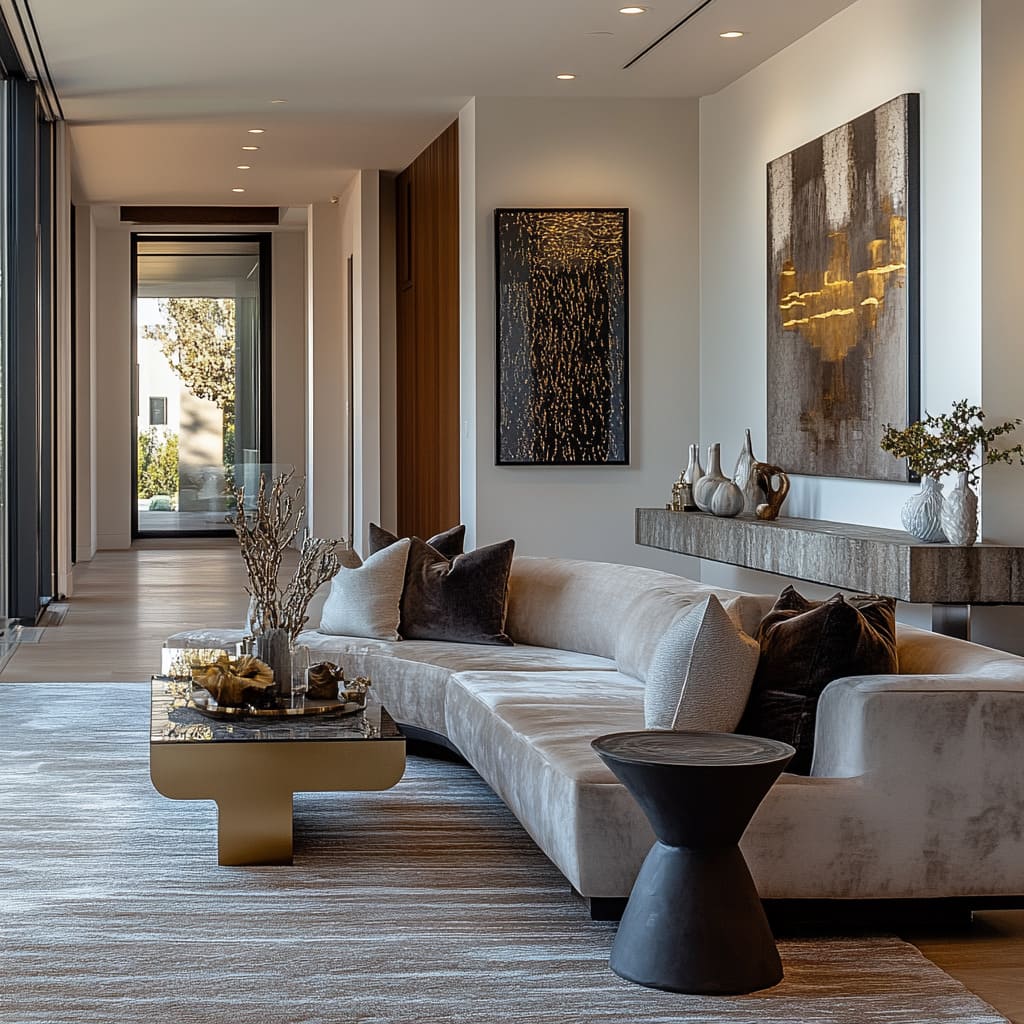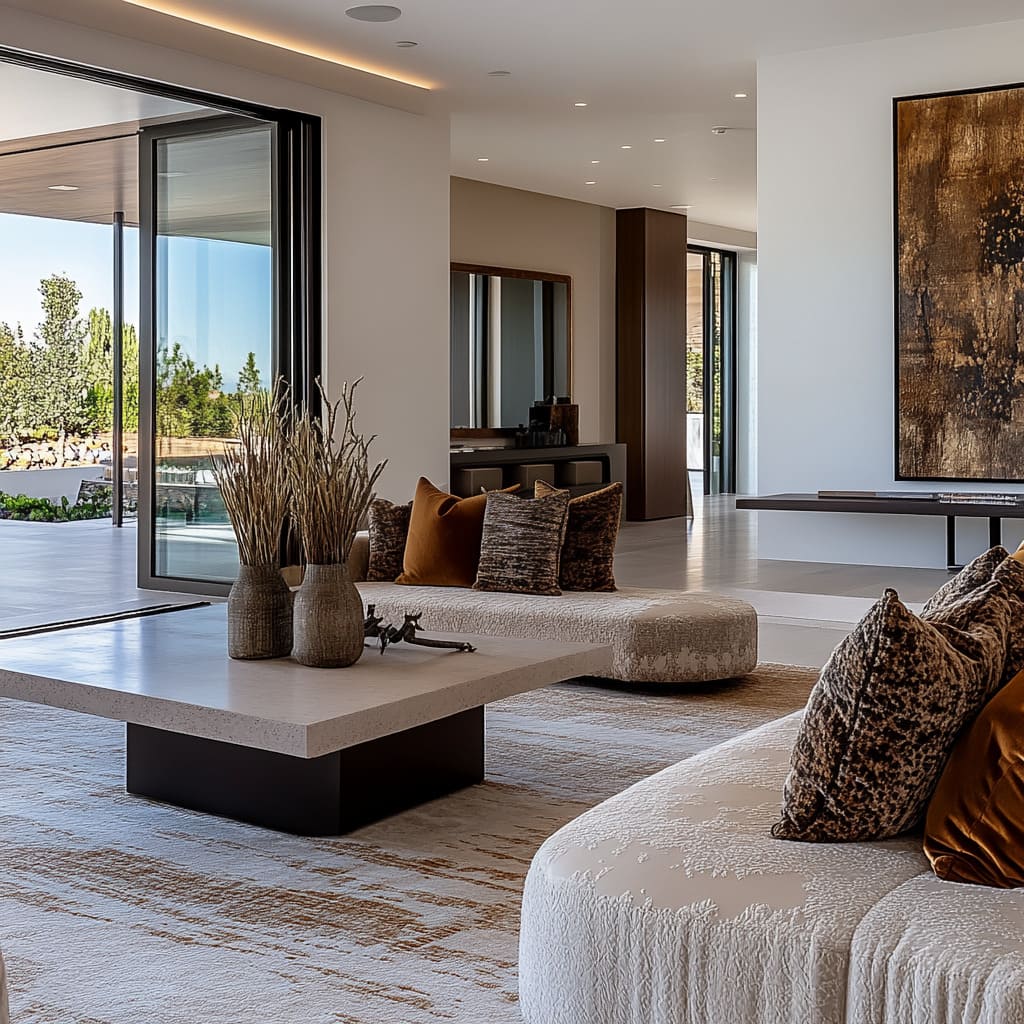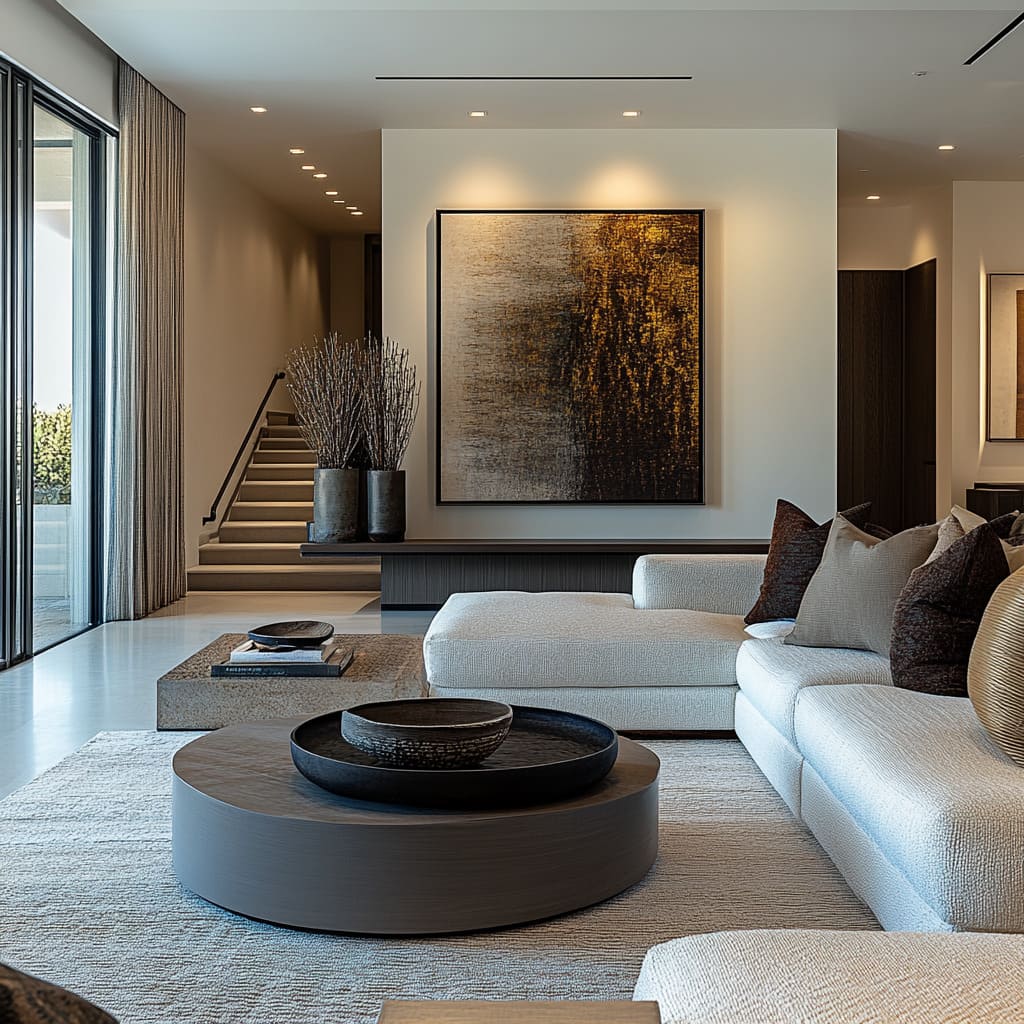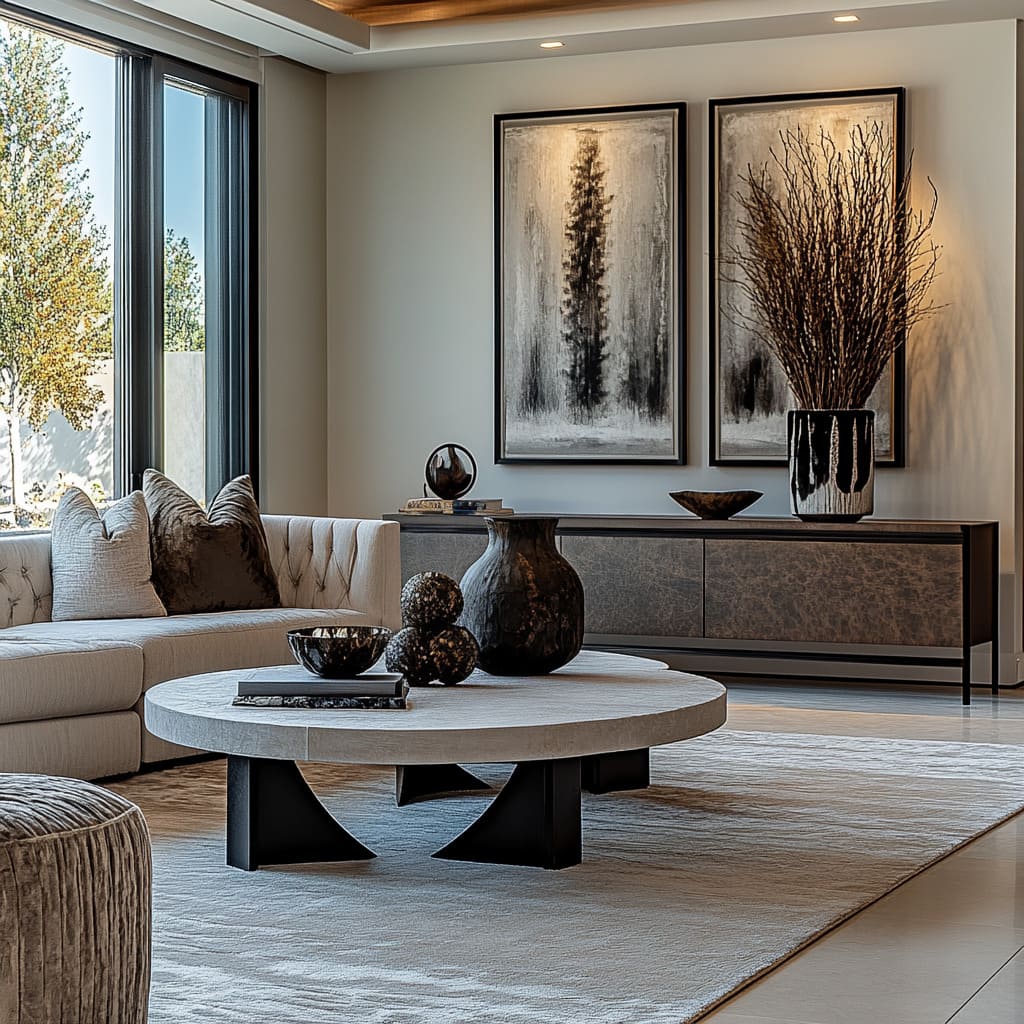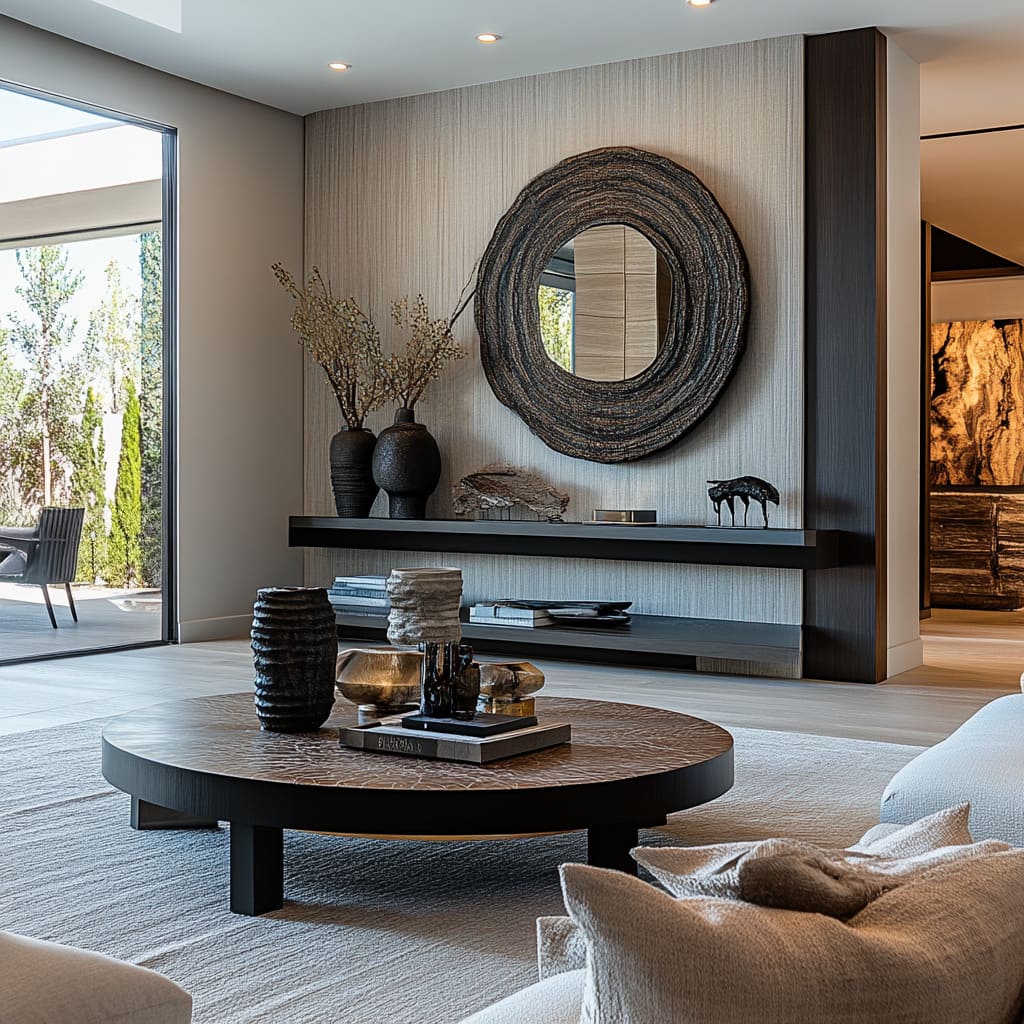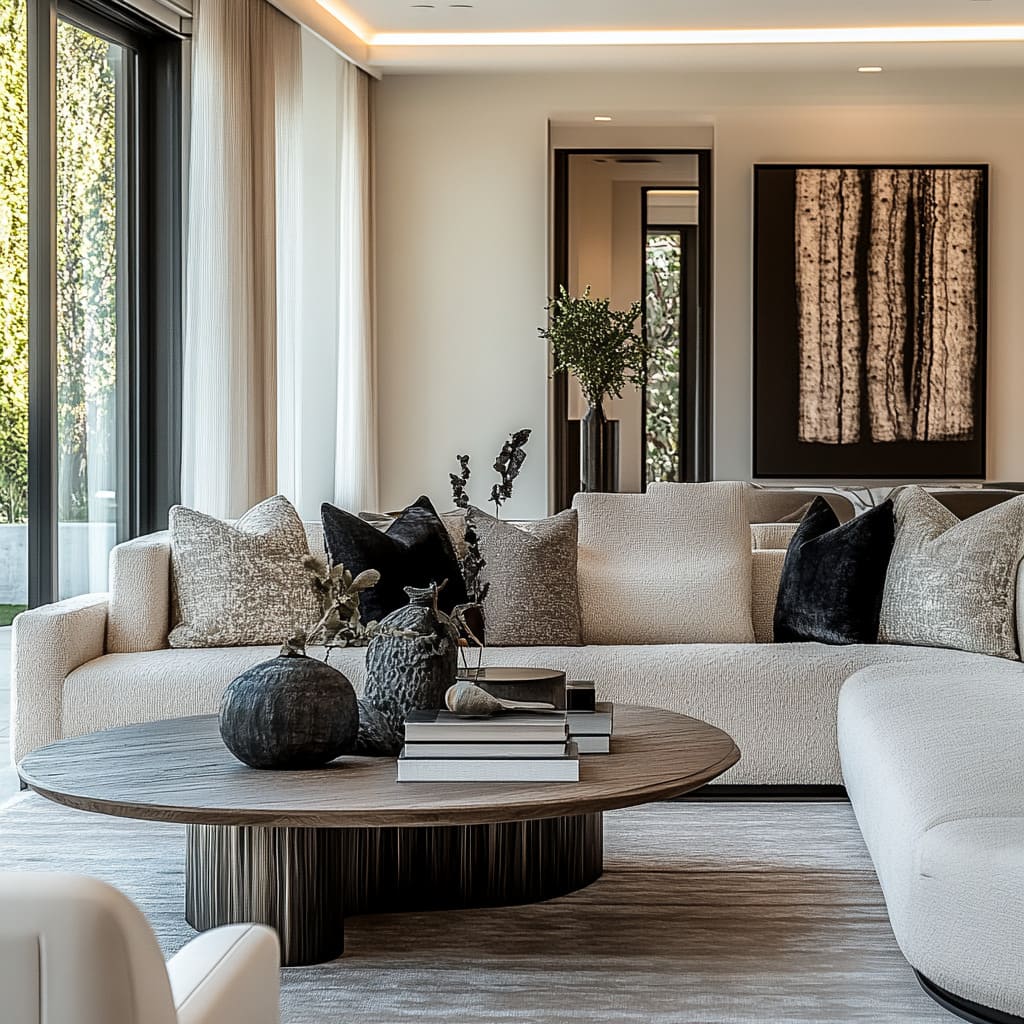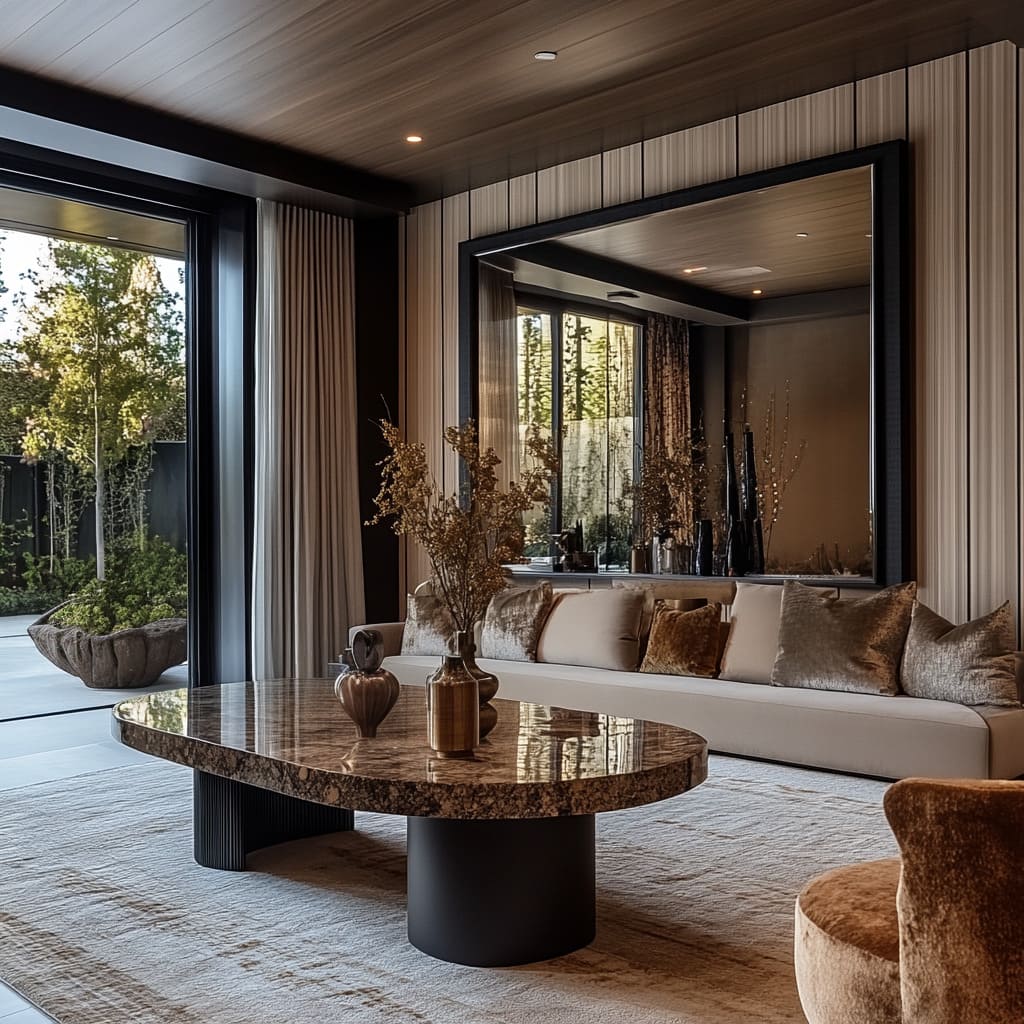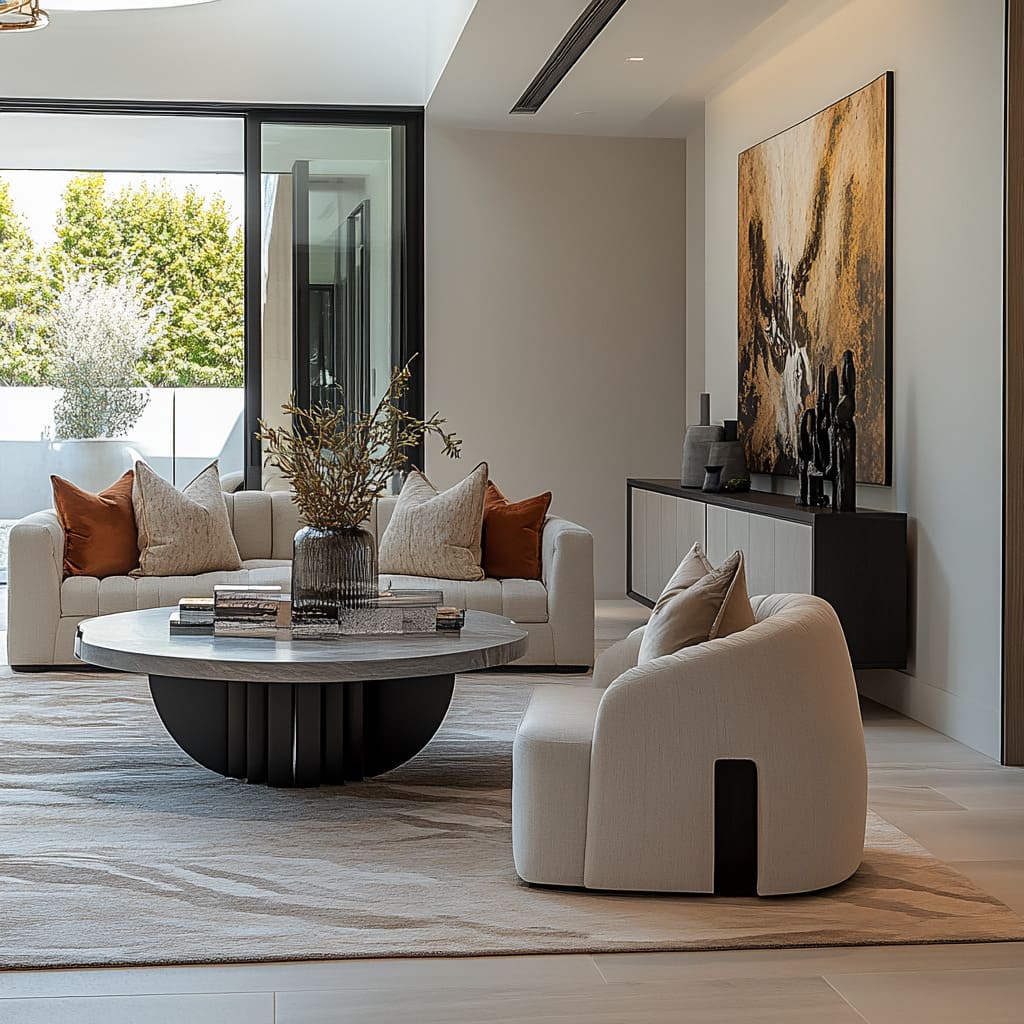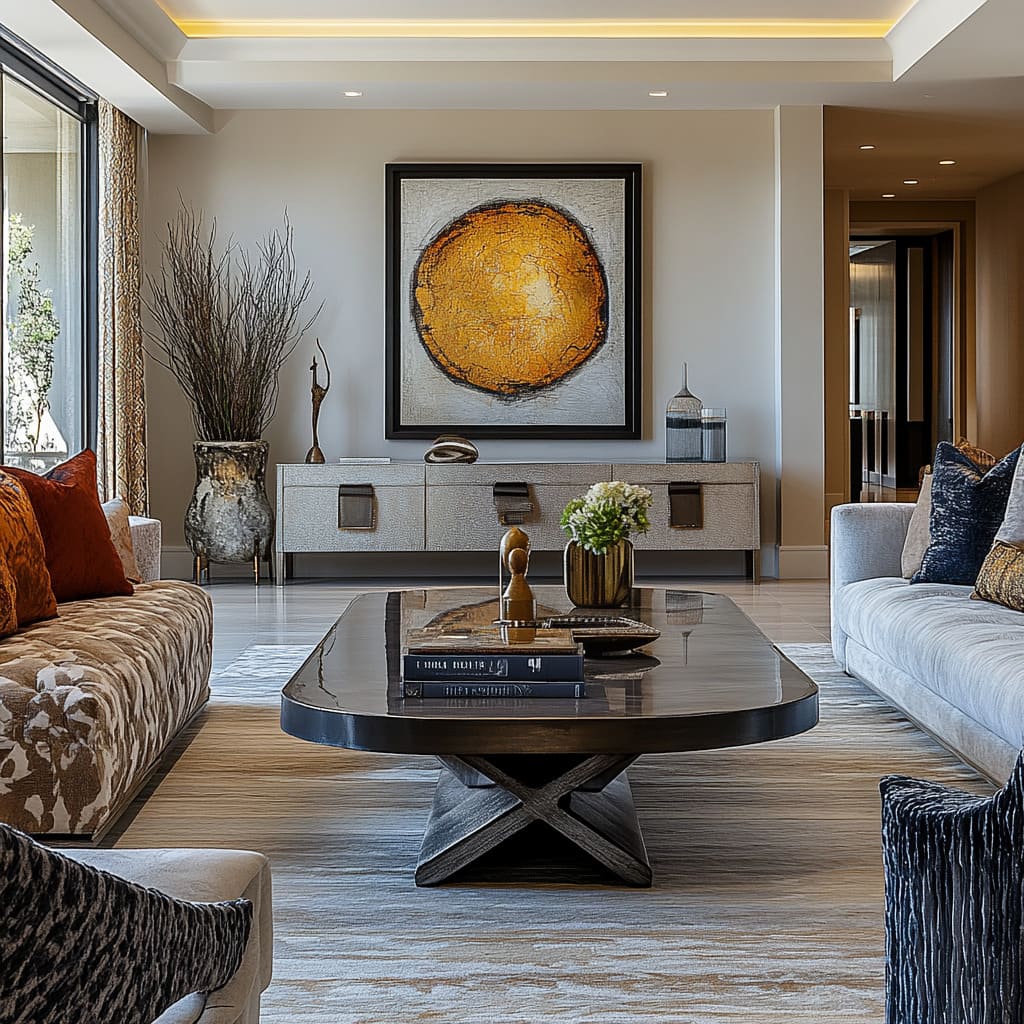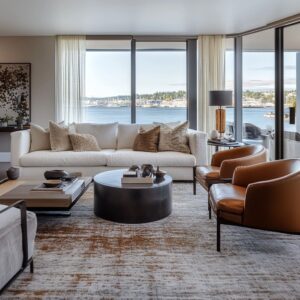Texture is a vital element in interior design that often doesn’t get the attention it deserves. While color, form, and space frequently dominate discussions about home aesthetics, texture quietly plays a significant role in shaping the look and feel of a room.
It’s the subtle differences in surfaces—whether soft or hard, glossy or matte—that create visual interest and tactile appeal. In a modern luxury living room, texture adds depth, richness, and character, transforming a flat, uninteresting space into one that feels dynamic and alive
When we talk about using textures to create depth in a living room, it’s about more than just choosing a fabric or finish. It’s about combining unexpected materials and surfaces to build a layered and cohesive environment.
The right mix of textures can turn a basic room into a sanctuary of comfort and sophistication. In a modern living room design, this approach is particularly effective, as it allows for a unique interplay between sleek, contemporary elements and more traditional, tactile features.
The result is a space that feels both current and inviting, a perfect blend of modern style and timeless comfort
Textures can transform a space in multiple ways. Visually, they catch the light differently, creating subtle shadows and highlights that add complexity to a room’s appearance.
Tactilely, they invite touch, encouraging people to engage with their surroundings. A smooth, polished marble coffee table against a plush, textured sofa invites not only visual contrast but also a sensory experience.
The balance of these contrasting elements can create a room that feels both luxurious and approachable, sophisticated yet comfortable
Understanding Texture in Interior Design
To fully appreciate the impact of texture in interior design, it’s essential to understand what texture means in this context. Texture refers to the surface quality of a material—how it feels to the touch and how it looks.
It can be soft, like a velvet cushion, or hard, like a glass table top. It can be rough, like a reclaimed wood panel, or smooth, like a polished stone floor.
Textures can also be visual, with patterns or finishes that suggest a certain feel, even if the actual surface is flat
Different textures serve different purposes in a room. Soft textures, such as cashmere throws or boucle upholstery, bring warmth and comfort, making a space feel cozy and inviting.
Hard textures, like metal or stone, provide a sense of structure and stability, grounding the room. Smooth textures, such as silk or high-gloss finishes, add a touch of refinement, while rough textures, like natural wood or woven baskets, introduce an element of earthiness and authenticity.
Glossy surfaces reflect light, brightening a space, while matte finishes absorb light, adding depth and richness
Textures don’t just work alone; they interact with light and color to create a dynamic environment. In a room bathed in natural light, textured surfaces come to life, their nuances highlighted by the changing light throughout the day.
A velvet curtain might appear deep and rich in the morning light, while a marble countertop may take on a cooler tone as the sun sets. The interplay of textures and light adds layers to the room, making it feel more substantial and engaging
The Role of Texture in Modern Luxury Living Rooms
In the realm of contemporary luxury living room ideas, texture is a key player. It contributes significantly to the room’s overall feel, adding both a sense of comfort and a touch of sophistication.
In a luxury living room, textures are carefully chosen to enhance the aesthetic and tactile experience. Think of the soft, inviting texture of a high-pile rug underfoot, paired with the sleek surface of a glass coffee table.
Or the contrast between a velvet sofa and a metal accent chair. These combinations are not accidental; they are designed to draw the eye, invite touch, and create a space that feels both luxurious and livable
A well-designed living room achieves a balance between comfort and sophistication through the strategic use of various textures. A plush velvet sofa, for example, not only adds a sense of opulence but also invites relaxation.
It pairs beautifully with the smooth, cool touch of a marble-topped side table, creating a contrast that is both visually appealing and functionally sound. Meanwhile, a hand-woven rug can anchor the space, adding a soft, tactile element that grounds the room.
These elements together create a layered look that feels both rich and welcoming
Luxury textures like velvet, boucle, and polished marble are often used in modern living rooms to add depth and character. Velvet is a favorite for its soft hand feel and its ability to reflect light, giving it a slightly luminous quality.
Boucle, with its nubby texture, adds a cozy, tactile element that contrasts well with smoother surfaces. Polished marble, with its natural veining and cool, smooth finish, adds a timeless elegance that instantly elevates a space.
Natural wood, with its inherent warmth and varied grain patterns, adds an organic touch that softens more contemporary elements, providing balance and harmony in the design
In conclusion, texture is an essential tool in creating depth and interest in a modern luxury living room. It adds layers of visual and tactile richness that make a room feel complete and inviting.
By thoughtfully combining different textures—soft with hard, glossy with matte, smooth with rough—designers can create spaces that are not only visually stunning but also deeply satisfying to experience
Key Textures in Modern Luxury Living Rooms
In the world of interior design, texture plays a crucial role in defining the feel and depth of a space. In modern luxury living rooms, textures are used strategically to create layers of visual and tactile interest.
By combining various materials—each with its unique surface quality—designers craft spaces that are both stylish and comfortable. In this section, we explore the key textures mentioned in the previous descriptions and how they contribute to the richness and character of a modern luxury living room
Plush and Tactile Upholstery
Plush and tactile upholstery is a cornerstone of any luxurious living room. The use of rich fabrics such as boucle, velvet, and linen on sofas and cushions brings a sense of warmth and comfort that invites relaxation.
Boucle, with its looped yarns, creates a soft, nubby texture that adds dimension to furniture pieces. It is often used in upholstery for its unique ability to balance softness with durability, making it perfect for luxury modern living room furniture that must withstand daily use while retaining an opulent look
Velvet, on the other hand, is known for its smooth, lustrous pile that catches the light in a way that adds depth and richness to a room. The fabric’s dense weave provides a plush feel that immediately conveys luxury.
A velvet sofa, with its soft hand feel and deep color saturation, serves as a striking focal point in a living room, elevating the overall aesthetic. Linen, with its natural texture and subtle variations, brings a casual elegance that softens more formal elements.
Its breathable, organic feel adds a layer of comfort, particularly in warmer climates where a cool touch is desirable
These upholstery choices do more than just provide comfort; they also create a visual impact when paired against smooth surfaces. The contrast of a plush velvet sofa against a sleek marble coffee table, for example, highlights the qualities of each material, enhancing the overall sensory experience of the room.
This interplay between textured fabrics and smoother materials is essential in achieving a balanced design that feels both sophisticated and inviting
Organic and Raw Elements
Incorporating organic and raw elements is a powerful way to introduce texture and ground a living room in natural beauty. Materials such as rough-hewn stone, charred wood, and dried botanicals bring a sense of earthiness and authenticity that contrasts beautifully with more refined finishes.
Rough-hewn stone, with its uneven surfaces and natural variations, adds a tactile quality that evokes the rugged beauty of nature. It is often used in feature walls or fireplaces to create a focal point that feels both substantial and timeless
Charred wood, known for its rich, dark color and unique texture, adds a dramatic element to a modern living room. The process of charring wood not only enhances its durability but also brings out the natural grain patterns, adding visual interest and depth.
This texture pairs well with smoother surfaces, like a polished metal frame or a sleek glass tabletop, creating a juxtaposition that draws the eye and adds complexity to the design
Dried botanicals offer a different kind of texture—one that is more delicate yet equally impactful. Arranged in simple vases or as part of a larger installation, they add an organic softness that complements the harder, more structured elements of the room.
The use of these natural materials not only introduces texture but also creates a connection with the outdoors, bringing an earthy, grounded feel to the space
Smooth and Polished Surfaces
Smooth and polished surfaces are essential for adding a sense of sophistication and luxury to a living room. Polished marble, with its natural veining and reflective surface, is a popular choice for coffee tables, side tables, and even flooring in high-end interiors.
The smooth, cool feel of marble adds a touch of opulence, and its ability to reflect light enhances the sense of spaciousness and brightness in a room
Sleek metal finishes, such as brushed brass or stainless steel, also play a key role in luxury interiors. These metals add a subtle shine without overpowering the space, lending a modern edge to the design.
Whether used in the frame of a chair, the base of a table, or as decorative accents, metals bring a sense of precision and clarity that complements softer textures
However, the key to using smooth surfaces effectively is balance. Too many polished or reflective elements can make a room feel cold and uninviting.
By carefully balancing smooth surfaces with textured elements—like a velvet sofa or a boucle chair—a room can achieve a harmonious blend that feels both luxurious and welcoming. This approach ensures that a modern luxury living room remains dynamic and engaging, avoiding the sterile feel that can come from too many similar surfaces
Understand How Much You Can Achieve in Your Living Room with Your Budget
Wondering how far your budget will go? Whether you’re thinking of a luxurious makeover or a simple update, our tool helps you explore your options.
[budget_renovation_calculator]
Reflective and Glossy Accents
Reflective and glossy accents are the final layer in creating depth and light within a luxury living room. Mirrors, glossy metals, and glass elements are all effective tools for enhancing light and creating a sense of openness.
A large, strategically placed mirror can amplify natural light, making a room feel larger and more airy. For example, a round mirror above a console table not only serves a functional purpose but also adds a decorative element that reflects other textures and finishes within the room, creating a dynamic interplay of light and shadow
Glossy metals, such as chrome or polished brass, add a sleek, modern touch that can enhance the overall aesthetic. When used in furniture legs, light fixtures, or decorative accessories, these metals provide a striking contrast to softer, matte textures like linen or boucle.
Glass elements, whether in the form of tabletops, lighting fixtures, or decorative objects, further contribute to this effect by introducing transparency and lightness, helping to balance heavier, more solid elements
The use of reflective surfaces, therefore, is not just about adding shine; it’s about amplifying the room’s existing qualities. By reflecting light, these surfaces help to brighten the space and create a sense of depth, making the room feel more spacious and open.
This strategy is particularly effective in smaller spaces or in rooms with limited natural light, where reflective surfaces can help to enhance the sense of volume and light
By thoughtfully combining these key textures—plush upholstery, organic materials, smooth surfaces, and reflective accents—designers can create a modern luxury living room that feels layered and rich. These elements work together to add depth, comfort, and a sense of refined elegance, resulting in a space that is as welcoming as it is stylish.
Whether exploring modern luxury living room ideas or selecting luxury modern living room furniture, the careful consideration of texture will always be a central element in crafting a truly luxurious interior
Designing with Contrast and Complement
Creating a luxurious and visually engaging living room goes beyond simply selecting beautiful pieces. The true art of design lies in the ability to contrast and complement different textures, materials, and colors.
This interplay of elements not only adds visual interest but also brings depth and character to the space. In a modern luxury living room, the strategic use of contrasting textures can transform an ordinary room into an extraordinary one, making it feel more dynamic and layered.
This section explores the importance of contrast, techniques for pairing textures, and the role of color in enhancing texture perception
The Importance of Contrasting Textures
In interior design, contrast is key to creating a room that feels rich and multidimensional. When textures contrast—think of the interplay between a soft velvet sofa and a rough stone wall—they create a visual tension that draws the eye and invites exploration.
This contrast adds depth, making the space feel more engaging and alive. In a luxury modern living room, contrasting textures are not just about aesthetics; they are about creating an experience.
They invite touch, encourage comfort, and visually narrate the sophistication of the room
Contrasting textures serve multiple purposes. They can delineate different areas within a room, highlight architectural features, or simply add a layer of complexity that makes the space feel thoughtfully curated.
For example, pairing smooth leather with a woven rug introduces a tactile variety that prevents the room from feeling flat or monotone. The juxtaposition of different textures also adds warmth and character, essential qualities for any modern living room aiming to achieve both style and comfort
Techniques for Pairing Different Textures
Successful interior design involves carefully pairing textures to complement each other while still allowing each to stand out. The goal is to create a balanced composition where each texture enhances the others, rather than competing with them.
One effective technique is to start with a dominant texture that sets the tone for the room—such as a plush velvet on a statement sofa—and then layer in complementary textures that provide contrast and support the overall theme
For example, a modern living room might feature a central piece of modern luxury living room furniture—like a sleek, low-profile sofa in a soft, tactile fabric. Around this, designers might introduce a high-gloss marble coffee table and a rustic wooden side table.
The marble adds a touch of refinement and brightness, while the wood brings warmth and an organic feel. This combination of materials ensures that the room feels layered and cohesive, with each element enhancing the others
Another technique involves using textures to create visual pathways or focal points within the room. For instance, a rough-textured rug can anchor a seating area, while smooth metal light fixtures draw the eye upward, highlighting the height and openness of the space.
By strategically placing different textures, designers can guide the eye and create a sense of movement and flow throughout the room
Contrast Between Soft and Hard Textures
One of the most effective ways to create depth and interest in a modern living room is by pairing soft and hard textures. Soft fabrics, such as velvet and boucle, are naturally inviting and add a sense of warmth and comfort.
These materials are ideal for larger furniture pieces like sofas and armchairs, where their plush feel can be fully appreciated. On the other hand, harder surfaces like stone and metal introduce a sense of structure and stability, balancing the softness with a more grounded feel
When these textures are paired together, they create a look that is both balanced and dynamic. For example, a velvet sofa’s lush, tactile quality can be beautifully offset by a sleek marble coffee table.
The velvet invites touch and relaxation, while the marble offers a cool, smooth contrast that adds a touch of luxury and refinement. Similarly, a boucle-upholstered chair paired with a metal side table creates a dialogue between comfort and sophistication, softness and structure
This contrast between soft and hard not only adds visual interest but also enhances the functionality of the room. Soft textures make the space feel welcoming and comfortable, while harder materials provide durability and ease of maintenance.
The result is a modern luxury living room that feels both stylish and practical, elegant yet livable
Balancing Natural and Modern Elements
Balancing natural and modern elements is another key strategy in creating a cohesive and engaging living room design. Natural textures, such as wood, stone, and dried botanicals, bring warmth and an organic quality to the space.
They connect the interior with the outdoors, adding an earthy, grounded feel that softens the sleekness of modern materials. In contrast, modern elements like metal and glass add a clean, refined touch, enhancing the room’s contemporary appeal
The challenge lies in blending these diverse textures in a way that feels cohesive rather than chaotic. One effective approach is to use natural elements as a foundation and layer modern materials on top.
For example, a living room might feature a stone fireplace as a central feature, with sleek metal shelving and glass-fronted cabinets flanking either side. The stone provides a sense of permanence and history, while the metal and glass add a modern twist that keeps the room feeling fresh and current
Another strategy is to use color to unify different textures. Neutral tones, such as whites, beiges, and grays, work well with a variety of textures and can help bridge the gap between natural and modern elements.
For instance, a wood coffee table in a light oak finish might be paired with a glass vase filled with dried flowers, set against a backdrop of white walls and a gray stone floor. The neutral color palette ties these different textures together, creating a harmonious look that feels balanced and intentional
The Impact of Color on Texture Perception
Color plays a significant role in how textures are perceived and can either enhance or mute their impact. A carefully chosen color palette can highlight the unique qualities of different textures, making them stand out or blend in as needed.
In a modern living room, neutral tones such as cream, taupe, and gray provide a versatile backdrop that allows various textures to shine. These colors are subtle enough not to compete with textures, allowing the richness of materials like velvet, wood, or marble to take center stage
On the other hand, bolder colors can add drama and focus to specific textures. Deep, rich hues like navy, emerald, or charcoal can make a smooth, glossy surface appear even more reflective or a soft, matte fabric feel even more luxurious.
The key is to use color strategically to draw attention to the textures that you want to emphasize. For example, a dark leather armchair against a light-colored wall will stand out more, highlighting the chair’s smooth, supple texture
When combining multiple textures in a room, it’s important to consider how their colors will interact. A cohesive color palette helps different textures complement each other rather than clash.
For instance, a combination of light-colored linen drapes, a dark wooden floor, and a polished marble coffee table works well because the neutral color palette allows each texture to be appreciated without overwhelming the space
By carefully selecting and pairing textures, and using color to enhance their qualities, designers can create a living room that is both visually striking and deeply comfortable. This thoughtful approach to texture and contrast results in a space that feels layered and rich, perfectly embodying the essence of modern luxury.
Whether exploring luxury modern living room ideas or selecting the perfect modern luxury living room furniture, the key lies in mastering the art of contrast and complement to craft a room that feels both dynamic and cohesive
The Role of Lighting in Enhancing Texture
Lighting is a powerful tool in interior design, especially when it comes to enhancing textures within a space. The way light interacts with different surfaces can dramatically change the perception of texture, adding depth and dimension to a room
In a contemporary luxury living room, the choice of lighting is as crucial as the choice of materials and furniture. Light can highlight the subtle nuances of texture, whether it’s the soft folds of velvet drapes, the rough grain of reclaimed wood, or the smooth sheen of a polished marble floor.
Understanding how to use both natural and artificial lighting effectively is key to creating a sophisticated and inviting atmosphere
Discussion on How Lighting Affects the Perception of Texture
Texture in interior design isn’t just about how something feels—it’s also about how it looks. Lighting plays a vital role in defining and emphasizing these textures.
Direct light can cast shadows that reveal the depth and dimension of a textured wall, while soft, diffused light can enhance the plushness of a velvet sofa. The interplay between light and shadow creates visual interest and can make even the most subtle textures stand out
In a modern mansion living room, where luxury and comfort are paramount, lighting helps to create a dynamic and layered environment. The reflective surfaces of polished marble or metallic finishes can bounce light around the room, creating a lively and ever-changing play of light.
Meanwhile, softer, more absorbent textures like linen or boucle can provide a counterbalance, absorbing light and adding warmth. By thoughtfully selecting and placing light sources, designers can manipulate how textures are perceived, making the room feel more inviting and alive
The Use of Natural Light vs. Artificial Lighting to Highlight Different Textures
Natural light is one of the most effective tools for showcasing textures.
It changes throughout the day, casting different shadows and highlights that can bring out the best in a room’s design. Floor-to-ceiling windows, as mentioned in the descriptions, are a popular feature in contemporary luxury spaces.
They flood the room with daylight, enhancing the textures of fabrics, woods, and other materials. For example, the natural grain of a wooden floor or the intricate weave of a textile becomes more pronounced under natural light, adding character and depth to the room
Artificial lighting, on the other hand, offers more control and flexibility. It can be strategically placed to highlight specific areas or features within a room.
Recessed lighting can wash walls with a soft glow, accentuating their texture, while directional spotlights can focus on artwork or architectural details, casting dramatic shadows that add to the room’s depth. Cove lighting, hidden in the recesses of a ceiling or behind a wall panel, can create a warm, ambient light that softly illuminates textured surfaces, making them appear more vibrant and tactile
Layered Lighting for Textural Depth
To truly enhance texture, it’s important to use a layered lighting approach. Layered lighting combines ambient, task, and accent lighting to create a dynamic and versatile environment.
Each layer serves a specific purpose and, when combined, can dramatically impact the perception of texture in a room
Ambient lighting is the general lighting of a room and provides overall illumination. It’s often achieved through ceiling fixtures, recessed lights, or large, open windows.
In a luxurious living room, ambient lighting sets the tone, creating a warm and welcoming atmosphere that invites guests to explore the space
Task lighting focuses on specific areas where more concentrated light is needed, such as reading nooks or above a kitchen island. In a living room setting, task lighting can be used to highlight a textured wall or an area with a particular material that deserves attention.
A floor lamp with a directional shade, for example, can cast light directly onto a boucle armchair, emphasizing its soft, nubby texture
Accent lighting is used to draw attention to specific objects or architectural features, such as a piece of art, a unique material, or a textured wall. This type of lighting often comes from track lights, spotlights, or wall sconces.
In a contemporary luxury living room, accent lighting might be used to highlight a stone wall or a sculptural piece of furniture, casting shadows that bring out the texture’s depth and complexity
Examples from the descriptions, such as recessed lights and cove lighting, illustrate how these lighting fixtures can be strategically placed to enhance textures. Recessed lights, installed in a ceiling or wall, can direct light down or across textured surfaces, making them stand out.
Cove lighting, which is hidden in a ceiling recess or behind a wall panel, casts a soft, indirect light that highlights textures subtly, making them appear richer and more dynamic
Natural Light as a Design Element
Natural light is not just a source of illumination; it is a design element in its own right. Maximizing natural light is essential in showcasing textures, as it brings out the true color and texture of materials.
The play of sunlight on different surfaces creates patterns of light and shadow that can change throughout the day, giving the room a dynamic quality
In the descriptions, the use of floor-to-ceiling windows is a common feature in luxury living rooms. These windows allow for an abundance of natural light, which enhances textures and makes the space feel open and airy.
Reflective surfaces, such as glossy tables or metallic decor, can amplify this natural light, bouncing it around the room and creating a bright and welcoming atmosphere
By placing textured elements, such as a plush sofa or a woven rug, near natural light sources, designers can ensure that these materials are highlighted. The changing light throughout the day can make these textures appear different from morning to evening, adding a sense of movement and life to the room
In conclusion, lighting is a powerful tool in enhancing the perception of texture in a modern luxury living room. By carefully balancing natural and artificial light, and using layered lighting techniques, designers can create a space that feels both dynamic and luxurious.
Whether through the use of ambient, task, or accent lighting, or by maximizing natural light, the right lighting choices can make textures come alive, adding depth and richness to the overall design. This thoughtful approach ensures that a living room is not only visually appealing but also comfortable and engaging, perfect for both relaxation and entertainment
Find out how much your home renovation might cost with our handy budget calculator.
Simply enter some basic information, and you’ll receive a quick estimate of the potential expenses
Integrating Texture into Different Elements of the Room
Integrating texture into a living room involves more than just choosing the right materials; it’s about strategically placing and combining different textures to enhance the room’s overall aesthetic and create a balanced and inviting environment. A well-designed living room makes thoughtful use of texture across various elements—from furniture to wall treatments to decorative accessories—each contributing to the room’s depth and character.
In this section, we’ll explore how texture can be skillfully integrated into a luxury minimalist living room, ensuring that every piece and surface adds to the room’s sophistication and comfort
Breakdown of How Texture Can Be Integrated into Various Elements of a Living Room
Texture plays a significant role in defining the feel of a space. It can soften or sharpen a room’s look, add warmth, or introduce a cool, sleek vibe.
The key to integrating texture successfully is to consider each element of the room as an opportunity to add depth and interest. By layering textures thoughtfully, you can create a living room that feels cohesive and dynamic, with each piece contributing to the overall aesthetic
Furniture Selection and Arrangement
Furniture is one of the most effective ways to introduce texture into a living room. When selecting furniture for a space, it’s important to consider a mix of materials and finishes that complement one another.
For instance, pairing a velvet sofa with a leather armchair introduces both visual and tactile contrast, enriching the room’s texture palette. A soft, boucle-upholstered ottoman can provide a cozy contrast to a sleek glass coffee table, creating a balanced composition that is both comfortable and chic
The arrangement of furniture also affects how texture is perceived. Placing a textured piece, like a plush sofa, against a smooth wall enhances the sofa’s softness and makes it stand out as a focal point.
Similarly, positioning a rustic wooden side table next to a more refined piece, such as a marble-topped console, creates an interplay of textures that adds depth to the room. In a luxury modern drawing room, the careful placement of furniture allows each texture to shine while ensuring the room remains balanced and harmonious
When choosing luxury furniture, it’s crucial to think beyond aesthetics and consider how different textures will interact. A sofa with a deep, rich fabric can be paired with a lighter, airier piece, such as a woven chair, to create a layered look that feels intentional and well-thought-out.
This combination not only adds visual interest but also ensures the room feels both luxurious and welcoming
Wall Treatments and Architectural Features
Walls are often an underutilized canvas for introducing texture into a living room. Textured wall treatments, such as stone or wood paneling, can add significant depth and character to a space.
Stone paneling, for example, provides a rugged, natural texture that contrasts beautifully with smoother, more refined elements like polished metal or glass. This contrast can make the room feel more dynamic and layered
Wood paneling is another excellent option for adding texture to walls. Whether it’s a sleek, horizontal plank design that brings a modern edge or a more traditional, vertical shiplap that adds warmth, wood introduces an organic texture that can make a room feel cozy and inviting.
In a minimalist space, a single textured wall can serve as a focal point, providing visual interest without overwhelming the simplicity of the design. This approach is particularly effective in a luxury minimalist living room, where the focus is on creating a serene and uncluttered environment
Architectural features like ceiling designs and built-in elements also offer opportunities to introduce texture. A coffered ceiling, for instance, adds depth and dimension, drawing the eye upward and creating a sense of height and spaciousness.
Similarly, built-in shelves or niches with textured back panels can add subtle layers of interest, providing a backdrop that enhances the items displayed
These architectural details not only contribute to the room’s aesthetic but also play a functional role, enhancing the room’s acoustics and creating a more intimate atmosphere. By carefully selecting textured materials for walls and architectural features, designers can create a living room that feels both luxurious and welcoming, balancing form and function
Accessories and Decorative Objects
Accessories and decorative objects are the final layer in creating a textured living room. These smaller elements can have a big impact on the overall feel of the space, adding pops of texture that complement the larger furniture pieces and architectural features.
Cushions, throws, and rugs are some of the most common ways to introduce texture. A velvet cushion can add a touch of luxury to a linen sofa, while a chunky knit throw draped over a sleek leather chair provides a tactile contrast that invites touch
Decorative objects, such as vases, sculptures, and dried botanicals, also play a crucial role in adding texture. A collection of vases in different materials—like ceramic, glass, and metal—can create a varied and interesting display that enhances the room’s overall texture palette.
Dried botanicals, with their delicate, organic texture, add an earthy element that softens more polished surfaces, like a marble mantel or glass coffee table
Examples from the descriptions highlight the use of textured accessories to create focal points and add depth. A set of sculptural vases placed on a smooth, glossy console table can add a tactile dimension, while a carefully chosen rug can anchor a seating area, providing both visual and physical warmth.
By layering different textures in accessories and decorative objects, designers can enhance the room’s depth and create a space that feels rich and inviting
In conclusion, integrating texture into a living room involves thoughtful consideration of every element, from furniture to walls to accessories. By carefully selecting and placing textures, designers can create a space that feels dynamic and layered, with each piece contributing to the room’s overall aesthetic.
Whether aiming for a luxury minimalist living room or a more opulent, richly textured environment, the key lies in balancing textures to create a space that feels both luxurious and comfortable
Conclusion
Throughout this article, we’ve explored the various ways in which texture plays a pivotal role in crafting a modern luxury living room. From the selection of plush and tactile upholstery to the integration of organic and raw elements, and from the clever use of lighting to the strategic arrangement of furniture and decorative pieces, texture emerges as a fundamental tool for adding depth, warmth, and character to any space
We began by understanding the significance of texture in interior design and how different types of textures—soft, hard, smooth, rough, glossy, and matte—interact with light and color to create a dynamic environment. In a modern luxe living room, these textures are not merely aesthetic choices; they shape the room’s atmosphere and overall experience, making it both visually compelling and inviting
Moving forward, we delved into specific textures commonly found in modern luxury living rooms, such as the rich softness of velvet and boucle, the rugged beauty of natural stone and charred wood, and the sleek sophistication of polished marble and metals. Each texture brings its unique qualities, contributing to a layered and cohesive design that balances comfort with style.
We also discussed how the use of reflective and glossy accents, like mirrors and glass elements, can enhance light and create a sense of openness, further enriching the room’s depth and appeal
Lighting, both natural and artificial, was highlighted as a crucial element in enhancing textures. The interplay of natural light streaming through floor-to-ceiling windows and the subtle glow of layered artificial lighting can dramatically alter how textures are perceived, bringing out their best qualities and adding a sense of movement and life to the space
Finally, we examined how to integrate textures across various elements of a living room, from furniture selection and arrangement to wall treatments and architectural features. The careful choice of textured accessories and decorative objects can elevate the design, making it feel complete and thoughtfully curated
Texture is more than a design element; it is the soul of a modern luxury living room. It transforms a flat, lifeless space into a rich, engaging environment that invites touch and interaction.
By thoughtfully incorporating a variety of textures, from the soft and plush to the sleek and polished, designers can create a living room that feels layered and dynamic—a space that resonates with both comfort and sophistication
For those seeking modern luxury living room ideas, the key lies in embracing texture as a core component of the design process. It’s not just about choosing beautiful furniture or the latest color trends; it’s about understanding how each material and finish contributes to the room’s overall feel and using that knowledge to craft a space that is truly luxurious
In conclusion, whether you’re designing a cozy urban apartment or a sprawling modern mansion, texture is your secret weapon for achieving a look that is both timeless and contemporary. A well-textured room doesn’t just look good—it feels good, offering a sensory experience that goes beyond the visual.
So, when thinking about your next interior design project, remember to think about texture and how it can elevate your space into a modern luxe living room that exudes both warmth and style

